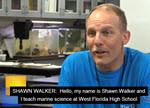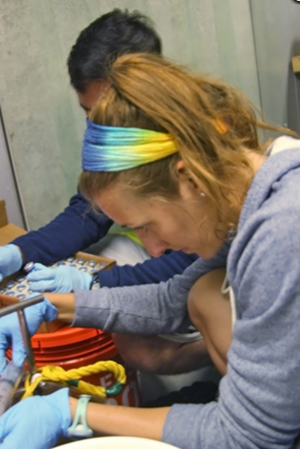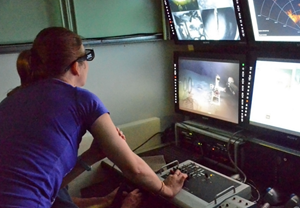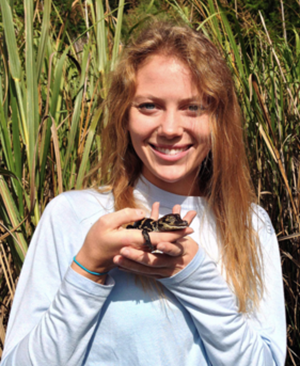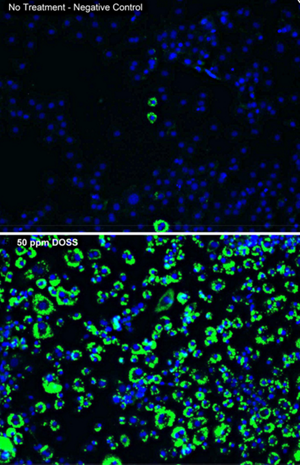 Recent research into Deepwater Horizon’s impacts on salt marsh fiddler crabs has been adapted for the journal’s Environmental Science Journal for Teens publication. The research team included researchers from two Louisiana State University-led projects (1, 2) and the Florida Institute of Oceanography.
Recent research into Deepwater Horizon’s impacts on salt marsh fiddler crabs has been adapted for the journal’s Environmental Science Journal for Teens publication. The research team included researchers from two Louisiana State University-led projects (1, 2) and the Florida Institute of Oceanography.
Tag Archives: Ecosystem
Website: Beneath the Horizon – A Web Resource for the 1979 and 2010 Oil Spills
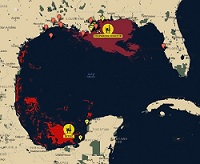
A map of the Gulf of Mexico that shows the Deepwater Horizon and Ixtoc spills. Image provided by C-IMAGE
(Click to enlarge image…)
Scientists and outreach personnel created an on-line resource that examines two major oil spills in the Gulf of Mexico: The Deepwater Horizon in the northern Gulf and the Ixtoc in the southern Gulf. The Beneath the Horizon website, developed by the Center for Integrated Modeling and Analysis of Gulf Ecosystems (C-IMAGE) research group and Jake Price Productions, explores these spills, the people who coped with and responded to these disasters, and expectations for recovery.
C-IMAGE researchers have studied the tale of these two spills since 2015 with the goal of anticipating the decadal impacts in the northern Gulf through evidence found in the southern Gulf. Beneath the Horizon’s resources take a personal look at the resilience of the people living off the Gulf’s resources.
Timelines
The Deepwater Horizon timeline shows 35 significant events from the 2010 blowout. It starts with the well explosion on April 20, 2010 then moves through events such as the unsuccessful attempts to cap the well and dispersant applications. The timeline ends with the White House Oil Commission’s determination of responsible parties on January 6, 2011.
The Ixtoc I timeline shows 10 significant events from the blowout on June 4, 1979, including unsuccessful attempts to cap the well and application of dispersant. The timeline ends with the capping of the well nine months later and the spill fate report produced on April 1, 1980 by the Mexican-owned oil company, PEMEX.
Maps
Using the interactive oil spill map, you can view and compare the extent of the spills, the areas where there was loss of recreational land use, and the locations of oiled beaches.
Historic spills from around the world are featured on the map depicting the sizes of spills, the types of oil spilled, and the ongoing impacts.
Audios/Videos
Five videos and six podcasts feature scientists who have devoted their lives to studying spills and residents who lived through them. Their first-hand accounts of experiences add the all-important human element to the research about and recovery from the Deepwater Horizon event.
Director’s Reflections
Putting together a resource like Beneath the Horizon requires getting to know the scientists who are studying these spills and the people whose lives and livelihoods were affected by these disasters. Read the director’s personal perspective of his journeys to Plaquemines Parish, Louisiana and Mexico’s Campeche, Tabasco, and Veracruz shorelines.
Learn More
- OneGulf Voyage Gathers Unprecedented Marine Samples for Two Oil Spills
- Researchers Seek New Insights from Decades-Old Spill
- Story Collider Unites Community, Research, and Restoration
************
This research was made possible in part by a grant from the Gulf of Mexico Research Initiative (GoMRI) to the Center for the Integrated Modeling and Analysis of Gulf Ecosystems II (C-IMAGE II).
The Gulf of Mexico Research Initiative (GoMRI) is a 10-year independent research program established to study the effect, and the potential associated impact, of hydrocarbon releases on the environment and public health, as well as to develop improved spill mitigation, oil detection, characterization and remediation technologies. An independent and academic 20-member Research Board makes the funding and research direction decisions to ensure the intellectual quality, effectiveness and academic independence of the GoMRI research. All research data, findings and publications will be made publicly available. The program was established through a $500 million financial commitment from BP. For more information, visit http://gulfresearchinitiative.org/.
© Copyright 2010- 2017 Gulf of Mexico Research Initiative (GoMRI) – All Rights Reserved. Redistribution is encouraged with acknowledgement to the Gulf of Mexico Research Initiative (GoMRI). Please credit images and/or videos as done in each article. Questions? Contact web-content editor Nilde “Maggie” Dannreuther, Northern Gulf Institute, Mississippi State University (maggied@ngi.msstate.edu).
RFP IV Update: Alabama Center for Ecological Resilience (ACER)
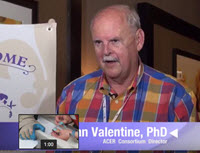
Researcher John Valentine
The ACER objectives are: To assess how coastal ecosystem structure, as measured by multiple estimates of biodiversity, and functioning (its provision of valuable processes and services) have been affected by differential exposure to Deepwater Horizon oiling. To determine how the biodiversity of coastal ecosystems can buffer resistance and recovery from oiling. To determine the conditions of disturbance that drive coastal ecosystems beyond their “tipping points,” and prevent them from returning to their pre-disturbed states.
Click for access to GoMRI’s YouTube videos of RFP-IV Project Updates…
************
This project was funded by the Gulf of Mexico Research Initiative (GoMRI) in the RFP-V funding program.
The Gulf of Mexico Research Initiative (GoMRI) is a 10-year independent research program established to study the effect, and the potential associated impact, of hydrocarbon releases on the environment and public health, as well as to develop improved spill mitigation, oil detection, characterization and remediation technologies. An independent and academic 20-member Research Board makes the funding and research direction decisions to ensure the intellectual quality, effectiveness and academic independence of the GoMRI research. All research data, findings and publications will be made publicly available. The program was established through a $500 million financial commitment from BP. For more information, visit http://gulfresearchinitiative.org/.
RFP-V Knap: Deep-sea Risk Assessment & Species Sensitivity
The Deep-sea Risk Assessment and species sensitivity to WAF, CEWAF and Dispersant project is lead by P.I. Anthony Hayden Knap, Texas A&M University.
Subsea injection of dispersants offers some significant benefits compared to the application of dispersants on the sea surface, for example access to the freshest and non-emulsified oil in the high turbulence environment, ability to reduce the volume of required dispersant by injecting it directly into the oil stream without the loss of the product, ability to operate day and night under a wider range of weather conditions, and availability of a large water mass to rapidly decrease the concentration of a dispersed oil intrusion. Although dispersant application at the sea surface has been extensively studied, more data are needed on the efficiency and environmental impacts of dispersed oil in the subsea to evaluate and document acceptability of this response technique.
We will test a series of deep sea organisms to the effect of specific individual hydrocarbons, as well as WAF, CEWAF and Dispersant. If successful, we are hoping to develop a new method for the effects of contaminants on marine organisms.
Click for access to GoMRI’s YouTube videos of RFP-V Projects…
************
This project was funded by the Gulf of Mexico Research Initiative (GoMRI) in the RFP-V funding program.
The Gulf of Mexico Research Initiative (GoMRI) is a 10-year independent research program established to study the effect, and the potential associated impact, of hydrocarbon releases on the environment and public health, as well as to develop improved spill mitigation, oil detection, characterization and remediation technologies. An independent and academic 20-member Research Board makes the funding and research direction decisions to ensure the intellectual quality, effectiveness and academic independence of the GoMRI research. All research data, findings and publications will be made publicly available. The program was established through a $500 million financial commitment from BP. For more information, visit http://gulfresearchinitiative.org/.
Fact Sheet: Sea Grant Releases Boater’s Guide on Handling Oil and Fuel Spills
The Sea Grant Oil Spill Science Outreach Team released a new informational brochure just in time for the summer boating season. The one-page guide gives boaters information on how to prepare for, respond to, and report an accidental oil or fuel spill on their vessels.
A Boater’s Guide to Handling Oil and Fuel Spills, which is available on waterproof paper, provides a list of products to prevent and/or contain leaking oil and fuel and contact information for authorities in every Gulf state.
Want a waterproof, hard copy of this guide? Contact Tara Skelton, Sea Grant Oil Spill Outreach Team member, at tara.skelton@usm.edu.
The Sea Grant Oil Spill Outreach Team synthesizes peer-reviewed science for a broad range of general audiences, particularly those who live and work across the Gulf Coast. Sea Grant offers oil-spill-related public seminars across the Gulf Coast.
Information about upcoming Sea Grant science seminars and recently-held events is available here. To receive email updates about seminars, publications, and the outreach team, click here.
************
GoMRI and the Sea Grant programs of the Gulf of Mexico (Florida, Mississippi-Alabama, Louisiana, and Texas) have partnered to create an oil spill science outreach program.
The Gulf of Mexico Research Initiative (GoMRI) is a 10-year independent research program established to study the effect, and the potential associated impact, of hydrocarbon releases on the environment and public health, as well as to develop improved spill mitigation, oil detection, characterization and remediation technologies. An independent and academic 20-member Research Board makes the funding and research direction decisions to ensure the intellectual quality, effectiveness and academic independence of the GoMRI research. All research data, findings and publications will be made publicly available. The program was established through a $500 million financial commitment from BP. For more information, visit http://gulfresearchinitiative.org/.
© Copyright 2010- 2017 Gulf of Mexico Research Initiative (GoMRI) – All Rights Reserved. Redistribution is encouraged with acknowledgement to the Gulf of Mexico Research Initiative (GoMRI). Please credit images and/or videos as done in each article. Questions? Contact web-content editor Nilde “Maggie” Dannreuther, Northern Gulf Institute, Mississippi State University (maggied@ngi.msstate.edu).
Video: Tour of the R/V Pelican
 The clip invites viewers to tour the research vessel alongside Board of Regents members and learn about the research that scientists conduct during cruises.
The clip invites viewers to tour the research vessel alongside Board of Regents members and learn about the research that scientists conduct during cruises.
Grad Student Mahmud Makes Acoustics and Tracking Marine Mammals “Click”

Sakib stands on the deck of the R/V Pelican during LADC-GEMM’s 2015 recovery cruise. (Photo by Natalia Sidorovskaia)
Environmental stressors can cause changes in the abundance and location of certain marine mammal species, which can affect future populations. Researchers can track marine mammals using the number of vocalizations or clicks picked up by acoustic monitoring systems, which can provide insights into their recovery from environmental stressors and, more broadly, deep-water ecosystem health.
Sakib Mahmud tests combinations of passive acoustic monitoring equipment to find the best method to detect and measure marine mammal populations affected by the Deepwater Horizon oil spill. His findings will help improve our understanding of long-term environmental impacts of the spill on deep-diving marine mammals and aid in improving oil spill regulations, monitoring, and mitigation efforts.
Sakib is a master’s student in the University of Louisiana at Lafayette (UL Lafayette) physics program and GoMRI Scholar with the Littoral Acoustic Demonstration Center – Gulf Ecological Monitoring and Modeling (LADC-GEMM) consortium.
His Path
Sakib’s love for nature began in his childhood home of Bangladesh, a nation whose diverse ecosystems face adverse effects of climate change. He watched documentaries to learn more about science, engineering, and conservation work aimed at protecting Earth’s creatures. “Continuously increasing natural and man-made stress endangers many animals and marine species,” he said.
Sakib’s desire to explore and protect nature led him to pursue a bachelors and his first master’s degree in physics at Shahjalal University of Science and Technology, Bangladesh. While there, he volunteered as a researcher at the Atomic Energy Establishment. He began a second masters’ degree in physics at UL Lafayette and took a research assistantship with Dr. Natalia Sidorovskaia, the director of LADC-GEMM. “[The environmental issues in Bangladesh] motivate me to engage in research here, learn, and in the future go back to my country and work there,” said Sakib. “I was always searching for an opportunity to join a community like the Gulf of Mexico Research Initiative, who is working to protect nature and endangered animals.”
His Work

Sakib presents his research at a poster session during the 2017 Gulf of Mexico Oil Spill and Ecosystem Science Conference. (Photo by Md Istiaq Hossain)
Bottom-moored buoys and autonomous surface vehicles (ASVs) are two platforms that perform passive acoustics monitoring of cetaceans; however, there has been no comparative analysis of these platforms. Sakib seeks to fill this gap by comparing data collected by a bottom-moored Environmental Acoustic Recording System (EARS) buoy and an ASV to investigate the relative detection efficiency of those platforms. The EARS buoys in Sakib’s study use LADC-GEMM’s built-in energy detector script that identifies and counts particular species’ acoustic signals to estimate their regional abundance. The ASVs use an open-source marine mammal detection software called PamGuard able to log marine mammal distribution and migration.
Sakib runs the EARS and ASV detector scripts separately to obtain comparative data from each platform. He also modified the EARS buoys’ LADC-GEMM energy detector script to be capable of processing both EARS and ASV data, which will allow him to compare the efficiency of platforms using either EARS buoys or ASVs. “We compare the number of sperm whale clicks detected per minute by each platform’s independent detectors with the modified LADC-GEMM energy detector,” said Sakib. He and his team are currently investigating the density distribution of sperm whales.
Sakib’s trials to date have shown that passive acoustics monitoring platforms using EARS buoys and ASVs have comparable efficiency. Researchers and responders will be able to use the monitoring systems that Sakib is testing to establish more accurate baseline data for regional sperm whale populations and monitor their post-spill recovery. The potential advancements to passive acoustic data collection and processing could also have broader applications identifying relationships between regional abundance variations and long- and short-term environmental factors, such as oil spills and changing weather conditions.
His Learning

(L-R) Kun Li, Natalia Sidorovskaia, Sakib, and Tingting Tang monitor acoustics signals in the R/V Pelican’s dry lab during LADC-GEMM’s 2015 recovery cruise. (Photo by Douglas Dugas)
Being a member of the LADC-GEMM research team has given Sakib the opportunity to work with leading scientists in his field, attend scientific conferences, and gain a better understanding about the research process, which he describes as a “dream come true.” He feels most honored to work alongside Sidorovskaia, whose mentorship has taught him skills from processing bioacoustics data to presenting his results. He recalls an especially memorable experience during the 2015 LADC-GEMM research cruise, “I had never seen dolphins playing in the open ocean before. While we didn’t directly see any whales, we set hydrophones and detected whales clicking in real-time throughout the whole night. It was amazing.”
His Future
Sakib plans to pursue a physics Ph.D. after completing his masters’ and use his education to improve the future conditions of Bangladesh ecosystems. He advises students considering a scientific career to explore the world around them and find a field that sparks passion. “People think scientists are all work and no fun. This is not true – we are always having fun as we discover new things about the world around us!” he said. “There are limitless possibilities with scientific research, and everyone can find an aspect of science that they enjoy.”
Praise for Sakib
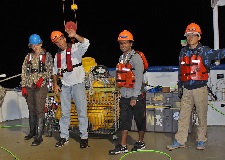
(L-R) Marah Dahn, Sean Griffin, Sakib, and Kun Li recover an EARS-Bouy during the 2016 LADC-GEMM recovery cruise. (Photo by Natalia Sidorovskaia)
Dr. Natalia Sidorovskaia described Sakib as someone who is dependable, ready to help, and independent when tackling difficult and unexplored problems. She said that he is a simultaneously adaptive and loyal person who, despite having to quickly adapt to a new educational system and new professional and secular culture, maintains admirable loyalty to the roots of his native culture and religion. She said, “He is great to work with in many settings: by a computer or on a research ship on the open ocean. I wish him the very best in attaining professional and personal horizons he dreams about and making a positive impact on science and people around him.”
The GoMRI community embraces bright and dedicated students like Sakib Mahmud and their important contributions. The GoMRI Scholars Program recognizes graduate students whose work focuses on GoMRI-funded projects and builds community for the next generation of ocean science professionals. Visit the LADC-GEMM website to learn more about their work.
************
The Gulf of Mexico Research Initiative (GoMRI) is a 10-year independent research program established to study the effect, and the potential associated impact, of hydrocarbon releases on the environment and public health, as well as to develop improved spill mitigation, oil detection, characterization and remediation technologies. An independent and academic 20-member Research Board makes the funding and research direction decisions to ensure the intellectual quality, effectiveness and academic independence of the GoMRI research. All research data, findings and publications will be made publicly available. The program was established through a $500 million financial commitment from BP. For more information, visit http://gulfresearchinitiative.org/.
© Copyright 2010- 2017 Gulf of Mexico Research Initiative (GoMRI) – All Rights Reserved. Redistribution is encouraged with acknowledgement to the Gulf of Mexico Research Initiative (GoMRI). Please credit images and/or videos as done in each article. Questions? Contact web-content editor Nilde “Maggie” Dannreuther, Northern Gulf Institute, Mississippi State University (maggied@ngi.msstate.edu).
Grad Student Morales-McDevitt Explores How Nutrients Influence Marine Snow Formation
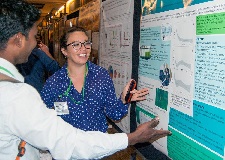
Maya presents her preliminary findings at the 2016 Gulf of Mexico Oil Spill and Ecosystem Science Conference. (Provided by Maya Morales-McDevitt)
Marine oil snow is the largest commuter of carbon to the seafloor and occurs when oil and marine particles aggregate and sink through the water column. Previous studies show that oil and dispersant significantly increased marine microorganisms’ production of exopolymeric substances (EPS), an extremely sticky goo that holds marine snow together. Maya Morales-McDevitt conducts mesocosm experiments investigating how certain naturally occurring nutrients influence EPS production and oil degradation.
Maya is a chemical oceanography student at Texas A&M University and a GoMRI Scholar with Aggregation and Degradation of Dispersants and Oil by Microbial Exopolymers (ADDOMEx).
Her Path
Maya discovered her love for the marine environment while attending a science-based high school in Mexico City, Mexico. Watching trash and oil pollutants negatively affect Mexico’s marine ecosystems broke her heart and inspired her to pursue research that demonstrates the importance of regulating oil pollution. “Oil pollution regulations aren’t very clear in Mexico,” she explained. “I wanted to contribute something that would keep the environment clean and reduce our footprint in the ocean.”
Maya’s undergraduate biology thesis at the Universidad Autónoma Metropolitana (UAM) México investigated how oil activity influences mussels. There were no active projects at the time, so she used the resources around her to conduct her own project. She asked her scuba instructor to take her on mussel-collecting excursions and washed dishes in various UAM and UNAM (Universidad Nacional Autónoma de México) laboratories in exchange for running analyses using their equipment. She presented her research at several international ecology conferences in Mexico. “When the person I was working with in Mexico put me in touch with Dr. Tony Knap, he told me to come [work in his lab], so I came,” she recalled. “Five or six months later, the ADDOMEx project started.”
Her Work
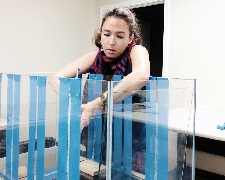
Maya builds a “baffled recirculation” tank to investigate accommodated oil fractions. (Provided by Maya Morales-McDevitt)
Maya used a 120 L tank to simulate the natural marine environment and created various mixtures of seawater, oil, dispersant. She examined each mixture once using the collected seawater’s indigenous nutrients (non-fertilized treatments) and again with added concentrations of nitrogen and phosphorus (fertilized treatments). She collected samples from each treatment and compared the differences in oil degradation, marine snow generation, and chlorophyll concentrations.
Maya observed that nitrogen and phosphorus were biodegraded at similar rates, indicating that both are important to oil degradation processes. While nutrient degradation was high across all treatments including controls, nutrient enhanced treatments exhibited greater oil biodegradation than non-fertilized treatments. She found the strongest evidence of biodegradation in the diluted and concentrated oil plus dispersant treatments from the coastal water experiments. Oil plus dispersant treatments also experienced sharp reductions in chlorophyll and exhibited the greatest amounts of marine snow.
Maya’s research suggests that adding nutrients could enhance oil’s natural removal from the water column alongside weathering processes such as marine snow sedimentation and biodegradation. Her work also supports the hypothesis that dispersant enhanced EPS production and, thus, increased marine snow. Her findings will help inform decision makers about ways to lessen oil spills’ environmental impacts. “The initial interest in marine snow and EPS was the possibility that they aided oil removal, but the new train of thought is that the excessive marine snow related to Deepwater Horizon caused more hostile effects than good ones,” she said. “In order to prevent [these hostile effects], we need to understand how it works.”
Her Learning

Maya filters 50 mL of each treatment for inorganic dissolved nutrient analyses. (Provided by Maya Morales-McDevitt)
Maya’s research showed her that scientists must consider the chemistry, physics, and biology of an ecosystem to understand it. Once their knowledge about these factors is improved, they are better equipped to find answers to their research questions. She remarked that one of the best ways to do this is to collaborate with other scientists. “We have physicists and chemists and biologists at our ADDOMEx All-Hands meetings who are all trying to solve problems. I think that has been one of my greatest experiences and the biggest lessons that I’ve learned in my master’s program,” she said.
Maya is particularly thankful for the support that she and other students received from the ADDOMEx team. She is most proud of how she and her team designed and built a baffled recirculation tank from scratch for their experiment. “It was very moving the way the PIs were always supporting us, pushing us to do more and do better and giving us all the advice that they could,” she said. One of her favorite memories is the struggle to fit fifteen researchers into the small, dark workspace surrounding the tanks. “I needed to be close to the tanks under very low light to take my samples. I ended up working in the men’s bathroom next to the dark room in order to take them! I will never forget my ‘laboratory’ in the men’s facilities,” she laughed.
Her Future
Shortly after graduating, Maya began a laboratory technician position with Texas A&M University’s Geochemical and Environmental Research Group (GERG) and hopes to begin a Ph.D. program in 2018. She says that persistence is the key to her success and advises students pursuing science to focus on their goals, even when the road is difficult. “You don’t need to be a genius or the most-outstanding student in your class, you just need to be determined,” she said. “If you fight enough, read enough, and do enough research and lab work, you will get wherever it is you want to go.”
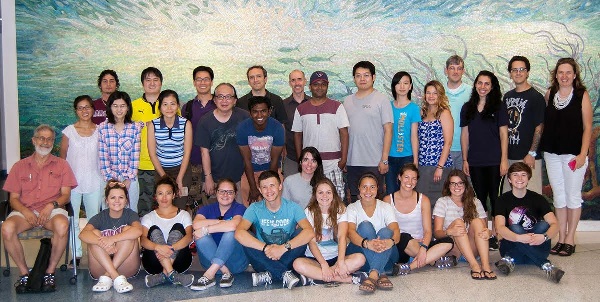
Maya and fellow ADDOMEx members on the last day of the mesocosm experiments held at Texas A&M University – Galveston in July 2016. (Provided by Maya Morales-McDevitt)
Praise for Maya
Dr. Knap reflected that Maya’s work building mesocosms and running experiments often involved late nights and long days. While working in his lab, Maya learned to operate various instruments including fluorometers, gas chromatographs, and auto-analyzers, which he said could often be a highly involved process. “Maya is a hard-worker and very cheerful individual,” he said. “She is a great team player, and it was a pleasure to have her involved with our programs at GERG.”
The GoMRI community embraces bright and dedicated students like Maya Morales-McDevitt and their important contributions. The GoMRI Scholars Program recognizes graduate students whose work focuses on GoMRI-funded projects and builds community for the next generation of ocean science professionals. Visit the ADDOMEx website to learn more about their work.
************
The Gulf of Mexico Research Initiative (GoMRI) is a 10-year independent research program established to study the effect, and the potential associated impact, of hydrocarbon releases on the environment and public health, as well as to develop improved spill mitigation, oil detection, characterization and remediation technologies. An independent and academic 20-member Research Board makes the funding and research direction decisions to ensure the intellectual quality, effectiveness and academic independence of the GoMRI research. All research data, findings and publications will be made publicly available. The program was established through a $500 million financial commitment from BP. For more information, visit http://gulfresearchinitiative.org/.
© Copyright 2010- 2017 Gulf of Mexico Research Initiative (GoMRI) – All Rights Reserved. Redistribution is encouraged with acknowledgement to the Gulf of Mexico Research Initiative (GoMRI). Please credit images and/or videos as done in each article. Questions? Contact web-content editor Nilde “Maggie” Dannreuther, Northern Gulf Institute, Mississippi State University (maggied@ngi.msstate.edu).
DEEPEND Logs DP05 Cruise Through Kids Blog
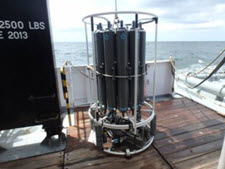 Following a short weather delay, the consortium kicked off its fifth research cruise, a two-week survey of Gulf of Mexico. The DEEPEND team has been posting updates on their progress to the project’s Kids Blog almost daily.
Following a short weather delay, the consortium kicked off its fifth research cruise, a two-week survey of Gulf of Mexico. The DEEPEND team has been posting updates on their progress to the project’s Kids Blog almost daily.
Visit the blog to catch up on the latest news.
App: RECOVER Virtual Lab (iPad + Web)
 In the wake of Deepwater Horizon, scientists have been working diligently to understand the impacts of the oil spill on the Gulf of Mexico along with the wildlife and people that depend on it.
In the wake of Deepwater Horizon, scientists have been working diligently to understand the impacts of the oil spill on the Gulf of Mexico along with the wildlife and people that depend on it.
The Relationships of Effects of Cardiac Outcomes in fish for Validation of Ecological Risk (RECOVER) consortium’s focus has been on the impacts of fish, specifically the economically and ecologically important mahi-mahi and red drum. Most of their research and experiments take place behind closed doors in laboratories with extremely controlled settings. As a result, it is not always feasible for the general public to see what happens day-to-day. RECOVER is extremely excited to bring you our solution – the RECOVER Virtual Lab. A novel approach to bring marine science into any classroom, foster STEM learning, and improve student performance in science classes.
The app allows students to analyze real data collected by consortium scientists and observe how oil-exposed mahi and redfish swim compared to unexposed control fish. Lesson plans for teachers and quizzes testing student’s performance are built-in to the app’s interface, and more experiments are in development.
The app currently contains two lessons:
- Vision Test: Students analyze data collected by researcher Jason Magnunson to see how crude oil impacts the vision of mahi-mahi, red drum, and sheepshead minnow.
- Swim Tunnel: Students use a “fish treadmill” to observe how oil impacts the swimming speeds and ability of mahi mahi.
Download the iPad app from the Apple App Store or visit http://recovervirtuallab.com/ to get started!
Oceanography Highlights Findings from Deepwater Horizon Research

Cover of the September 2016 Oceanography Magazine, Volume 29, Number 3
7th year of the largest coordinated research endeavor around an ocean event.
The 2010 Deepwater Horizon oil spill and subsequent response efforts raised concerns about impacts on the Gulf of Mexico’s ocean and coastal environments. The Gulf of Mexico Research Initiative (GoMRI), in response to the spill, initiated an unprecedented 10-year scientific research program funded by BP. Seven years into the program, we know more than ever before about the Gulf’s complex environment, dynamic processes, and response to stressors.
Oceanography magazine dedicated a special issue to this research, GoMRI: Deepwater Horizon Oil Spill and Ecosystem Science, and below are highlights from 13 papers it featured.*
WHERE OIL WENT
Surface oil covered a cumulative area of 149,000 km2 in the northeastern Gulf. Wind and currents transported surface slicks towards land, affecting approximately 1,800-2,100 km of shoreline, a third of which were moderately to heavily oiled including 1,075 km in Louisiana. Macondo oil was visually evident at the edge of Louisiana marshes and up to 10 m inland.
Subsea oil and gas rose through the water column and formed an underwater oil plume that covered an area of approximately 930 km2 and made direct contact with continental slope sediments. A significant proportion of surface oil returned to the deep seafloor primarily through an extensive marine oil snow sedimentation event known as a “dirty blizzard,” forming a 0.5-1.2 cm thick floc layer.
Cleanup efforts removed oil from 73% of beaches affected by the spill, but residual oil remained as surface residue balls (SRBs), submerged oil mats, and in marsh plants and sediment, and is subject to continued weathering, biodegradation, and possible resuspension.
HOW OIL CHANGED
Crude oils contain thousands of compounds that, upon entering a marine environment, undergo significant compositional changes from weathering processes such as evaporation, dissolution, emulsification, dispersion, sedimentation/flocculation, microbial degradation, and photooxidation.
Most crude oil compounds are readily biodegradable and generally follow a clear degradation pattern: n-alkanes first followed by branched alkanes, lower molecular weight aromatics, higher molecular weight aromatics, and cyclic alkanes. Anaerobic biodegradation is a slower process than aerobic degradation, and crude oil compounds can remain relatively unaltered in reduced sediments and environments for long time periods and may appear as relatively fresh oil compared to surface oil exposed to aerobic conditions.
MICROBIAL RESPONSE AFFECTING OIL FATE
Macondo oil had a relatively low content of persistent resins and asphaltenes, and warm temperatures supported geochemical and biological degradation. The prevalence of oil-degrading bacteria generated a prompt response from the microbial community and subsequent biodegradation. Microbial communities in the plume were different from those in non-plume waters and exhibited a significant enrichment of hydrocarbon-degrading metabolic genes. Aerobic oxidation of short chain alkanes, propane, and butane caused up to 70% of oxygen depletion observed in the oil plume.
Residual oil trapped in Pensacola Beach sands showed a progression of microbial populations linked to hydrocarbon degradation. Early-responder microbes were followed by populations capable of aromatic hydrocarbon decomposition. Microbial abundance in oiled sands was 10-10,000 times that in clean sands in the first four months after oil came ashore. A typical beach-environment microbial community returned after one year but differed significantly from pre-spill communities.
DEEP OCEAN IMPACTS
Carbon from the spill was likely incorporated into the mesopelagic (200-1,000 m depth) food web through consumption of prey rich in depleted carbon. The nature of microbial communities in the deep sea likely changed. An 80-93% decline in benthic foraminifera was related to reducing conditions and increased polycyclic aromatic hydrocarbons (PAH) concentrations.
Deepsea megafauna had lower diversity and abundance near the spill site relative to regions farther away, though blue marlin, Atlantic sailfish, blackfin tuna, and dolphinfish showed no significant reduction in larval abundance. Bottom-dwelling golden tilefish had the highest concentrations of naphthalene metabolite levels in bile measured in fishes globally. Tunas and jacks collected near the spill site exhibited developmental crude oil cardiotoxicity, suggesting a possible loss of early predator recruits that spawn in open waters. Sperm whale acoustic activity decreased near the spill site by a factor of two and increased farther away, suggesting they relocated.
Hard-bottom communities, including natural and artificial reefs, suffered injuries that were severe and long-lasting. Macrofauna and meiofauna diversity had not recovered after four years, and community structure differences still persist. Deep-sea colonial corals, in particular octocorals near the spill site, showed visible evidence of impact, and flocculent material covering the coral contained chemical fingerprints associated with Macondo oil and DOSS (dioctyl sodium sulfosuccinate). Researchers returned to these coral eight times and observed continued impacts such as tissue death with some coral skeletons secondarily colonized by hydrozoans.
Field measurements showed that planktonic community abundance and species composition returned to pre-spill conditions within a year. Laboratory experiments indicated that zooplankton exposed to sublethal crude oil levels bioaccumulated five PAHs, which could increase their susceptibility to predation and enhance trophic transfer of toxic PAHs.
MARSH IMPACTS
There were immediate negative impacts in moderately to heavily oiled marshes in southeastern Louisiana. The average concentration of total alkanes and PAHs in June 2013 was 20 and 374 times pre-oiled conditions, respectively. Total alkane concentrations were on a trajectory to be near baseline levels by 2015, but this did not occur likely a result of multiple resuspension events from storms.
Some damaged marsh shorelines showed precipitous shoreline erosion at least 2.5 years after oiling due to damaged root systems. Marshes lost due to oiling and shoreline erosion will not return without human intervention. Forty-two months after the spill, heavily oiled marshes showed near-complete plant mortality, and live aboveground biomass was 50% of reference marshes. Decreased living marsh vegetation and population levels of some fauna were obvious for 2-5 years. Meiofauna density was lower along with S. alterniflora grasses in heavily oiled areas.
Fiddler crab average size declined and there were proportion shifts in two species composition. Periwinkle snails density declined, and a slow recovery in abundance and size distribution was related to habitat recovery. Worms, seed shrimp, and mud dragons had not recovered to background levels 48 months post-spill. Killifish showed little evidence of spill impacts. Horse fly abundance declined sharply. Arthropods were suppressed by 50% in 2010 but had largely recovered in 2011. Seaside Sparrow nests on unoiled sites were more likely to fledge than those on oiled sites. Loons varied in frequency with PAHs by year and exhibited reduced body mass as PAH concentrations increased.
These effects are expected to continue – possibly for decades – to some degree, or the marsh ecosystem will reach a new baseline condition in heavily damaged areas.
FISH & SEAFOOD IMPACTS
Commercial, recreational, and subsistence fisheries were closed in fall 2010 in areas where oil was observed and predicted to travel and reopened by April 2011. Impacts on fisheries productivity were relatively short-lived, with landings and their values returning to pre-spill levels or greater for most fishery species. However, long-term effects are yet to be determined. Laboratory studies indicate that early life stages of fish are generally more sensitive to oil and dispersant’s sublethal effects (with some resulting in reduced swimming performance and cardiac function) than adults.
Public health risks from exposure to crude oil residue through seafood or coastal beaches returned to pre-spill levels after the spill dissipated. Seafood from reopened areas was found to be safe for consumption, with PAH levels comparable to those found in common local processed foods. PAH concentrations detected in many seafood samples during and following the spill were at least 2 orders of magnitude below levels of public health concern. DOSS was detected in less than 1% of samples and at levels below public health concern.
Tests on SRBs showed that Vibrio vulnificus were 10 times higher than the surrounding sand and up to 100 times higher than seawater, suggesting that SRBs can act as reservoirs for bacteria including human pathogens. Coquina clams initially showed higher PAH levels relative to the surrounding sand, but levels decreased continuously and were undetectable in sand (one year) and Coquina tissues (two years).
DISPERSANT EFFECTS & FUTURE TECHNOLOGIES
Dispersant increased the oil fraction that spread within the water column and laterally displaced oil that reached the sea surface. Dispersants reduced droplet sizes and rise velocities, resulting in a more than tenfold increase in the downstream length of the surface oil footprint.
Chemical dispersants may be more toxic to some marine organisms than previously thought, and small oil droplets created by dispersant use and directly consumed by marine organisms are often more toxic than crude oil alone. Dispersant effects on microorganisms might be taxa-specific, and some studies suggest that dispersants stimulated biodegradation while others conclude the opposite. Degradation rates of hexadecane and naphthalene were more rapid in the absence of dispersants, as was the overall removal of the water-accommodated oil fraction.
Dispersant applied at the broken riser pipe helped form a deep water oil plume. DOSS was likely transferred to the plume and was later detected in surface sediments, on corals, and within oil-sand patties.
A future option is development of plant-based materials for efficient chemical herding of compact oil slicks into layers that are sufficiently thick to enable oil burning or skimming. Opportunities exist for new dispersants that work in synergy with current dispersants and mitigate some of their disadvantages. Examples include a system containing soybean lecithin and the surfactant Tween 80, substitution of lecithin for DOSS, and using carbon-based particles and silicas to stabilize emulsified droplets. Laboratory research needs to be conducted at concentrations and under conditions relevant to marine environments.
MODELING CAPABILITIES
Model improvements provide a better understanding of droplet formation in the turbulent plume above the wellhead. No model during the spill could predict droplet size distribution, which dictates rise times, dissolution, and biodegradation. Oil spill models now include the ability to simulate the rise of a buoyant oil plume from the seabed to the surface. Consideration of oil’s 3D movement permits the prediction of oil spreading through subsurface plumes. Our understanding of the near-surface oceanic layer and atmospheric boundary layer, including the influences of waves and wind, has also improved.
Oil spill modeling routines will likely be included in Earth system models, linking physical models with marine sediment and biogeochemical components. Advances in coupled nearfield-farfield dynamic modeling together with real-time, seven-day circulation forecasts allow for near-real-time tracking and forecasting of oil dynamics. This is the most promising approach for rapid evaluation of blowout predictions to support first response decisions.
* Overton, E.B., T.L. Wade, J.R. Radović, B.M. Meyer, M.S. Miles, and S.R. Larter. 2016. Chemical composition of Macondo and other crude oils and compositional alterations during oil spills. Oceanography 29(3):50–63
Socolofsky, S.A., E.E. Adams, C.B. Paris, and D. Yang. 2016. How do oil, gas, and water interact near a subsea blowout? Oceanography 29(3):64–75
Passow, U., and R.D. Hetland. 2016. What happened to all of the oil? Oceanography 29(3):88–95
Özgökmen, T.M., E.P. Chassignet, C.N. Dawson, D. Dukhovskoy, G. Jacobs, J. Ledwell, O. Garcia-Pineda, I.R. MacDonald, S.L. Morey, M.J. Olascoaga, A.C. Poje, M. Reed, and J. Skancke. 2016. Over what area did the oil and gas spread during the 2010 Deepwater Horizon oil spill? Oceanography 29(3):96–107
John, V., C. Arnosti, J. Field, E. Kujawinski, and A. McCormick. 2016. The role of dispersants in oil spill remediation: Fundamental concepts, rationale for use, fate, and transport issues. Oceanography 29(3):108–117
Passow, U., and K. Ziervogel. 2016. Marine snow sedimented oil released during the Deepwater Horizon spill. Oceanography 29(3):118–125
Tarr, M.A., P. Zito, E.B. Overton, G.M. Olson, P.L. Adhikari, and C.M. Reddy. 2016. Weathering of oil spilled in the marine environment. Oceanography 29(3):126–135
Joye, S.B., S. Kleindienst, J.A. Gilbert, K.M. Handley, P. Weisenhorn, W.A. Overholt, and J.E. Kostka. 2016. Responses of microbial communities to hydrocarbon exposures. Oceanography 29(3):136–149
Rabalais, N.N., and R.E. Turner. 2016. Effects of the Deepwater Horizon oil spill on coastal marshes and associated organisms. Oceanography 29(3):150–159
Murawski, S.A., J.W. Fleeger, W.F. Patterson III, C. Hu, K. Daly, I. Romero, and G.A. Toro-Farmer. 2016. How did the Deepwater Horizon oil spill affect coastal and continental shelf ecosystems of the Gulf of Mexico? Oceanography 29(3):160–173
Buskey, E.J., H.K. White, and A.J. Esbaugh. 2016. Impact of oil spills on marine life in the Gulf of Mexico: Effects on plankton, nekton, and deep-sea benthos. Oceanography 29(3):174–181
Fisher, C.R., P.A. Montagna, and T.T. Sutton. 2016. How did the Deepwater Horizon oil spill impact deep-sea ecosystems? Oceanography 29(3):182–195
Dickey, R., and M. Huettel. 2016. Seafood and beach safety in the aftermath of the Deepwater Horizon oil spill. Oceanography 29(3):196–203
************
The Gulf of Mexico Research Initiative (GoMRI) is a 10-year independent research program established to study the effect, and the potential associated impact, of hydrocarbon releases on the environment and public health, as well as to develop improved spill mitigation, oil detection, characterization and remediation technologies. An independent and academic 20-member Research Board makes the funding and research direction decisions to ensure the intellectual quality, effectiveness and academic independence of the GoMRI research. All research data, findings and publications will be made publicly available. The program was established through a $500 million financial commitment from BP. For more information, visit http://gulfresearchinitiative.org/.
© Copyright 2010- 2017 Gulf of Mexico Research Initiative (GoMRI) – All Rights Reserved. Redistribution is encouraged with acknowledgement to the Gulf of Mexico Research Initiative (GoMRI). Please credit images and/or videos as done in each article. Questions? Contact web-content editor Nilde “Maggie” Dannreuther, Northern Gulf Institute, Mississippi State University (maggied@ngi.msstate.edu).
App: Virtual Lab Creates More “Wow” Moments in Science Discovery
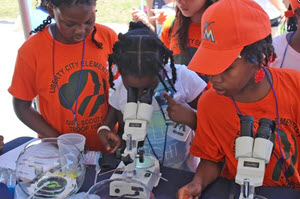
Miami Girl Scouts look at mahi-mahi embryos at an Ocean Kids outreach event. University of Miami students with the RECOVER consortium set up hands-on learning stations about the ocean. (Photo by RECOVER)
A child’s face lit up with wonder as she peered into a microscope for the first time and discovered a new world. Researchers at the Miami-based RECOVER consortium want experiences like this to happen more often for more students, so they designed and developed the RECOVER Virtual Lab. Now, scientists can engage students ages 8 and older anywhere anytime with an innovative lab experience that is accessible online and soon through the Apple App Store.
RECOVER Outreach lead Daniel DiNicola explained how the virtual lab came about, “In the consortium’s beginning, Martin Grosell [RECOVER Director] and I wanted to increase the public’s awareness and use of RECOVER’s visually-engaging experiments. We wanted something interactive that schools or public venues like museums could use.” The virtual lab is a consortium legacy product that will teach oil spill science for years to come and increases their classroom reach around the world.
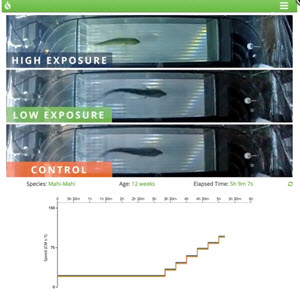
Visitors to the Virtual Lab see an experiment showing how the swimming performance of Mahi mahi are affected by different levels of oil exposure. The chart below the fish tracks performance. (Photo provided by RECOVER)
The lab’s development began in earnest using the same team that built the RECOVER website. “We liked that they already understood the research and that they work close by at the University of Miami’s main campus,” explained DiNicola. Development took about eight months and included storyboarding, wire framing, script development, filming, post production, data visualization, app design, and coding.
Internal beta testing for the virtual lab gave the RECOVER team feedback that improved science accuracy. “It was extremely beneficial to work alongside the scientists whose work is featured in the app,” said DiNicola. “The scientists offered insight and guidance that helped us refine the product and identify bugs.”
The pilot lesson, Fish Treadmills, is geared toward middle school, high school, and college students. Future lessons will include an experiment on visual acuity, fish embryonic and larval development, and social interactions. “All our lessons will feature one RECOVER graduate student acting as the virtual lab partner and explaining their research,” explained DiNicola. “We believe this is a great way for our students to practice valuable science communication skills as well as show their enthusiasm for their work.”
An evaluation component is built into the app to help determine and quantify the virtual lab’s success. Grade-specific quizzes available after every lesson will give the RECOVER team valuable insights into the lesson’s effectiveness. The demographic and location data collected by the quizzes will help identify use and participation trends. The RECOVER team hopes to publish their findings on the tool’s effectiveness using the evaluation data.
Grade-specific workbooks and transcripts for educators and students are available for download. Future plans for the virtual lab include more lessons for younger elementary students. For more information, visit the RECOVER website.
************
This research was made possible in part by a grant from the Gulf of Mexico Research Initiative (GoMRI) to the Relationship of Effects of Cardiac Outcomes in Fish for Validation of Ecological Risk (RECOVER) consortium.
The Gulf of Mexico Research Initiative (GoMRI) is a 10-year independent research program established to study the effect, and the potential associated impact, of hydrocarbon releases on the environment and public health, as well as to develop improved spill mitigation, oil detection, characterization and remediation technologies. An independent and academic 20-member Research Board makes the funding and research direction decisions to ensure the intellectual quality, effectiveness and academic independence of the GoMRI research. All research data, findings and publications will be made publicly available. The program was established through a $500 million financial commitment from BP. For more information, visit http://gulfresearchinitiative.org/.
© Copyright 2010- 2017 Gulf of Mexico Research Initiative (GoMRI) – All Rights Reserved. Redistribution is encouraged with acknowledgement to the Gulf of Mexico Research Initiative (GoMRI). Please credit images and/or videos as done in each article. Questions? Contact web-content editor Nilde “Maggie” Dannreuther, Northern Gulf Institute, Mississippi State University (maggied@ngi.msstate.edu).
Grad Student Girard Uses High-Definition Imagery to Assess Post-Spill Coral Recovery
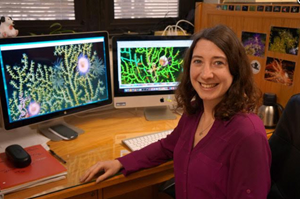
Fanny digitizes a high-definition image of an impacted coral colony to quantify impacts, growth, and recovery. (Photo by Cherisse DuPreez)
Deep-sea corals are important organisms that support a healthy and diverse deep-sea ecosystem. However, there is much we do not know about certain coral species, including how they grow, reproduce, or interact with other organisms. Fanny Girard’s research helps bridge that knowledge gap through her work on how disturbances such as oil spills affect deep-sea coral colonies and if those effects have lasting impacts. She hopes that her research will underline the need to protect these important deep-sea ecosystems.
Fanny is a Ph.D. student in Pennsylvania State University’s biology program and a GoMRI Scholar with the Ecosystem Impacts of Oil and Gas Inputs to the Gulf (ECOGIG) consortium.
Her Path
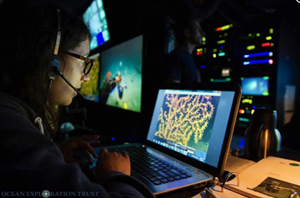
Fanny takes photos of corals in the ROV control van onboard the E/V Nautilus. (Photo credit: Ocean Exploration Trust)
Fanny grew up on the Mediterranean coast of southern France and developed a special affinity for the ocean. Her desire to work on ocean related issues started when she was eleven years old, scuba diving with her mother. While pursuing a biology bachelor’s degree at Pierre and Marie Curie University, Fanny explored marine mammal ecology during internships studying whale populations in Canada’s Gulf of St. Lawrence. Her graduate marine ecology studies at the University of Western Brittany included a course on the deep sea that inspired her to change direction. “Even though the deep sea is the largest ecosystem on earth, there is still so much to discover. That fact made me want to get involved in deep-sea research,” she said.
Fanny participated in various deep-sea research projects during her master’s work, including projects at the Institut Français de Recherche pour l’Exploitation de la Mer (IFREMER) in France and Dalhousie University in Halifax, Nova Scotia. Her master’s advisor introduced her to Pennsylvania State University’s Dr. Chuck Fisher, who offered her a Ph.D. position researching deep-sea corals for the ECOGIG project. “I had read about some of [Dr. Fisher’s work] in the Gulf of Mexico and was very excited about joining his lab,” said Fanny. “A lot of research still needs to be done to protect corals, and I really wanted to be part of this effort.”
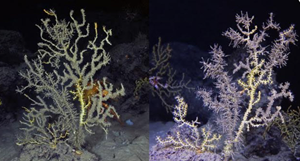
An impacted coral imaged in 2011 (left) and 2016 (right). Part of this coral has visibly recovered, but most of the colony was still heavily impacted six years post-spill. (Image by Fanny Girard)
Her Work
Natural mortality is a rare event among deep-sea octocorals, also known as sea fans, whichhave the potential to act as sentinels for anthropogenic impacts. Fanny uses high-definition imagery to assess the Deepwater Horizon oil spill’s long-term impacts on octocorals.
Since 2010, her group’s lab has been monitoring hundreds of coral colonies at oil exposed and control sites. The team collects high-definition images of the same corals every year using ROV-mounted camera equipment. Fanny digitizes the images and identifies visible impacts to coral branches, including excess mucus, bare skeletons, and secondary colonization by hydroids. She compares the annual images to assess recovery over time and identifies factors potentially influencing recovery, which helps determine if the spill had delayed or long-term effects on the coral’s health and growth.
Her analyses suggest that while lightly-impacted corals have mostly recovered, many colonies are still unhealthy with little recovery evident. While deep-sea octocorals naturally grow extremely slowly, the growth of the impacted corals was barely detectable after six years, and significantly-impacted corals have lost branches continuously since 2011. Fanny recently authored a peer-reviewed article providing evidence that brittle stars, which live on and have a symbiotic relationship with coral colonies, appeared to protect and facilitate coral recovery.
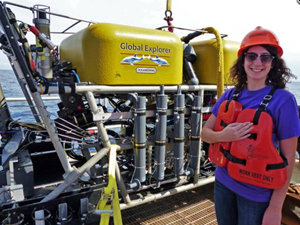
Fanny stands in front of the ROV Global Explorer after a successful dive. She uses ROVs to image corals and collect different types of samples, including coral, water, and sediment. (Photo by Cherisse DuPreez)
The slow growth rates and abnormal branch loss that their team observed could indicate a lengthy post-oil spill recovery process. Fanny created a mathematical model that uses a matrix population model to project how many branches per coral colony will present as healthy, unhealthy, or colonized by hydroids and estimate recovery time. “The model suggests that it will take decades until all remaining branches appear healthy,” Fanny explained. “It will take another century until the lost branches have regrown.” She said that the long term image-based monitoring technique used in her research is an excellent tool to identify corals that suddenly become damaged or die, indicating an environmental disturbance.
Her Learning
Fanny experienced the most scientific growth while working with her advisors, Drs. Chuck Fisher and Iliana Baums, conducting field work aboard research cruises. Since beginning her Ph.D., she has participated in at least one research cruise each year and acted as chief scientist during a 2016 cruise. She says that the interdisciplinary nature of expeditions gave her a greater appreciation for other fields and introduced her to people who share her passion for the environment. The experiences taught her important skills for conducting research expeditions, such as coordinating between scientists, crew members, and ROV teams. “Making connections is extremely important for graduate students to find employers and identify future collaborations, but it can also be very difficult,” said Fanny. “I think being part of the GoMRI science community really facilitated that process.”
Her Future
Fanny plans to continue studying the deep sea and hopes her research can help protect and restore vulnerable ecosystems. She is considering post-doc opportunities, possibly in Europe, but is willing to travel anywhere for the right project. She advises students considering a scientific career to follow their passion, even if it seems difficult. As an undergraduate student, Fanny often expressed a desire to go on expeditions and study the ocean. However, most people dismissed her goals because of limited job opportunities and advised her to pursue a more mainstream profession. “I didn’t listen, and now I’m doing what I love,” she said. “I think if you are determined and love what you are doing, you will succeed.”
Praise for Fanny
Dr. Fisher said that Fanny has been an important asset to his team’s research since her first day. He explained that she developed the research methods used to demonstrate and quantify the brittle stars’ beneficial effects on oil-impacted coral’s recovery on her own. “Fanny is a pleasure to work with and has taken our research in new and exciting directions,” he said. “Most recently, she developed a mathematical model to predict the eventual fate of long-lived corals impacted by the oil spill.”
The GoMRI community embraces bright and dedicated students like Fanny Girard and their important contributions. The GoMRI Scholars Program recognizes graduate students whose work focuses on GoMRI-funded projects and builds community for the next generation of ocean science professionals. Visit the ECOGIG website to learn more about their work.
************
The Gulf of Mexico Research Initiative (GoMRI) is a 10-year independent research program established to study the effect, and the potential associated impact, of hydrocarbon releases on the environment and public health, as well as to develop improved spill mitigation, oil detection, characterization and remediation technologies. An independent and academic 20-member Research Board makes the funding and research direction decisions to ensure the intellectual quality, effectiveness and academic independence of the GoMRI research. All research data, findings and publications will be made publicly available. The program was established through a $500 million financial commitment from BP. For more information, visit http://gulfresearchinitiative.org/.
© Copyright 2010- 2017 Gulf of Mexico Research Initiative (GoMRI) – All Rights Reserved. Redistribution is encouraged with acknowledgement to the Gulf of Mexico Research Initiative (GoMRI). Please credit images and/or videos as done in each article. Questions? Contact web-content editor Nilde “Maggie” Dannreuther, Northern Gulf Institute, Mississippi State University (maggied@ngi.msstate.edu).
Video: CWC Researchers Use GoPros to Monitor Land Loss

Photo by CWC
A recent blog post describes how consortium scientists Giovanna McClenachan and R. Eugene Turner used GoPro® cameras to photograph a study site at two-hour intervals during four- to six-week periods between August 2014 and September 2015. Read about their findings here and check out the resulting time-lapse video!
Grad Student Diamante Investigates How PAHs Affect Fish Development
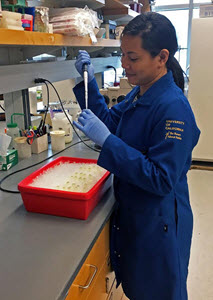
Graciel prepares zebrafish embryo samples for RNA extractions to assess gene regulation after PAH exposure. (Provided by Graciel Diamante)
Polycyclic aromatic hydrocarbons (PAHs) can disrupt important signaling pathways that transcribe genes during fish’s early embryonic development, which could cause malformations. Graciel Diamante is conducting laboratory experiments with fish embryos to understand how weathered PAHs affect fish development. She is also finding that her work demonstrates the importance of perseverance, giving back, and collaborating within a diverse scientific community.
Graciel is an environmental toxicology Ph.D. student at the University of California, Riverside (UCR) and a GoMRI Scholar with the RECOVER consortium.
Her Path
Graciel began pursuing biology as an undergraduate at California State University, Northridge (CSUN) after her enthusiastic biology professor sparked her interest in the field. She explored different research programs and worked in several labs and summer research opportunities to narrow her interests. She discovered a passion for toxicology while working on a University of California, Los Angeles summer project researching how saporin – a ribosome-inactivating protein found in soapwort plants – causes toxicity.

Graciel (left) and Norma Menjivar-Cervantes, an undergraduate at UCR, assess zebrafish embryos after PAH exposure. (Provided by Graciel Diamante)
She completed her undergraduate degree in cell and molecular biology and entered UCR’s environmental toxicology Ph.D. program. There, her interest in understanding how different compounds affect fish cardiovascular development led her to her advisor, Dr. Daniel Schlenk. Although Dr. Schlenk did not have an open position when Graciel arrived, he was impressed by her persistence and took her on as a graduate teaching assistant. She also conducted laboratory research while attending classes until Schlenk’s lab began its collaboration with the RECOVER consortium. “When the GoMRI grant came in, she was my first choice to put on as graduate student support,” said Schlenk.
Her Work
Chrysene is one of the most persistent PAHs in the water column following an oil spill and can produce oxygenated derivatives such as 2- and 6-hydroxychrysene after undergoing photo-oxidation. These hydroxylated compounds can disrupt important estrogen-signaling pathways during embryonic development, but little else is known about their toxicity. Graciel investigates the signaling pathways involved in hydroxylated PAH toxicity using zebrafish as a model for vertebrate development.
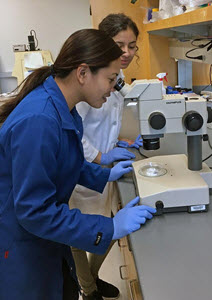
Graciel (left) and undergraduate Norma Menjivar-Cervantes use a miscroscope to assess the impacts of chemical exposure to zebrafish embryos. (Provided by Graciel Diamante)
Graciel prepares zebrafish embryos so that they are all the same developmental stage and conducts 74-hour exposure experiments using different concentrations of 2-hydroxychrysene and 6-hydroxychrysene (0.5 μM to 10 μM). Using real-time polymerase chain reaction (qPCR), she analyzes the embryos to assess the expression of certain genes that these chemicals can potentially alter and evaluate the occurrence of deformities compared to controls. She also determines the number of dead and alive embryos during the experiments.
She is observing that, unlike the parent compound chrysene, 2-hydroxychrysene and 6-hydroxychrysene exposures of at least 0.5 μM and 3 μM, respectively, increase developmental defects including cardiac, circulatory, and eye defects. The 6-hydroxychrysene concentrations of at least 3 μM decrease embryo survival, while 2-hydroxychrysene concentrations do not. Next, Graciel will conduct the same experiment using mahi mahi embryos and determine if the same effects are observed across fish species. She will use lower hydroxylated PAH concentrations and evaluate embryos for the deformities and altered transcripts found in the zebrafish experiments.
Her Learning
Graciel is an active mentor in the UCR’s Research in Science and Engineering (RISE) undergraduate program, which helps students from diverse backgrounds get involved with research. While she was an undergraduate student participating in CSUN’s Research Initiative for Scientific Enhancement program and later its Minority Access to Research Careers program, Graciel saw first-hand the impact such programs can have on a student’s professional growth. “As a mentor, I want teach them about a project’s importance, experimental design, and the ups and down of research – things you can’t learn in a classroom setting,” she said. “I want them to find what it is that inspires them, so that they can find a career they truly enjoy.”
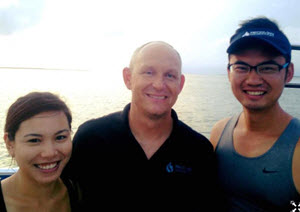
Graciel (left) with RECOVER scientists Dr. Daniel Schlenk (center) and Dr. Elvis Xu (right). (Provided by Graciel Diamante)
Graciel said that working in Schlenk’s lab during her GoMRI research taught her that science is a continual learning process. “Just as you uncover the answer to one question, another question arises.” She also learned that science pushes forward collaborations. “The importance of networking became even clearer when I joined the GoMRI community,” she said. “The RECOVER group has great scientists as well as some of the nicest people I have met.”
Living and attending school in a culturally mixed environment has helped Graciel meet and work with individuals from unique backgrounds. Cultural diversity has had an important impact on her personal maturity and shown her the importance of a diverse scientific community. She explained, “Research needs different ideas and is highly dependent on creativity and critical thinking. There is no better way to obtain this than from diverse individuals.”
Her Future
Graciel hopes to attain a post-doctoral position, continue researching fish cardiac development and physiology, and combine toxicology and developmental biology to investigate contaminants and their specific mode of action. Ultimately, she wants to become a professor and foster students’ curiosity about science and promote higher education. She suggests that students considering a science career get involved in a research project to help focus their ambitions. Gaining research experience and working in multiple labs as an undergraduate helped Graciel prepare for graduate work and her overall scientific career. “These experiences helped me figure out what my interests were and if this was the career I wanted to pursue,” she said.
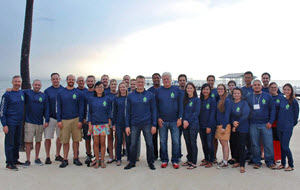
Graciel and the RECOVER team pose for a photo at a consortium All-Hands Meeting. (Photo by Daniel DiNicola)
Praise for Graciel
Schlenk said Graciel displayed a positive attitude and persevered in the face of setbacks. He explained that when the project began, it appeared that Graciel was seeing very significant effects on the fish. However, she discovered that her results were caused by a pathogen infestation in the animal model, not the chemicals she was testing. Rather than giving up, Graciel quickly began preparations to repeat the experiment. “She spent almost a whole year on her project and had to repeat everything all over again using a different animal,” he said. “So many students say ‘tell me the easy way out’ and she’s never ever asked that. It’s been neat to see her develop through this project so that she knows now what studies to do and what end points to look at. It’s very encouraging for me as a mentor.”
Schlenk explained that Graciel is a first-generation college student and that her passion for education and women in science is evident in mentoring female undergraduate students. Schlenk believes that the students’ increasing excitement about science and research is due to Graciel’s mentorship. “It’s wonderful that she’s able to touch students’ lives,” he said. “I think she’s so grateful for the opportunities she’s had that she wants to show her gratitude by doing the same things for younger students – kind of passing the torch.”
Schlenk also discussed Graciel’s personal interactions in the lab, describing her as “the mom in the group,” helping out and taking care of issues without complaint. He concluded, “She’s just a wonderful, caring person who wants to do the right thing. It’s so refreshing.”
The GoMRI community embraces bright and dedicated students like Graciel Diamante and their important contributions. The GoMRI Scholars Program recognizes graduate students whose work focuses on GoMRI-funded projects and builds community for the next generation of ocean science professionals. Visit the RECOVER website to learn more about their work.
************
The Gulf of Mexico Research Initiative (GoMRI) is a 10-year independent research program established to study the effect, and the potential associated impact, of hydrocarbon releases on the environment and public health, as well as to develop improved spill mitigation, oil detection, characterization and remediation technologies. An independent and academic 20-member Research Board makes the funding and research direction decisions to ensure the intellectual quality, effectiveness and academic independence of the GoMRI research. All research data, findings and publications will be made publicly available. The program was established through a $500 million financial commitment from BP. For more information, visit http://gulfresearchinitiative.org/.
© Copyright 2010- 2017 Gulf of Mexico Research Initiative (GoMRI) – All Rights Reserved. Redistribution is encouraged with acknowledgement to the Gulf of Mexico Research Initiative (GoMRI). Please credit images and/or videos as done in each article. Questions? Contact web-content editor Nilde “Maggie” Dannreuther, Northern Gulf Institute, Mississippi State University (maggied@ngi.msstate.edu).
RFP-V Thomas: Building a Benthic Genome Database for Improved Oil Spill Monitoring

Image of meiofaunal eukaryotes (Credit to Larry Hyde)
Meiofauna are invertebrate organisms that live in seafloor sediments. These marine creatures perform ecosystem functions such as trophic transfer, biogeochemical cycles, pollution removal, and sediment transport stability. Sensitive to environmental events such as oil spills, meiofauna are valuable bioindicators of impacts from contamination. However, their small size and our limited knowledge about these organisms’ community structure and taxonomy makes it difficult to track and characterize oil’s impacts.
The Gulf of Mexico Research Initiative recently awarded Dr. Kelley Thomas a grant to compile a reference genome database of benthic meiofaunal eukaryotes and establish Standard Operating Procedures (SOPs) for monitoring oil spills using bioinformatics. These tools can help researchers and responders interpret how spills might affect organisms in a particular area and how the organisms are expected to recover. “There’s so much we don’t understand about the relationship between the Gulf’s biogeochemical structure and the distribution of different taxa – we really don’t have any idea,” explained Thomas. “This information will help us better interpret the spill’s consequences and what kind of recovery will take place.”
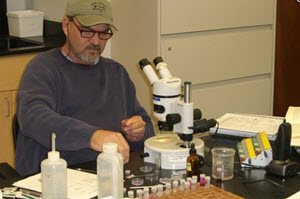
Larry Hyde reviews samples under a microscope. (Photo by Rick Kalke)
His team is analyzing as many individual benthic eukaryotes as they can using whole genome shotgun sequencing, a quick and economically-effective method for analyzing the structure of long DNA strands. The researchers are compiling the resulting data into a large database of reference genomes to identify biomarker genes based on their ability to identify changes in population and community structure. Once completed, they can sequence pre- and post-spill samples of the benthic community for the biomarker genes and identify which organisms and communities the spill impacted.
“In the mid-2000s, genetic sequencing technology rapidly advanced to allow us to run up to 200,000,000 sequences at a time when before we could only run about 100 sequences at a time,” explained Thomas. “The technology has steadily improved and gotten cheaper over time since then. That’s why today it is feasible to consider modeling the benthic Gulf of Mexico in a large-scale way just by conducting DNA sequencing and analyses.”
The project is also developing clear and concise SOPs for using the genome database to conduct environmental and oil spill monitoring. The open-source SOPs will target researchers without previous genomics experience to help train future scientists to understand the communities’ sediment biology and conduct big data analyses using bioinformatics. An annual workshop will introduce undergraduate and graduate students to the SOPs, from sample preparation to interpreting metagenomics and implementing bioinformatics.
“It’s not just microscopes anymore. Most of a researcher’s time is spent in front of a computer,” said Thomas. “The skills taught in this training will have more biological and environmental applications than just learning how to analyze Gulf of Mexico data.”
Thomas’s team is enthusiastic about the potential of their project’s products to offer analytic tools and facilitate academic progress in the field of biology. They hope to fill gaps in the current understanding of benthic eukaryote taxa, including information about their roles in the environment, their interactions, and even their viral histories. He explained that his team is very interested in the possibility of combining their work with that of other GoMRI projects. For example, combining their findings with the ongoing effort to describe the Gulf’s biogeochemistry and other such patterns and trying to link it to organismal patterns.
“We’re not just developing a practical resource. I believe that this database is going to contribute to and make a substantial impact on biology,” said Thomas. “This is going to be the way people will monitor those environments.”
The project’s researchers are W. Kelley Thomas of the University of New Hampshire Hubbard Center for Genome Studies, Holly M. Bik of the University of California – Riverside, and Paul A. Montagna of the Texas A&M University – Corpus Christi Harte Research Institute for Gulf of Mexico Studies. Their project is Genomic Responses to the Deepwater Horizon Event and Development of High-Throughput Biological Assays for Oil Spills.
************
The Gulf of Mexico Research Initiative (GoMRI) is a 10-year independent research program established to study the effect, and the potential associated impact, of hydrocarbon releases on the environment and public health, as well as to develop improved spill mitigation, oil detection, characterization and remediation technologies. An independent and academic 20-member Research Board makes the funding and research direction decisions to ensure the intellectual quality, effectiveness and academic independence of the GoMRI research. All research data, findings and publications will be made publicly available. The program was established through a $500 million financial commitment from BP. For more information, visit http://gulfresearchinitiative.org/.
© Copyright 2010- 2017 Gulf of Mexico Research Initiative (GoMRI) – All Rights Reserved. Redistribution is encouraged with acknowledgement to the Gulf of Mexico Research Initiative (GoMRI). Please credit images and/or videos as done in each article. Questions? Contact web-content editor Nilde “Maggie” Dannreuther, Northern Gulf Institute, Mississippi State University (maggied@ngi.msstate.edu).
Grad Student Quas Analyzes Sediment Grain Size to Characterize Oil Behavior

Dr. Ian Church trains Lauren to operate the Multibeam on the R/V Point Sur during the first leg of the CONCORDE Fall Campaign. (Photo credit: Heather Dippold)
Oil droplets can attach to tiny sediment particles suspended in the water column, causing them to sink to the seafloor where they can linger for a long time. Sediment grain size influences if and how oil droplets are resuspended into the water column. Larger particles sink faster and are more difficult to resuspend in the water column than smaller particles.
Lauren Quas uses acoustic sonar to map different sediment grain sizes and help understand and predict the behavior of oil in seafloor sediments. Knowing where different grain sizes are concentrated in the northern Gulf of Mexico seafloor can help scientists evaluate resuspension rates in those areas and estimate where oil might end up.
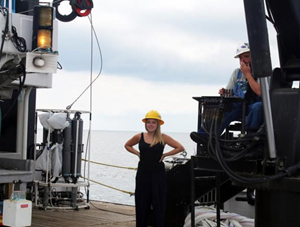
Lauren and Chief Engineer Joshua Jansen supervise the lowering of the multibeam pole into the water. (Photo credit: Alison Deary, Carla Culpepper, and Kelia Axler)
Lauren Quas is a master’s student in the University of Southern Mississippi’s Hydrographic Science program and a GoMRI Scholar with the Consortium for Oil Spill Exposure Pathways in Coastal River-Dominated Ecosystems (CONCORDE).
Her Path
As a child, Lauren loved being outdoors and collecting rocks and seashells. Her family’s vacations often involved trips to the beach, which sparked her love for the ocean. Encouraged by her parents to see the world, Lauren spent almost a decade during her high school and college years visiting countries in nearly every continent on the globe. No matter where she went, she found that the landscapes and coastlines were the most awe-inspiring parts of her travels. “It is in these places that you realize how small we are as humans and yet how big our impact is on the world,” she said.
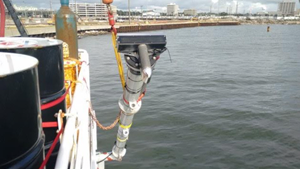
The multibeam sonar attached to the pole mount off the side of the R/V Point Sur. (Photo credit: Ian Church)
While completing her bachelor’s degree in geology at the University of Memphis, Lauren interned at the University of Memphis Groundwater Institute conducting visual stream measurements. Knowing that she wanted to pursue a career that would combine her passion for adventure and travel with her love for the ocean, she enrolled in the University of Southern Mississippi’s Geological Oceanography program. She switched her major to hydrographic science after working with her advisor, Dr. Ian Church, and seeing the career possibilities hydrography offers. She conducts studies with Dr. Church and CONCORDE’s hydrographic research team to understand the dynamics of oil and ocean sediment.
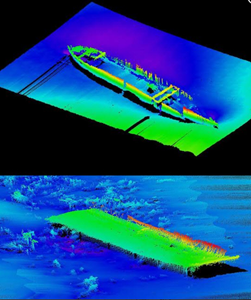
The Allen Reef Liberty Ship (above) and Casino Magic Barge (below) are examples of seafloor targets researchers can map using multibeam sonar. The sunken vessels are part of fish havens in the northern Gulf of Mexico. (Photo credit: Ian Church, Lauren Quas)
Her Work
Lauren operates a multibeam sonar to map the seafloor’s appearance and depth and quantifies the grain size of sediments using acoustic backscatter (a sound wave’s intensity after hitting the seafloor and returning to the sonar). A higher intensity return indicates that the seafloor sediment has large grain sizes, while a lower intensity return means it is composed of small grain sizes. She also collects sediment samples during research cruises using a sediment multi-corer, which removes the top 5 – 10 cm of sediment from the seabed. The sediment samples are brought back to her team’s lab at Stennis Space Center, where she analyzes them for grain size.
Lauren correlates the grain sizes depicted in the multibeam sonar data with the laboratory grain analyses to graph where different sediment sizes are located. Her sediment and backscatter data are important inputs for CONCORDE’s ocean models, which incorporate physical, chemical, and biological field data. Future scientists and responders will be able to use these models to predict and interpret how future oil spills could impact the northern Gulf of Mexico.
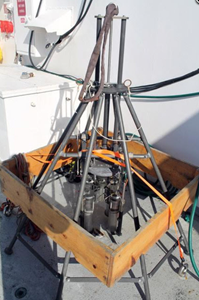
Lauren uses a multicorer like this one to collect seabed sediment samples. (Photo credit: CONCORDE)
Her Learning
Lauren’s first research cruise began two months after she entered her Hydrographic Science program. She recalled being intimidated at jumping into field work because of her limited background in hydrography. However, Dr. Church used the first leg of the cruise to teach her about the equipment and data processing programs, and Lauren then taught another student how to do so. “The knowledge I gained within such a short time is all due to the opportunities provided to me by Dr. Church and the CONCORDE project,” said Lauren. “This consortium is full of some of the most incredible, hard-working people I have ever met. It has been incredibly valuable to me as a young scientist to watch and work with this team.”
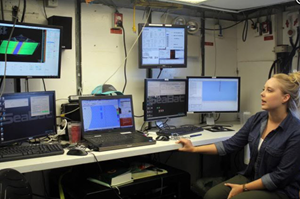
Lauren describes how the multibeam sonar transmits real-time bathymetry data to the computers onboard the R/V Point Sur. (Photo credit: Alison Deary, Carla Culpepper, and Kelia Axler)
Her Future
Lauren hopes to complete her master’s degree in August 2017 and begin her career as a field hydrographer. “The world’s oceans need to be mapped and I want to have a part in that,” said Lauren. “I am excited about the advances in technology.” She recommended that students considering a career in science get hands-on experiences to discover their passions. “I started out as a geologist, and now I am a hydrographer. If you have an interest, get your hands dirty. Volunteer or find an internship. You need the fundamentals taught in the classroom, but there is nothing like experiencing what a day in the life of a scientist is like.”
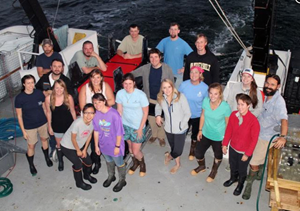
Lauren (center, gray jacket) and the CONCORDE field team onboard R/V Point Sur for the consortium’s Spring Campaign. (Provided by Lauren Quas)
Praise for Lauren
Dr. Ian Church described Lauren as an intelligent, hardworking, and innovative student whose eagerness to assist and teach others has made her a mentor to her peers. He emphasized the determination and problem-solving skills she exhibited in her leadership role aboard the R/V Point Sur during CONCORDE’s recent seabed mapping campaign. Lauren oversaw the successful mobilization of vessel sonar equipment, system troubleshooting, calibration, and data acquisition, processing, and analysis, which Church called “an incredible and notable accomplishment for anyone, let alone a graduate student with less than a year’s experience.”
Church said that Lauren’s enthusiasm is contagious and she takes pride in her research. “She is a naturally talented researcher with a drive to discover and produce innovative solutions to complex problems – I could not think of a person more deserving of the GoMRI Scholar award.”
The GoMRI community embraces bright and dedicated students like Lauren Quas and their important contributions. The GoMRI Scholars Program recognizes graduate students whose work focuses on GoMRI-funded projects and builds community for the next generation of ocean science professionals. Visit the CONCORDE website to learn more about their work.
************
The Gulf of Mexico Research Initiative (GoMRI) is a 10-year independent research program established to study the effect, and the potential associated impact, of hydrocarbon releases on the environment and public health, as well as to develop improved spill mitigation, oil detection, characterization and remediation technologies. An independent and academic 20-member Research Board makes the funding and research direction decisions to ensure the intellectual quality, effectiveness and academic independence of the GoMRI research. All research data, findings and publications will be made publicly available. The program was established through a $500 million financial commitment from BP. For more information, visit http://gulfresearchinitiative.org/.
© Copyright 2010- 2017 Gulf of Mexico Research Initiative (GoMRI) – All Rights Reserved. Redistribution is encouraged with acknowledgement to the Gulf of Mexico Research Initiative (GoMRI). Please credit images and/or videos as done in each article. Questions? Contact web-content editor Nilde “Maggie” Dannreuther, Northern Gulf Institute, Mississippi State University (maggied@ngi.msstate.edu).
RFP-V Lin: Resiliency and Recovery Connections in Oiled Wetland Plant-Microbial-Benthic Ecosystem
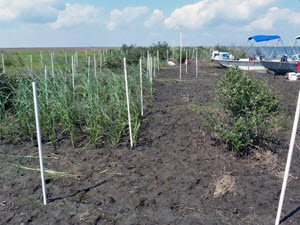
Restoration/remediation plots set up in a previously heavily oiled shoreline marsh along the northern Barataria Bay, Louisiana. (Photo provided by Qianxin Lin)
Marshes depend on a healthy, well-functioning complex of plants, microbes, and benthic communities to support the environmentally and economically important ecosystem services they offer, such as reducing storm surges and providing nursery grounds for many species. Researchers have been conducting studies assessing Louisiana marsh flora and fauna after the 2010 Deepwater Horizon oil spill and have identified factors influencing the plant-microbial-benthic complex’s function and long-term sustainability. Their work-to-date suggests that recovery is occurring but is not yet complete, highlighting the need for a much longer-term study to better quantify marsh recovery and resiliency.
The Gulf of Mexico Research Initiative recently awarded Dr. Qianxin Lin a grant to bring together marsh ecosystem researchers and build on their previous work. Specialists are collecting and analyzing samples of marsh plants, benthic organisms, and microbes and are synthesizing their observations to identify connections and influence on oiled marsh recovery. Their findings will help document long-term impacts on the coastal plant-microbial-benthic ecosystem and assess the recovery timeline. They are also evaluating the effectiveness of certain restoration and remediation strategies in promoting long-term sustainability in oil-affected marshes.

Sean Graham, Stefan Bourgoin, and Don Deis collect samples at a study site in northern Barataria Bay, Louisiana. (Photo provided by Qianxin Lin)
“Researchers are usually specialists who study just one of these components [plants, microbes, benthic communities] rather than all of them,” explained co-Principle Investigator John Fleeger. “We have a group of investigators who are working together to look at all of those parts, and we’re really getting the whole picture of how the marsh is responding.”
The researchers have been sampling the plant-microbial-benthic complex every six months for the last five and a half years. While their previous work focused on how the different components of the marsh responded to oil, they are now focusing on the long-term and larger picture of ecosystem recovery. Team members return to study sites and collect samples for each component of the study. Some will count the number of periwinkle snails, fiddler crab burrows, and aboveground plant stems present in the field and collect belowground root and rhizome samples. Others analyze soil samples using microscopes and DNA extractions to identify the functional microbial community. They are also testing soil shear strength to determine how stable it is and to make observations about oiling’s influence on the soil’s stability or erosion rate.
The team has already uncovered some of the plant-microbial-benthic connections they are seeking. For example, their work has shown that plants, such as the grass Spartina, and the densities of animals living in the sediment recovered at the same pace, suggesting that the recovery of sedimentary animals is closely correlated with plant recovery. Fleeger explained, “We have to make these connections thinking ‘What did the plant people find? What did the benthic people find? How can we look at those findings together and make connections within them?’ There’s no one big magic index that allows us to put all of the data in one big formula and crank out a number. We have to actually gauge how the different components are responding and then piece it together.”
The researchers plan to expand their work this summer to include field manipulative experiments that look closely at linkages they have identified, such as the relationship between plants and periwinkle snails. The team will investigate how strong these interactions are and how oil might tip the balance between the plants’ sustainability and the numbers of the snails eating them. They are also building on past experiments to evaluate the long-term effectiveness of restoration plantings and remediation with fertilizer. Initial assessments of the experiments have shown promising short-term results towards accelerating the pace of recovery and enhancing marsh stability. The team will continue experimenting with and evaluating combinations of planting and fertilizer to determine their viability as methods for enhancing long-term marsh recovery.
The project’s researchers are Qianxin Lin, John Fleeger, and Aixin Hou at Louisiana State University, Donald R. Deis at Atkins North America, Inc., and Sean Graham at Nicholls State University. Their project is Long-Term Impact, Recovery and Resilience: Wetland Plant-Microbial-Benthic Ecosystem Responses to the Deepwater Horizon Oil Spill and Mitigation Strategies Promoting Sustainability.
************
The Gulf of Mexico Research Initiative (GoMRI) is a 10-year independent research program established to study the effect, and the potential associated impact, of hydrocarbon releases on the environment and public health, as well as to develop improved spill mitigation, oil detection, characterization and remediation technologies. An independent and academic 20-member Research Board makes the funding and research direction decisions to ensure the intellectual quality, effectiveness and academic independence of the GoMRI research. All research data, findings and publications will be made publicly available. The program was established through a $500 million financial commitment from BP. For more information, visit http://gulfresearchinitiative.org/.
© Copyright 2010- 2017 Gulf of Mexico Research Initiative (GoMRI) – All Rights Reserved. Redistribution is encouraged with acknowledgement to the Gulf of Mexico Research Initiative (GoMRI). Please credit images and/or videos as done in each article. Questions? Contact web-content editor Nilde “Maggie” Dannreuther, Northern Gulf Institute, Mississippi State University (maggied@ngi.msstate.edu).
Lesson Plan: Marine Navigation Learning Module
 The module is the fourth in a series of marine environment-focused teaching and learning modules developed by the consortium for grades 6 – 12. This module focuses on navigating marine environments, particularly historical and current human navigation and animal navigation. The module is available for download here.
The module is the fourth in a series of marine environment-focused teaching and learning modules developed by the consortium for grades 6 – 12. This module focuses on navigating marine environments, particularly historical and current human navigation and animal navigation. The module is available for download here.
This module was developed by the DEEPEND (Deep-Pelagic Nekton Dynamics) Consortium and their consultants. Whenever possible, the lessons will focus specifically on events of the Gulf of Mexico or work from the DEEPEND scientists.
All modules in this series aim to engage students in grades 6 through 12 in STEM disciplines, while promoting student learning of the marine environment. We hope these lessons enable teachers to address student misconceptions and apprehensions regarding the unique organisms and properties of marine ecosystems. We intend for these modules to be a guide for teaching. Teachers are welcome to use the lessons in any order, use just portions of lessons, and may modify the lessons as they wish. Furthermore, educators may share these lessons with other school districts and teachers; however, please do not receive monetary gain for lessons in any of the modules.
You can view other modules here: http://outreach.deependconsortium.org/index.php/education/resources/lesson-plans
DEEPEND Infographic Poster Visualizes Vertical Migration
 Deep-sea investigators served as consultants for their partner Oregon Coast Aquarium’s educational infographic about diel vertical migration – the largest animal migration phenomenon on earth. The consortium has printed several copies of the poster to distribute to teachers as well as a large banner for use during outreach events.
Deep-sea investigators served as consultants for their partner Oregon Coast Aquarium’s educational infographic about diel vertical migration – the largest animal migration phenomenon on earth. The consortium has printed several copies of the poster to distribute to teachers as well as a large banner for use during outreach events.
Video: C-IMAGE Releases Aerial Video of OneGulf Expedition
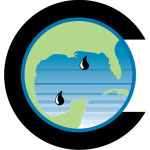 Researchers studied fish and seafloor sediments across the southern, western and northern Gulf of Mexico. Their goals were to understand the lasting impacts of oil spills and to develop baseline levels in Gulf waters.
Researchers studied fish and seafloor sediments across the southern, western and northern Gulf of Mexico. Their goals were to understand the lasting impacts of oil spills and to develop baseline levels in Gulf waters.
This aerial footage shows a sample of the work our researchers perform while aboard the R/V Weatherbird II. These studies include using a sediment multicore, bottom longline fishing, and plankton tows (bongo nets).
This research was made possible by a grant from The Gulf of Mexico Research Initiative/C-IMAGE II.
RFP-V Saul: Impact of Deepwater Horizon Oil Spill on Behaviors of Fishers in Gulf of Mexico
The Avoiding Surprises: understanding the impact of the Deepwater Horizon oil spill on the decision making behaviors of fishers and how this affects the assessment and management of commercially important fish species in the Gulf of Mexico using an agent-base project is lead by Steven Saul, Arizona State University.
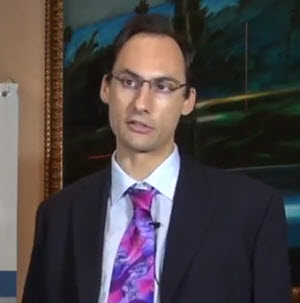
Researcher Steven Saul
The Deepwater Horizon oil spill disrupted the livelihoods of many individuals living along the coast of the Gulf of Mexico, ranging from those in the tourism industry to those who fish the Gulf’s waters for a living. Many of those in the fishing industry, and the sectors that depend on it had to modify their operations (i.e. alter their fishing locations, target species, gear used, or trip duration) in the months after the spill due to spatial closures restricting access to potentially polluted waters. Some of the fishing effort during this time was redirected towards assisting with the cleanup efforts associated with the oil spill. This re-tasking had a direct effect on fishing catch and effort in 2010, and perhaps beyond, depending on whether behaviors that were modified due to the oil spill were maintained in the years ahead or if there was a return to the original behavioral patterns that existed before the incident.
To assess the status of commercially important fish stocks in the Gulf of Mexico, the National Marine Fisheries Service relies heavily on information on fish catch and fishing effort that is compulsorily provided by the fishing industry to the government. This information is used to estimate trends in fish abundance over time and serves as inputs to tune the fish population models that are used to establish fishing regulations, such as annual catch limits. At the present time, it is not well understood how the oil spill closures affected the catch of fish and the amount of time/effort fishers needed to use to catch those fish. As a result, it has been difficult for the National Marine Fisheries Service to use the 2010 year of data as a proxy for the trends in abundance that year due to the substantial behavior changes that occurred in the fishing fleet. A biased index of abundance could affect the abundance estimates and the estimated catch limit trajectories stock assessment models provide for future years, as recruitment in future years is dependent on the biomass available in previous years, which is in turn, affected by the fishing mortality that year. Such biases could result in socioeconomic losses to the fishing community by either triggering unnecessary reductions in catch, or conversely increases in catch under conditions where biomass is actually reduced.
To improve our understanding of these dynamics, the goal of this project is to develop a spatially explicit bioeonomic model of some the most important commercial fishery species and the fleets that harvest them in the Gulf of Mexico. The project continues the work initiated by the PI and his collaborators, whom have developed a spatially explicit model for the West Florida shelf that incorporates the behavior of four reef fish species (red grouper, gag grouper, red snapper and mutton snapper) and two commercial fishing fleets (handline and longline) (1). The new proposed model will extend the geographical scope of the current model to the entire US shelf of the Gulf of Mexico, will include additional species (brown shrimp, pink shrimp and menhaden) and two new fishing fleets (shrimp trawlers and menhaden purse seiners). Additionally the model will be modified to incorporate the direct effects of oil pollution on the survival of adult fish and shrimp and the reduction in recruitment caused by impacts of oil on spawner fitness and larval survival. In addition to understanding fleet dynamics, the model will also be used to evaluate long term responses of these populations to the disturbances caused by the oil pollution and by the imposition of fishing closures. Alternative responses to the spill will also be evaluated to understand the scope of the possible effects of different sizes of oil spills on the recovery of these populations.
Click for access to GoMRI’s YouTube videos of RFP-V Projects…
************
This project was funded by the Gulf of Mexico Research Initiative (GoMRI) in the RFP-V funding program.
The Gulf of Mexico Research Initiative (GoMRI) is a 10-year independent research program established to study the effect, and the potential associated impact, of hydrocarbon releases on the environment and public health, as well as to develop improved spill mitigation, oil detection, characterization and remediation technologies. An independent and academic 20-member Research Board makes the funding and research direction decisions to ensure the intellectual quality, effectiveness and academic independence of the GoMRI research. All research data, findings and publications will be made publicly available. The program was established through a $500 million financial commitment from BP. For more information, visit http://gulfresearchinitiative.org/.
RFP-V Smith: Investigating Louisiana Dolphins’ Reproductive Health After Deepwater Horizon
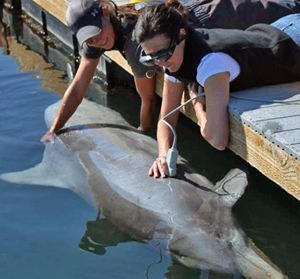
Megan Tormey (left) and Cynthia Smith (right) of NMMF conduct a voluntary ultrasound examination of a Navy dolphin in San Diego Bay, California, utilizing a heads-up video display (virtual reality glasses) to view the ultrasound image in real time. (Photo courtesy of U.S. Navy)
Concern about how the Deepwater Horizon oil spill may continue to negatively affect wild bottlenose dolphins living in the spill’s footprint remains high. Researchers supporting the Natural Resource Damage Assessment (NRDA) studied live and stranded dolphins in the heavily affected area of Louisiana’s Barataria Bay and reported that exposed dolphins exhibited increased lung disease, adrenal gland abnormalities, late-term pregnancy losses, and an 80% reproductive failure rate – four times greater than dolphins from unaffected areas. So how are the dolphins doing now?
The Gulf of Mexico Research Initiative recently awarded Dr. Cynthia Smith a grant to further investigate the dolphins’ reproductive impairment after the oil spill. Many stranded perinatal dolphins (perinates) in this region showed evidence of fetal distress and subsequent death in the womb and exhibited high reproductive failure rate. This project seeks to better understand how oil spill exposure impaired the reproductive health of this population through more precise physiologic measures and to assess how long these negative reproductive effects could last.

NMMF’s Cynthia Smith (left) and Randall Dear performing ultrasound on a bottlenose dolphin during a previous NOAA-led health assessment. (Photo by Todd Speakman, NOAA; NMFS permit #18786)
The project’s veterinary and research teams will care for dolphins from the Navy’s Marine Mammal Program that have documented health histories and receive ongoing assessments to develop advanced diagnostic techniques that will be applied to Barataria Bay dolphin capture-release field studies. The techniques will help identify fetal, placental, and maternal abnormalities potentially contributing to increased reproductive failure. The teams will use blood-based hormone testing for fetal and placental health evaluations and to assess potential mechanisms driving reproductive failure.

Dolphin Y01 pushing a dead calf in Barataria Bay, Louisiana, in March 2013.
(Photo by Louisiana Department of Wildlife and Fisheries)
Examinations of live, pregnant Barataria Bay dolphins and comparisons with documented Navy dolphin pregnancies will help establish current maternal health, pregnancy status, and fetal and placental health scores. The researchers will track the reproductive health of Barataria Bay dolphin mothers using boat-based monitoring. Parallel studies will evaluate dead adult and perinatal dolphins stranded during the study period for lesions and cause of death. The team will assess tissue samples from dead perinates for evidence of fetal distress, inflammation, and signs that a breath was taken outside of the womb. Then they will compare results with tissue analyses from historical Navy perinate losses to identify potential risk factors and predictors of late-term perinatal losses.
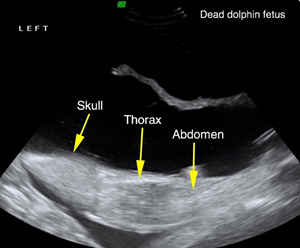
Ultrasound image of a dead dolphin fetus acquired by NMMF’s Cynthia Smith and Veronica Cendejas in Barataria Bay 2011 (NMFS permit #932-1905/MA-009526). (Provided by Cynthia Smith)
The project’s researchers believe that the development of advanced technologies and establishment of baseline reproductive health data will enhance the medical evaluation of Barataria Bay dolphins and advance diagnostic capacities for small cetaceans.
Smith elaborated, “This research will lend insight into the progression of disease states that are likely contributing to loss and inform our understanding of the potential timeline for recovery with regard to successful reproduction. Once we define why these animals are losing their babies, we can help determine the best way to develop strategies for their protection and recovery.”

Ultrasound image of a live dophin fetus acquired by NMMF’s Cynthia Smith and Veronica Cendejas in Barataria Bay 2011 (NMFS permit #932-1905/MA-009526). (Provided by Cynthia Smith)
This project’s researchers are Cynthia Smith, Lori Schwacke, and Stephanie Venn-Watson of the National Marine Mammal Foundation (NMMF) and Teri Rowles of the National Oceanic and Atmospheric Administration (NOAA). Their project is Investigation of Mechanisms for Reproductive Failure in the Aftermath of the Deepwater Horizon Oil Spill to Understand Population Recovery Scenarios for Cetaceans.
************
The Gulf of Mexico Research Initiative (GoMRI) is a 10-year independent research program established to study the effect, and the potential associated impact, of hydrocarbon releases on the environment and public health, as well as to develop improved spill mitigation, oil detection, characterization and remediation technologies. An independent and academic 20-member Research Board makes the funding and research direction decisions to ensure the intellectual quality, effectiveness and academic independence of the GoMRI research. All research data, findings and publications will be made publicly available. The program was established through a $500 million financial commitment from BP. For more information, visit http://gulfresearchinitiative.org/.
How Grad Student Cui Uses River Diversion Models to Inform Oil Spill Remediation
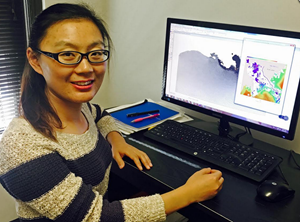
Linlin creates a movie of the Lagrangian particle tracking to determine the impacts of Davis Pond diversion on salinity gradients in the Barataria Bay. (Provided by Linlin Cui)
When oil from the Deepwater Horizon spill began approaching land, one proposed response was to divert Mississippi River water and sediment into the marshes to try and push surface oil more towards the Louisiana-Texas shelf. Linlin Cui is investigating the impacts of Mississippi River diversions on Barataria Bay hydrodynamics to help inform how future oil spill responders plan and execute freshwater diversions. Her research and its products provide tools for combating the loss of Louisiana’s coastal wetlands and for conserving and restoring healthy and productive ecosystems.
Linlin is a Ph.D. student in Louisiana State University’s (LSU) Oceanography and Coastal Sciences program and a GoMRI Scholar with CWC.
Her Path
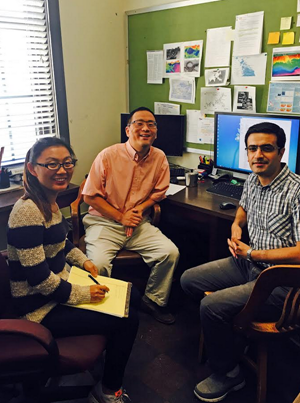
Linlin (left), Haosheng Huang (center), and Soroush Sorourian (right) discuss the research process in Huang’s office. (Provided by Linlin Cui)
Linlin grew up in a small fishing town near China’s Yellow Sea. Her childhood included fond memories of tasting new types of seafood and of fishermen selling fresh catches at the local seafood market. Most of China’s eastern coastal areas, including Linlin’s hometown, experienced rapid economic growth since the early 2000s. Booms in the manufacturing industry contributed to serious environmental issues, including coastal water pollution. Today, various fish species are decreasing in number and declining in health and size. “Many people in my small hometown do not know how to protect the coastal environment,” said Linlin. “Seeing all these heart-breaking changes made me wonder if I could do something about it.”
Linlin learned about numerical modeling during the senior year of her marine science undergraduate studies at Nanjing University of Information Science and Technology. Numerical modeling allows researchers to conduct studies using limited historical data and analyze their dynamic processes in accurate and quantitative ways. She studied numerical modeling more closely through Shanghai Ocean University’s fisheries research master’s program, where she independently developed an East China Sea mesoscale meteorological model that was used to investigate the passage of typhoon and enhanced air-sea fluxes. Fascinated by the great potential of numerical ocean models, she joined Dr. Haosheng Huang’s research group 2013 and began work on GoMRI-sponsored coastal ocean and estuarine dynamics studies.
Her Work
A major diversion is under development to push Mississippi River water and sediment into Barataria Bay to help restore coastal Louisiana wetlands affected by Deepwater Horizon oil. Linlin used the Finite Volume Community Ocean Model (FVCOM) to characterize how these diversions may impact Barataria Bay hydrodynamics, including salinity gradients and oil’s residence time in the Bay and adjacent continental shelf, and to predict possible oil slick transport trajectories for future events.

Linlin and her classmates collect data during an Estuarine Ecology course field trip to Grand Isle. (Provided by Wei Huang)
Linlin helped create and validate a high-resolution FVCOM hydrodynamic model grid for the Louisiana-Texas continental shelf with a horizontal resolution of 10 meters for Barataria Bay. The model uses coupled hydrodynamics-wave-sediment data to simulate oil-particle interactions, oil deposition and resuspension, and sediment erosion and transport in response to frontal and tropical disturbances. Her preliminary simulations showed that Davis Pond and mid-Barataria diversions decreased salinity in the lower Barataria Bay by as much as 5 parts per thousand and decreased oil residence times from 27 to 2 days. “Reduced salinity can cause significant reductions, displacements, or enhancements to fish and shellfish species based on their different tolerances and responses to salinity changes,” she explained.
Linlin’s modeling results can be used to help plan emergency response efforts to disasters such as oil spills. Policy-makers and resource managers can use the model to inform the planning and execution of water and sediment diversions, including identifying the ideal time to open diversions and the optimal volume of water.
Her Learning

Simulation depicting the Barataria Basin’s surface salinity and current fields after the opening of the Davis Pond diversion. The diversion is intended to push oil from the Gulf oil spill away from coastal wetlands. (Provided by Linlin Cui)
Linlin’s research experiences helped her grow as a scientist and as a member of the scientific community. Working with Dr. Huang, she learned about new meteorological and oceanic models that could be applied to her research. She also became more involved in the scientific community through her participation in conferences such as the Gulf of Mexico Oil Spill and Ecosystem Science Conference, the State of the Coast Conference, and the Estuarine and Coastal Modeling Conference and participation in weather research and forecasting model training sessions. She said, “All of the excellent feedback and suggestions from other experienced researchers that I received from these conference and training experiences have broadened my horizons and improved my research.”
Her Future
Linlin hopes to continue her research through a postdoc position in physical coastal ocean research. She recommended that students considering a science career should pursue a field that they truly love and accept failures when they happen, “Failure is a natural process and always part of scientific research – don’t give up easily.” She emphasized the importance of working closely with advisors and learning from their expertise and being involved in the science community.
Praise for Linlin
Dr. Huang highlighted Linlin’s capability and growing knowledge in her field, stating that she is well-versed in the tools required for her research and able to learn new software quickly and apply it. He noted her persistence and carefulness when conducting research, citing her numerical model’s triangular grid as an example. The grid’s construction took more than six months of diligent computer work, delineating characteristic water channel networks and wetlands and engineering structures based on Google Earth imagery and the LiDAR digital elevation model. She validated the model with observational data, but the grid still required adjustments and revisions. “The work is painstaking and requires great patience,” said Huang. “Linlin is determined and has gone through the process enthusiastically.”
Huang praised Linlin’s positivity and ability to work with other researchers, “Linlin is quite polite and friendly to the faculty, staff, and other graduate students in our department. She generously shares her working notes and experiences in high-performance computing and scientific visualization with other students in my group and with people in our university.”
The GoMRI community embraces bright and dedicated students like Linlin Cui and their important contributions. The GoMRI Scholars Program recognizes graduate students whose work focuses on GoMRI-funded projects and builds community for the next generation of ocean science professionals. Visit the CWC website to learn more about their work.
************
The Gulf of Mexico Research Initiative (GoMRI) is a 10-year independent research program established to study the effect, and the potential associated impact, of hydrocarbon releases on the environment and public health, as well as to develop improved spill mitigation, oil detection, characterization and remediation technologies. An independent and academic 20-member Research Board makes the funding and research direction decisions to ensure the intellectual quality, effectiveness and academic independence of the GoMRI research. All research data, findings and publications will be made publicly available. The program was established through a $500 million financial commitment from BP. For more information, visit http://gulfresearchinitiative.org/.
How Grad Student Seubert Interprets Gulf of Mexico Resiliency Using Predator Diet
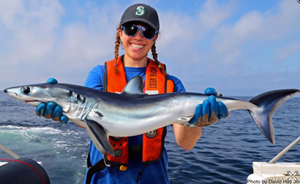
Emily displays a shortfin mako she and her team encountered while conducting longline surveys. (Provided by Emily Seubert)
Major environmental disturbances such as oil spills can alter a marine ecosystem’s structure and even cause species losses or additions in impacted areas – changes which may have long-term consequences for an ecosystem’s functions.
Emily Seubert investigates the diets of marine predators in the northern Gulf of Mexico food web to better understand how the Deepwater Horizon spill may have affected the Gulf’s functional diversity and resiliency. “It is our duty as residents of this planet to protect and care for it,” explained Emily. “The more we understand, the more knowledge we can spread to others and help protect our world.”
Emily is a marine science master’s student with the University of South Alabama and a GoMRI Scholar with the Alabama Center for Ecological Resilience (ACER).

Emily throws out a baited gangion as she sets the bottom longline. (Provided by Emily Seubert)
Her Path
Emily spent the summers of her Seattle childhood exploring Puget Sound tide pools and being awestruck by orca whale pods that would surround her family’s boat. These experiences drove her desire to study marine science. Emily completed a bachelor’s degree in biological sciences at the University of California, Davis in 2013 and began a master’s degree in marine science at the University of South Alabama and the Dauphin Island Sea Lab in 2015. Her desire to learn more about ecosystem interactions and functions sparked her interest in joining her advisor Dr. Marcus Drymon to study effects of the Deepwater Horizon oil spill on species diversity and food web interactions.
Her Work
Functional diversity refers to an ecosystem’s particular biological processes, functions, and characteristics. Previous studies have suggested that the Deepwater Horizon spill reduced the abundance and diversity of consumers at various trophic levels in the Gulf food web, likely altering ecosystem function. Community-level changes documented post-spill showed elevated numbers of predator species compared to pre-spill observations, which could indicate a restructuring of the northern Gulf food web. Emily assesses stable isotope ratios in apex predators (top of the food chain) and mesopredators to investigate the post-spill food web and quantify functional groups, which will help her identify shifts in the system’s functional diversity.

Emily (left) uses a knife to peel back the skin of a bull shark so she can use a biopsy punch to extract a sample of white muscle tissue. (Provided by Emily Seubert)
Emily extracts blood and muscle tissue samples from predatory shark, ray, and fish species collected in waters around the Chandeleur Islands, Mississippi Sound, and Mobile Bay. She analyzes the samples for carbon, nitrogen, and sulfur stable isotope ratios. Emily explained that carbon 13 – the stable isotope of carbon – does not fractionate as it moves through the food web; therefore, carbon’s stable isotope ratio is useful for identifying the source of organic matter that fuels a food web. Similarly, sulfur does not fractionate and its stable isotope ratio can help differentiate between benthic and pelagic food webs. Unlike carbon and sulfur, nitrogen does fractionate with each change in trophic level, making it a useful indicator of trophic position. The combination of these three stable isotope ratios allows Emily to identify each sampled organism’s role in the food web and determine if its functional role overlaps with other organisms.
Emily uses this information to look at the ecosystem as a whole to determine what the area’s functional diversity indicates about its resiliency after an environmental disaster. She explained that having more functionally diverse species increases an ecosystem’s resiliency to disasters: “The more functionally diverse an ecosystem, the greater its resiliency and its potential to recover from a disturbance like an oil spill. Think about an ecosystem with only three roles or trophic niches to fill, and you’ve lost one in a disaster. That ecosystem would suffer a lot more from losing one species or niche than a more robust ecosystem with ten roles or trophic niches.”

Emily uses a hypodermic needle to extract blood from the caudal vein of a blacktip shark. (Provided by Emily Seubert)
Understanding the resiliency and robustness of ecosystems can help inform recovery and restoration plans for future environmental disasters. Researchers and responders can use this information to determine which ecosystems are more vulnerable to environmental disasters and will therefore need more protection and better management. “If a disaster-affected ecosystem exhibited low numbers of apex predators and high numbers of mesopredators, we should manage our fishing pressures on those higher-level organisms,” explained Emily. “In that scenario, we can suspect that something is offsetting the balance, and relieving our fishing efforts on top predators may help bring the system back to equilibrium.”
Her Learning
Emily has found that, while the scientific process seems straightforward, learning how to juggle fieldwork, lab work, classes, presentations, and conferences can be challenging. Her ACER research provided her with valuable experience in planning, executing, and managing research and in clearly communicating her research and findings, helping her grow as a young scientist and professional. “The difference between where I started and where I am now is night and day,” said Emily. “I gain more confidence and knowledge with every obstacle and task I face. I know that I am growing as a scientist every day, surrounded by amazing mentors and a fantastic support team.”
Her Future
Emily plans to complete her master’s degree by the end of 2017 and find a position that allows her to travel and work in various labs around the country or even the world. She believes that working with different organisms, ecosystems, environments, and people can help her better understand our natural world. “As I have done throughout my career, I will continue to keep my eyes and ears open and to never stop learning,” she said.
Emily recommends that students interested in marine science should take chances and venture outside of their comfort zone. Her path took her far from home to an area she never anticipated and researching species she knew little about. However, she says she cannot imagine working with a better ecosystem, study species, or advisor for her master’s research, “I feel extremely lucky and blessed to be doing what I’m doing, and I never would be where I am if I hadn’t taken chances.”
Praise for Emily
Emily’s advisor Dr. Marcus Drymon said it has been a pleasure to work with Emily as she matures into a seasoned researcher. He praised her “palpable enthusiasm” for her research and her cheerful wit, calling her an integral part of his project. “I’m proud of the progress that Emily has made,” he said. “I see enormous potential for Emily’s work to contribute to a broader understanding of ecosystem resiliency.”
The GoMRI community embraces bright and dedicated students like Emily Seubert and their important contributions. The GoMRI Scholars Program recognizes graduate students whose work focuses on GoMRI-funded projects and builds community for the next generation of ocean science professionals. Visit the ACER website to learn more about their work.
************
The Gulf of Mexico Research Initiative (GoMRI) is a 10-year independent research program established to study the effect, and the potential associated impact, of hydrocarbon releases on the environment and public health, as well as to develop improved spill mitigation, oil detection, characterization and remediation technologies. An independent and academic 20-member Research Board makes the funding and research direction decisions to ensure the intellectual quality, effectiveness and academic independence of the GoMRI research. All research data, findings and publications will be made publicly available. The program was established through a $500 million financial commitment from BP. For more information, visit http://gulfresearchinitiative.org/.
Smithsonian Features Luminous Critters Living in the Deep, Dark Gulf

A close up profile of an adult anglerfish female from the Linophryne family collected in the northern Gulf of Mexico. © 2016 DEEPEND/ Dante Fenolio
Scientists are finding fascinating discoveries in the largely unknown deep waters of the Gulf of Mexico.
Some fishes, invertebrates, and bacteria have evolved a special adaptation to living in dark conditions using bioluminescence. What’s new is the discovery of specific bacteria species that live symbiotically on anglerfish and emit light.
The Smithsonian recently published an article about these anglerfish and bacteria based on research funded by the Gulf of Mexico Research Initiative (GoMRI). Scientists with the DEEPEND consortium comb through mountains of marine samples and microbial DNA sequence data to help us better understand risks when events like the Deepwater Horizon strike.
Read the article Meet the Tiny Bacteria That Give Anglerfishes Their Spooky Glow to find out how fish who don’t produce their own light pair up with bacterium that do.
************
GoMRI and the Smithsonian have a partnership to enhance oil spill science content on the Ocean Portal website.
This research was made possible in part by a grant from BP/The Gulf of Mexico Research Initiative (GoMRI) to the Deep-Pelagic Nekton Dynamics of the Gulf of Mexico (DEEPEND) consortium. The GoMRI is a 10-year independent research program established to study the effect, and the potential associated impact, of hydrocarbon releases on the environment and public health, as well as to develop improved spill mitigation, oil detection, characterization and remediation technologies. An independent and academic 20-member Research Board makes the funding and research direction decisions to ensure the intellectual quality, effectiveness and academic independence of the GoMRI research. All research data, findings and publications will be made publicly available. The program was established through a $500 million financial commitment from BP. For more information, visit http://gulfresearchinitiative.org/.
RFP-V Smith: Reproductive Failure in Deepwater Horizon Oil Spill and Recovery of Cetaceans

Researcher Cynthia Smith
Concern about how the Deepwater Horizon oil spill may continue to negatively affect wild bottlenose dolphins living in the spill’s footprint remains high. Researchers supporting the Natural Resource Damage Assessment (NRDA) studied live and stranded dolphins in the heavily affected area of Louisiana’s Barataria Bay and reported that exposed dolphins exhibited increased lung disease, adrenal gland abnormalities, late-term pregnancy losses, and an 80% reproductive failure rate – four times greater than dolphins from unaffected areas. So how are the dolphins doing now?
The Gulf of Mexico Research Initiative recently awarded Dr. Cynthia Smith a grant to further investigate the dolphins’ reproductive impairment after the oil spill. Many stranded perinatal dolphins (perinates) in this region showed evidence of fetal distress and subsequent death in the womb and exhibited high reproductive failure rate. This project seeks to better understand how oil spill exposure impaired the reproductive health of this population through more precise physiologic measures and to assess how long these negative reproductive effects could last.
Click for access to GoMRI’s YouTube videos of RFP-V Projects…
************
This project was funded by the Gulf of Mexico Research Initiative (GoMRI) in the RFP-V funding program.
The Gulf of Mexico Research Initiative (GoMRI) is a 10-year independent research program established to study the effect, and the potential associated impact, of hydrocarbon releases on the environment and public health, as well as to develop improved spill mitigation, oil detection, characterization and remediation technologies. An independent and academic 20-member Research Board makes the funding and research direction decisions to ensure the intellectual quality, effectiveness and academic independence of the GoMRI research. All research data, findings and publications will be made publicly available. The program was established through a $500 million financial commitment from BP. For more information, visit http://gulfresearchinitiative.org/.
Podcast: DEEPEND’s Tamara Frank Discusses Research and Struggles Entering Marine Biology Field
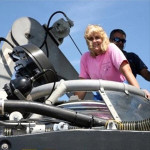
Dr. Tamara Frank
Dr. Frank works with the consortium’s crustacean team studying creatures such as crabs, lobsters, shrimp, and krill. She speaks about her research and shares why getting a job as an aspiring female scientist was very challenging.
RFP-V Thomas: Genomic Responses to Deepwater Horizon and High-Throughput Biological Assays
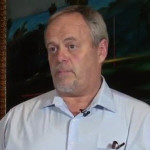
Researcher W. Kelley Thomas
The Genomic Responses to the Deepwater Horizon event and development of high-throughput biological assays for oil spills project is lead by W. Kelley Thomas, University of New Hampshire.
Within the GoM, the benthic environment is biologically hyper-diverse, performing critical ecosystem functions that have consequences for the ecology of the entire GoM region. Benthic communities are strongly impacted by oil spills, which render them a valuable tool for assaying and monitoring the impacts of contamination. However, the characterization of these communities has been impractical for large- scale deployment due to the tedious and time-consuming nature of the taxonomy required to accurately describe these communities. This project leverages recent and dramatic advances in DNA sequencing technology that have transformed the process of rapid, accurate, and cheap assays of community biodiversity. To achieve these goals, the project team brings together the interdisciplinary expertise in marine biology, taxonomy, genomics and bioinformatics necessary for the development of a meaningful and robust technology and has formulated three objectives.
Objective 1: Use targeted sequencing of individual benthic eukaryotes to generate a representative sample of diverse genomes from which to select an expanded set of nuclear and mitochondrial loci for targeted mining of shotgun metagenomic data.
Objective 2: Assess eukaryotic community structure across space and time via high-throughput sequencing of environmental metagenomes using a new and expanded array of nuclear and mitochondrial marker genes.
Objective 3: Establish Standard Operating Procedures (SOPs) and reproducible bioinformatic workflows for environmental monitoring of oil spills. This will include establishing a database for integration of taxonomic and molecular datasets, and dissemination of tools and educational resources.
Click for access to GoMRI’s YouTube videos of RFP-V Projects…
************
This project was funded by the Gulf of Mexico Research Initiative (GoMRI) in the RFP-V funding program.
The Gulf of Mexico Research Initiative (GoMRI) is a 10-year independent research program established to study the effect, and the potential associated impact, of hydrocarbon releases on the environment and public health, as well as to develop improved spill mitigation, oil detection, characterization and remediation technologies. An independent and academic 20-member Research Board makes the funding and research direction decisions to ensure the intellectual quality, effectiveness and academic independence of the GoMRI research. All research data, findings and publications will be made publicly available. The program was established through a $500 million financial commitment from BP. For more information, visit http://gulfresearchinitiative.org/.
Grad Student Pasparakis Looks to Fish Embryos for Long-Term Oil Spill Answers

Christina analyzes different life stages of mahi-mahi embryos under a stereomicroscope. (Photo by Dan DiNicola)
Studies that investigate the effects of oil exposure on developing fish are typically conducted at otherwise non-stressful ambient conditions, which may result in conservative impact estimates. Christina Pasparakis is studying the combined effects of oil exposure and other environmental stressors to create a more comprehensive assessment of Deepwater Horizon impacts.
Christina is a marine science Ph.D. student at the University of Miami and a GoMRI Scholar with the RECOVER consortium.
Her Path
Christina grew up on Key Biscayne, a south Florida island, where she developed a deep appreciation for the ocean and marine life. She was five years old when Hurricane Andrew devastated south Florida, including Key Biscayne’s once-flourishing Bill Baggs Cape Florida State Park. A few years later, however, salt marshes and mangrove ecosystems brimming with new forms of marine life had replaced the invasive Australian Pines that once dominated the park. “Watching the island regenerate after such a profound natural disaster, I learned a valuable lesson: nature is, in fact, remarkably resilient,” she explained. “It solidified my interest in studying nature and its incredible ability to adapt to changing conditions.”
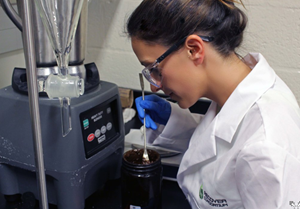
Christina makes a high-energy water-accommodated fraction (HEWAF) from surface oil. These WAF dilutions will be used in exposure experiments with embryonic mahi-mahi. (Photo by Dan DiNicola)
As Christina completed her biology master’s degree at San Francisco State University in 2013 and entered the University of Miami’s Ph.D. program in marine science, news about the Deepwater Horizon oil spill deeply saddened her. She became increasingly concerned as the spill’s ecological severity grew over time. When her advisor Dr. Martin Grosell started a multi-year oil spill research project in 2015, which continued his Natural Resources Damage Assessment oil-impact studies, Christina began researching oil’s effects on the developing Gulf fish whose spawning period temporally and geographically overlapped with the Deepwater Horizon event.
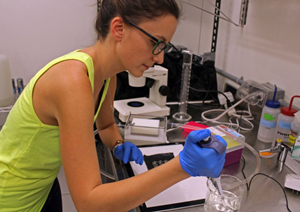
Christina hydrates a microplate used for high-throughput oxygen consumption data in small organisms, such as embryos and larvae. (Photo by Dan DiNicola)
Her Work
Recent studies suggest that oil toxicity may cause cardiovascular and morphological abnormalities in the embryonic and larval stages of developing fish. These sublethal effects of oil exposure may have subtle, yet ecologically significant, long-term consequences on entire fish populations. Christina is currently focused on understanding factors that affect developing embryos’ buoyancy, a critical aspect of their survival that helps promote dispersal and positioning of hatched larvae in the food-laden upper water column.
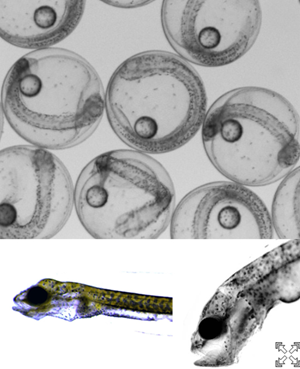
Stereomicroscope images of early life stage mahi-mahi at different developmental periods. The embryos (top) are 2 days post-fertilization and a few hours away from hatch, while the larvae (bottom left and right) are 2-3 days post-hatch. (Image by Christina Pasparakis)
Christina conducts exposure experiments on mahi-mahi at early developmental life stages using varying concentrations and types of oil (such as surface oil or source oil) and different environmental stressors, such as UV radiation, temperature, and salinity. She then quantifies changes in embryonic buoyancy over time, measures their sinking rate and nitrogenous waste excretion, and uses optical and imaging systems to assess oxygen consumption, cardiac function, and overall development. “All of these variables have significant implications for fish survival and growth to later life-stages,” explained Christina. “For example, embryos sinking down the water column earlier in development could place them in unfavorable conditions for hatching and post-hatch feeding and may increase predation risk.”
So far, Christina’s research has found that larvae who were exposed to oil as embryos displayed increased oxygen consumption rates, indicating elevated metabolic rates and the potential for corresponding increases in energy depletion. She observed depletions in embryonic mahi-mahi yolk sacs, the sole energy substrates for most developing fish embryos, which confirmed the projected energy depletion. Her results are the first to demonstrate increased energy demand and energy depletion in oil-exposed fish embryos and larvae.
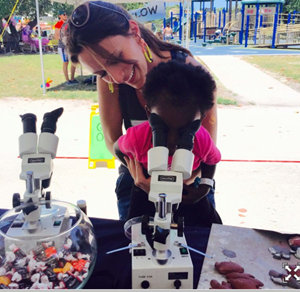
Christina at the University of Miami-sponsored Ocean Kid’s Day, a program that invites children from low-performing, high-needs elementary schools to participate in a day of marine science adventures. Here, she shows a young girl how early life stages of live mahi-mahi look under a microscope. (Photo by Elena Papademetriou)
Her Learning
Christina’s Ph.D. research has taught her the importance of creating a strong foundation of knowledge and expertise before jumping into an experiment. Troubleshooting the oxygen-sensing system she used to measure oxygen consumption was a long, tedious, and often frustrating process that did not produce any useable results. Reflecting on that process today, however, she has a much different perspective. “Those months of troubleshooting and method development were arguably some of the most valuable and character building experiences of my Ph.D.,” she explained. “It helped me test my boundaries and taught me that creativity and improvisation are critical skills in science.”
Christina believes in the importance of investing in future scientists. She initially found training and supervising undergraduate volunteers in the Grosell lab especially challenging and asked for a different lab duty. However, Grosell insisted that a person can only excel by improving on their weaknesses and assigned her even more undergraduates – it was ultimately one of the most fulfilling aspects of her Ph.D. “I learned how to be simultaneously critical and motivating and became a much more qualified mentor and teacher,” she said. “Watching my current undergraduate volunteer grow as a scientist and conduct experiments alone has been very rewarding and has solidified my passion to teach in the future.”
Participation in outreach activities with local students through the University of Miami’s Rosenstiel School of Marine and Atmospheric Science has been an important part of Christina’s growth. She volunteered with Ocean Kids, a University of Miami-sponsored program that introduces at-risk grade school students to science. She also helped with Women in Science Day to inspire young girls to pursue scientific careers. “My volunteer activities provided an effective way to motivate younger generations to care about the sustainability and preservation of our ocean and fisheries,” said Christina. “I believe spreading knowledge about the destructive consequences of environmental catastrophes such as the Deepwater Horizon oil spill will help prevent these disasters from happening in the future and better prepare us for when they do occur.”
Her Future
Christina wants a career that will allow her to study, learn, and teach about oceans and their ability to adapt and recover during periods of rapid environmental change. She hopes to continue spreading awareness about the current state of marine ecosystems and how global climate change, increased pollution, and environmental disasters risk oceans’ sustainability and diverse marine life. “Motivation requires optimism,” she concluded. “Despite recent studies displaying dire projections for the future, we must find a way to focus on the positive and believe in the resilience of nature.”
Praise for Christina
Dr. Grosell noted that, in addition to pursuing her own research, Christina plays a central role in numerous collaborative projects with visiting scientists and University of Miami colleagues. “The ability to develop equipment and techniques for sophisticated measurements is a hallmark of an outstanding Ph.D. student. In Christina, these skills are combined with strong writing skills, and she consistently connects well with broad audiences,” said Grosell. “I view Christina as an exceptionally strong young scientist with immense potential.”
The GoMRI community embraces bright and dedicated students like Christina Pasparakis and their important contributions. The GoMRI Scholars Program recognizes graduate students whose work focuses on GoMRI-funded projects and builds community for the next generation of ocean science professionals. Visit the RECOVER website to learn more about their work.
************
The Gulf of Mexico Research Initiative (GoMRI) is a 10-year independent research program established to study the effect, and the potential associated impact, of hydrocarbon releases on the environment and public health, as well as to develop improved spill mitigation, oil detection, characterization and remediation technologies. An independent and academic 20-member Research Board makes the funding and research direction decisions to ensure the intellectual quality, effectiveness and academic independence of the GoMRI research. All research data, findings and publications will be made publicly available. The program was established through a $500 million financial commitment from BP. For more information, visit http://gulfresearchinitiative.org/.
Sea Grant Releases Brochure on Oil Spill and Fish Lesions
The Sea Grant Oil Spill Outreach Team released a new informational brochure about the connection of Deepwater Horizon and fish lesions reported in the winter following the spill. The team reviewed published science and worked with experts to develop this brochure for a broad range of audiences, particularly those who live and work across the Gulf Coast.
The brochure Skin Lesions in Fish: Was There a Connection to the Deepwater Horizon Oil Spill? explains what fish skin lesions are, what factors might cause lesions, and what fish lesion data can tell us about the oil spill.
The Sea Grant Oil Spill Outreach Team offers public seminars across the Gulf Coast. Click here to view upcoming science seminars and read about recently-held events. To receive email updates about seminars, publications, and the outreach team, click here.
************
GoMRI and the Sea Grant programs of the Gulf of Mexico (Florida, Mississippi-Alabama, Louisiana, and Texas) have partnered to create an oil spill science outreach program.
The Gulf of Mexico Research Initiative (GoMRI) is a 10-year independent research program established to study the effect, and the potential associated impact, of hydrocarbon releases on the environment and public health, as well as to develop improved spill mitigation, oil detection, characterization and remediation technologies. An independent and academic 20-member Research Board makes the funding and research direction decisions to ensure the intellectual quality, effectiveness and academic independence of the GoMRI research. All research data, findings and publications will be made publicly available. The program was established through a $500 million financial commitment from BP. For more information, visit http://gulfresearchinitiative.org/.
Grad Student Fiore Investigates Oil Spill Impacts on Gulf Economy and Fisheries Resiliency
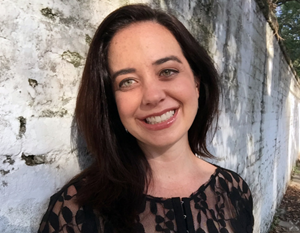
Jacqueline Fiore is an economic analysis and policy Ph.D. student at Tulane University. (Provided by Jacqueline Fiore)
Natural and manmade disasters often involve long-term effects, but the majority of follow-up research tends to focus on the biophysical impacts rather than the social. Jacqueline Fiore, a Louisiana resident, understands how disasters such as hurricanes and oil spills can impact local industries, citizens, and ecosystems.
Jacqueline, a Ph.D. student in Tulane University’s Economic Analysis and Policy program and a GoMRI Scholar with the Consortium for Resilient Gulf Communities (CRGC), uses applied economics to study the Deepwater Horizon oil spill’s socioeconomic impacts on Gulf fisheries, assess their ability to recover, and help inform future oil spill response.
Her Path
Jacqueline’s journey into oil spill research began on the other side of the globe after she completed a bachelor’s degree in communications and two master’s degrees in epidemiology and economics. She worked for Michigan State University conducting epidemiological studies on malaria in Malawi, Africa with the National Institutes of Health Malawi International Center for Excellence in Malaria Research program. While she enjoyed this research, Jacqueline felt that she was still searching for her “niche” and realized that she wanted to learn econometric methods for public health research.
Jacqueline entered Tulane University’s Ph.D. program in economic analysis and policy. Her advisor Dr. K. Brent Venable introduced her to the CRGC studies on Gulf communities’ resilience to large-scale environmental disasters such as the 2010 Deepwater Horizon oil spill. Jacqueline joined the project’s economics sub-team with her other two advisors RAND Corporation economists Drs. Craig Bond and Shanthi Nataraj and uses economic analysis to study the oil spill’s impact on the fishing industry.
Her Work
Jacqueline explained that the concept of resilience refers to human communities’ ability to respond, reorganize, and recover during and following a damaging event. She continued, “The dynamics of certain indicators, such as fisheries landings and revenues, can provide information about the abilities of fisheries to withstand and recover from oil spill events.”
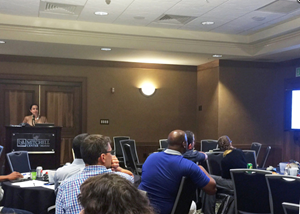
Jacqueline presents her preliminary findings at the CRGC All-Hands Meeting in Mobile, Alabama, in June 2016. (Photo by Elizabeth Thornton of RAND Corporation)
Jacqueline contacted approximately 70 fisheries and tourism representatives for insight into the best data sources for her research and identified National Oceanic and Atmospheric Association (NOAA) commercial fishing data and state-maintained trip ticket datasets as the most comprehensive sources for pre- and post-spill data. She then worked with the CRGC economics sub-team to identify the best model specifications for analysis. She plans to combine these specifications with public- and restricted-access data to assess the spill’s effects on fisheries landings for select Gulf fish species.
Jacqueline’s research will quantify impacts to fisheries landings in pounds and revenues over time, accounting for variables such as number of fishing trips, type of gear used, and total area fished. She will complement anecdotal accounts and time-series data with an econometric assessment to place the spill’s economic impacts in context with the impacts of the 2005 hurricane season. Ultimately, Jacqueline hopes that her findings will help the fisheries industry and associated communities prepare for the way various Gulf fish species and fishers may respond to future disasters.
Her Learning
Jacqueline discovered that the research process can be challenging, particularly when working with human-related data. She recalls learning about and adhering to data confidentiality rules when using government datasets, adjusting her economic models to match each data source’s availability and variables, and even reframing how she communicated her findings to various audiences. For example, she adapted presentations of her preliminary results at CRGC All-Hands Meetings to better suit an audience without an economics background. Rather than focusing on her work’s detailed methods and techniques, which the audience would not be familiar with, she focused on graphs that illustrated trends in her findings.
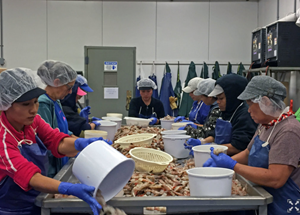
Dominik’s Seafood Inc. – a shrimp processing plant in Bayou La Batre, Alabama – is one of the many local Gulf-area businesses that could benefit from Jacqueline’s research with the economics sub-team. (Photo by Jacqueline Fiore)
Jacqueline also experienced how her research can impact and be impacted by a wide range of people. CRGC All Hands Meetings are attended by the consortium’s technical and stake holder advisory committees, principal investigators, research staff, and graduate students, allowing Jacqueline to gain valuable feedback about her findings from a diverse audience. Fellow researchers offered insights into why some fish species may have been more affected after the spill than others and theorized how fisheries closures might cause some fish species to appear more resilient than they may actually be. She also met with Deepwater Horizon-impacted community members and observed seafood processing plants on a field trip to Bayou La Batre, Alabama. The plant’s employees may use her results to identify which fish species may be the most affected and to estimate financial impacts should another disaster occur.
Her Future
Jacqueline plans to complete her Ph.D. in spring 2018 and hopes to pursue a research program or program management position where she can use her training and expertise in economics and epidemiology. She is particularly interested in industry- or government-initiated projects that are implemented in an academic or private sector, because she “enjoys multidisciplinary collaboration, quick turnaround, and the ability to measure her findings’ impact on the target audience.”
She has found that a person’s career path can evolve based on interactions with others, job opportunities, and academic training and advises that students take time for self-reflection on their life experiences. “Try to learn something from each opportunity and challenge you encounter,” she said. “Your initial goals may look much different from the final outcome.”
Praise for Jacqueline
Craig Bond and Shanthi Nataraj praised Jacqueline’s enthusiasm and contributions to their work. “She not only does what would be expected of a research assistant – conducting literature reviews and data analyses – she also goes above and beyond and contributes to the intellectual design of the effort. Perhaps as importantly, she always does so with a smile,” said Bond. They explained that Jacqueline is considered a full partner on the research, “She has become a valuable colleague over the past two years, and we look forward to our continued collaboration.”
The GoMRI community embraces bright and dedicated students like Jacqueline Fiore and their important contributions. The GoMRI Scholars Program recognizes graduate students whose work focuses on GoMRI-funded projects and builds community for the next generation of ocean science professionals. Visit the CRGC website to learn more about their work.
************
The Gulf of Mexico Research Initiative (GoMRI) is a 10-year independent research program established to study the effect, and the potential associated impact, of hydrocarbon releases on the environment and public health, as well as to develop improved spill mitigation, oil detection, characterization and remediation technologies. An independent and academic 20-member Research Board makes the funding and research direction decisions to ensure the intellectual quality, effectiveness and academic independence of the GoMRI research. All research data, findings and publications will be made publicly available. The program was established through a $500 million financial commitment from BP. For more information, visit http://gulfresearchinitiative.org/.
RFP-V Lin: Wetland Plant-Microbial-Benthic Ecosystem Responses & Mitigation Strategy
The Long-Term Impact, Recovery and Resilience: Wetland plant-microbial-benthic ecosystem responses to the Deepwater Horizon oil spill and mitigation strategies promoting sustainability by P.I. Qianxin Lin, Louisiana State University
The Deepwater Horizon (DWH) oil spill exposed the nation’s largest and most productive wetland estuarine environment, the Mississippi River Delta coastal wetland ecosystem, to an unprecedented potential for environmental damage. The coastal marshes are of special concern because of the suite of environmentally and economically important services they support, all of which depend on a healthy, well-functioning plant-microbial-benthic complex that drives the food web base.
Over the last five years, the PI’s team has monitored DWH oil spill effects in Louisiana, making 12 field-based data collections that have quantified both the impacts on, and recovery of, a broad array of flora and fauna. Continuing this research is especially important along heavy oiled shorelines where the marsh plants that serve as foundation species suffered severe mortality. Results to date indicate that recovery is occurring but not yet complete.
Hence, a much longer-term study is needed to fully quantify the recovery of the plant-microbial- benthic complex and to better understand marsh resiliency. Furthermore, the PI’s team has initiated, and is currently monitoring a remediation/restoration effort that could accelerate the recovery rate of lost ecological services.
Therefore, the overall goals of this proposed research are to (1) document the long-term impacts of the DWH oil spill on the coastal marsh plant-microbial-benthic complex, (2) quantify rates of, and controls on, long-term recovery, and (3) evaluate the potential and effectiveness of a restoration and remediation strategy for promoting and accelerating long-term sustainability. This proposed research supports GoMRI theme 3: (1) knowledge of environmental effects of petroleum on wetlands, marshes and organisms and (2) the science of ecosystem recovery and means for accelerating recovery.
The proposed research will emphasize ecological assessments of plant structure and function, interactions within the plant-microbe-benthic complex, cultivation-based and modern molecular biological analysis of microbial communities, algal and invertebrate responses, biogeochemistry, digital aerial imagery for erosion assessment, and overall marsh integrity. This research will provide a better scientific understanding of the oil spill effects and long-term recovery of the plant-microbial-benthic ecosystem, as well as practical information concerning strategies for accelerating ecosystem recovery, and thus long-term sustainability, of oil impacted coastal wetlands.
The Gulf of Mexico Research Initiative (GoMRI) is a 10-year independent research program established to study the effect, and the potential associated impact, of hydrocarbon releases on the environment and public health, as well as to develop improved spill mitigation, oil detection, characterization and remediation technologies. An independent and academic 20-member Research Board makes the funding and research direction decisions to ensure the intellectual quality, effectiveness and academic independence of the GoMRI research. All research data, findings and publications will be made publicly available. The program was established through a $500 million financial commitment from BP. For more information, visit http://gulfresearchinitiative.org/.
Click for access to GoMRI’s YouTube videos of RFP-V Projects…
This project was funded by the Gulf of Mexico Research Initiative (GoMRI) in the RFP-V funding program.
********
The Gulf of Mexico Research Initiative (GoMRI) is a 10-year independent research program established to study the effect, and the potential associated impact, of hydrocarbon releases on the environment and public health, as well as to develop improved spill mitigation, oil detection, characterization and remediation technologies. An independent and academic 20-member Research Board makes the funding and research direction decisions to ensure the intellectual quality, effectiveness and academic independence of the GoMRI research. All research data, findings and publications will be made publicly available. The program was established through a $500 million financial commitment from BP. For more information, visit http://gulfresearchinitiative.org/.
RFP-V Van Bael: Can Bacteria Living in Plant Tissues Help Clean Up Oiled Marshes?
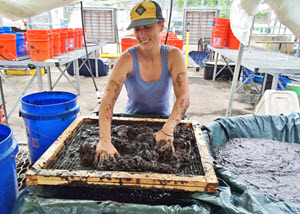
Postdoc Brittany Bernik strains marsh mud through a screen to prepare it for greenhouse experiments at Tulane University. (Photo by Sunshine Van Bael)
Living inside the roots and leaf tissues of marsh grass are bacteria and fungi known as endophytes that help promote plant growth. Since some endophytes can also help degrade petroleum that the plants absorb, it is possible they could be a natural tool to help clean up oil buried in marsh soils.
The Gulf of Mexico Research Initiative (GoMRI) recently awarded Dr. Sunshine Van Bael a grant to explore plant-bacterial symbioses as they relate to petroleum and dispersant pollution in coastal salt marshes. Her team is investigating how endophyte communities inside oiled coastal plants incorporate and amplify oil-degrading bacteria and if plants can deliver endophytic bacteria to polluted soils, hastening petroleum biodegradation. The team will use their findings to learn how plant-bacterial combinations may be used to quickly and safely restore oiled marshes.
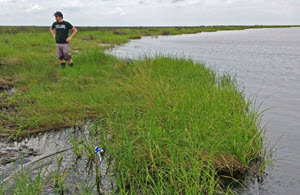
Ph.D. student Stephen Formel helps collect soil at Bay Jimmy in Barataria Bay. (Photo by Brittany Bernik)
Preliminary research suggests that when coastal grasses are contaminated with petroleum, the bacterial communities in their tissues incorporate more taxa with petroleum tolerance and biodegradation capabilities. However, these processes are not well characterized. Improving our understanding about the mechanisms driving how grasses, symbiotic bacteria, and polluted soil interact could lead to the development of tools that use plant-delivered, naturally occurring bacteria to clean up polluted soils.
The team is conducting field work and controlled greenhouse experiments to identify how bacteria and bacterial communities behave in oiled and unoiled sites and determine how quickly the oil in soil and plant tissues are broken down. Next, they will investigate the bacteria’s interactions with oil droplets and oxygen and see if plant roots can deliver oxygen and bacteria to oil buried in the marsh soil.

The greenhouse experiment at Tulane University was set up in June 2016 to test how plants and their symbionts work together to clean up oil. (Photo by Stephen Formel)
“We know a lot about how bacteria break down oil in the ocean and on the beach, but we haven’t really investigated if and how this happens inside of the plant,” said Van Bael. “We hope to learn how plants and their microbial symbionts can influence oil spill clean-up, especially the possibility that the best tool to help clean up oil in buried marsh soils faster is plant-bacterial combinations.”
The project’s researchers are Sunshine Van Bael, Kyriakos D. Papadopoulos, Michael Blum, and Lisa Fauci of Tulane University, Claudia Gunsch of Duke University, and John Pardue of Louisiana State University. Their project is Chemical Evolution and Plant-Microbe Degradation of Petroleum in Saline Marsh Plants and Soils.
************
The Gulf of Mexico Research Initiative (GoMRI) is a 10-year independent research program established to study the effect, and the potential associated impact, of hydrocarbon releases on the environment and public health, as well as to develop improved spill mitigation, oil detection, characterization and remediation technologies. An independent and academic 20-member Research Board makes the funding and research direction decisions to ensure the intellectual quality, effectiveness and academic independence of the GoMRI research. All research data, findings and publications will be made publicly available. The program was established through a $500 million financial commitment from BP. For more information, visit http://gulfresearchinitiative.org/.
Science at the Stadium Scores Big with Game-Day Attendees
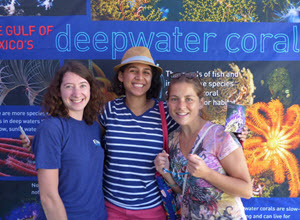
Graduate student Fanny Girard (left) joins game-day fans at the ECOGIG-II Ocean Discovery Zone. The coral banner makes a beautiful photo backdrop! (Photo by ECOGIG-II)
Scientists and education staff have tapped into a novel venue – football games – to reach new audiences and share ongoing research and ocean technology. The research consortium Ecosystem Impacts of Oil and Gas Inputs to the Gulf II (ECOGIG II), funded by the Gulf of Mexico Research Initiative (GoMRI), took their mobile Ocean Discovery Zone on the road to State College, PA for the Penn State Nittany Lions season opener.
“Football is a passion for people around the country, and a remarkable number of people fill stadiums every Saturday in the fall,” explained Sara Beresford, the Communications and Outreach Lead for ECOGIG-II, on why they chose this venue. “Hosting our exhibit during tailgating, we’re able to interact with and reach people who might not otherwise seek out the information we can provide.”
Visitors can drive a model Remotely Operated Vehicle (ROV) to learn about an important piece of technology used in deep ocean research. Visitors also can build deepwater corals, see a model of a natural hydrocarbon seep, and view video content and information displays about the Gulf and deepsea exploration. Game-day fans can attend four more Ocean Discovery Zone events in the southeast this year.

A: Graduate student Sarah Harrison explains to young fans how scientists use ROV (Remotely Operated Vehicle) technology. Visitors can drive the model ROV and earn honorary ECOGIG Pilot’s Licenses. B: A coral enthusiast built a replica of the deepwater coral polyp displayed on one of our tent sidewalls. C: Pen State fans used the ROVs to collect replications of deep sea animals from the bottom of the tank and learned about life in the deepest parts of the Gulf of Mexico. D: ECOGIG education and outreach lead Sara Beresford helps fans build deepwater corals to take home. This station was quite popular with everyone! E: Pen State fans used the ROVs to collect replications of deep sea animals from the bottom of the tank and learned about life in the deepest parts of the Gulf of Mexico. F: This young fan enjoyed playing Gulf of Mexico themed cornhole! (All Photos by ECOGIG-II)
“For me, the most exciting part of the program is the opportunity to engage with visitors – both children and adults – and share stories with them about our work and its relevance for the Gulf of Mexico and the global oceans,” said Dr. Samantha Joye, the Director of ECOGIG-II. “I’m always impressed by the questions I’m asked and by the enthusiasm I see, especially in young people. Seeing these young kids get inspired and start asking thought-provoking questions about the Gulf of Mexico and oceans in general is really special.”
Fans met several scientists at Penn State, including ECOGIG-II co-Principal Investigators Dr. Charles Fisher and Dr. Iliana Baums, and learned about their research on the unique deepwater coral communities in the Gulf.
Want to join the fun? The 2016 Science in the Stadium schedule is available here.
Read more about ECOGIG II and their research on their website and Facebook page.
Read about last year’s events at What a Matchup! SEC Football and Science at the Stadium.
************
The GoMRI is a 10-year independent research program established to study the effect, and the potential associated impact, of hydrocarbon releases on the environment and public health, as well as to develop improved spill mitigation, oil detection, characterization and remediation technologies. An independent and academic 20-member Research Board makes the funding and research direction decisions to ensure the intellectual quality, effectiveness and academic independence of the GoMRI research. All research data, findings and publications will be made publicly available. The program was established through a $500 million financial commitment from BP. For more information, visit http://gulfresearchinitiative.org/.
Video: Close Encounters with a Sperm Whale
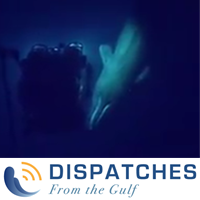
Professor Scott Socolofsky at Texas A&M University witnesses an unexpected visitor of the cetacean kind while conducting deep-sea research in the Gulf of Mexico.
Share your thoughts at the following “Dispatches from the Gulf” Social Media links:
++++++++++++++++++++++++++++++++++
“Dispatches from the Gulf” is a new Journey to Planet Earth (J2PE) episode showing how scientists confront the challenges of the Deepwater Horizon oil spill. The documentary also investigates the impact of the event on the ecosystems and communities along the Gulf of Mexico.
J2PE dramatizes new ways of looking at the delicate relationship between people and the world they inhabit. The series is designed to help viewers understand and cope with the most important environmental issues of the 21st century.
Through an interdisciplinary approach, these programs reach beyond the physical sciences and draw connections to politics, economics, sociology, and history. A common thread runs throughout — the necessity to achieve a balance between the needs of people and the needs of the environment. Though photographed on different continents and focusing on different sets of problems, audiences come to see why all of these stories are connected, providing a dramatic mosaic of how the Earth works as an interrelated system.
Screenscope Releases 50 Short Videos to Accompany Dispatches from the Gulf Documentary
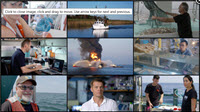
Screenscope, Inc., is pleased to announce the release of 50 short videos complementing the Dispatches from the Gulf documentary film.
The videos include highlights from the film, interviews with Gulf of Mexico Research Initiative (GoMRI)-funded scientists and graduate students, and more. An associated Educators Guide provides detailed descriptions and keywords for each video. The videos were generated as an extension of the film, to be used in classroom curriculum and in other educational efforts.
- The 50 Shorts Videos are available here on the Dispatches from the Gulf
- The Educators Guide can be found here.
- If you are an educator, or know someone who is, you can request a free copy of the Dispatches from the Gulf DVD to use in your classroom here.
- More information about the Dispatches from the Gulf documentary is available here and here.
****************************
Dispatches from the Gulf is made possible in part by a grant from the Gulf of Mexico Research Initiative. The GoMRI is a 10-year independent research program established to study the effect, and the potential associated impact, of hydrocarbon releases on the environment and public health, as well as to develop improved spill mitigation, oil detection, characterization and remediation technologies. An independent and academic 20-member Research Board makes the funding and research direction decisions to ensure the intellectual quality, effectiveness and academic independence of the GoMRI research. All research data, findings and publications will be made publicly available. The program was established through a $500 million financial commitment from BP.
Now Available! GoMRI and Oil Spill Science Special Issue of Oceanography
The Gulf of Mexico Research Initiative (GoMRI) is pleased to announce a special issue of Oceanography Magazine: GoMRI: Deepwater Horizon Oil Spill and Ecosystem Science.
This special issue – a collaborative effort among scientists funded by GoMRI, the GoMRI Research Board, and the GoMRI management team – highlights scientific advances from the program. Twenty papers covering topics that range from how the spill affected marine ecosystems and the fate of oil in the marine environment, to data management, and education and outreach initiatives. Leading this effort were co-editors John Shepherd, Richard Shaw, Debra Benoit, Kenneth Halanych, and Charles Wilson.
To date, more than 3,000 GoMRI-funded researchers representing 278 institutions in 42 states and 17 countries have produced approximately 800 peer-reviewed publications. Continuing productivity of these and other GoMRI-funded scientific teams and individuals will ensure significant contributions to science, engineering, and outreach long after the GoMRI program has ended. The most powerful legacy of GoMRI will be the 2,000 young oil-spill scientists (post-doctoral fellows, graduate students and undergraduates) who are currently working or have worked alongside senior scientists.
Special issues of journals (like this Oceanography special issue), film documentaries, and partnerships with outreach organizations also comprise a significant component of the GoMRI legacy, and not least of which is the program itself, as Research Board Chair Dr. Rita Colwell has articulated, namely that
“GoMRI provides an excellent model for industry to play a significant role in supporting independent, open, scientific research to foster discovery and at the same time help solve societal problems, inform decision-making, and address future environmental and public health challenges.”
A PDF copy of the special issue is available for purchase and download here.
Fact Sheet: Coastal Louisiana Flora and Fauna Fact-Sheets
These fact sheets highlight various flora and fauna living in the south Louisiana marshes.
Click the images below to download copies of these posters to share with your students.
Visit the Coastal Water Consortium’s Education & Outreach website for more information.
Video: Exquisite Mud: A History Book of the Gulf of Mexico
![]() A team of researchers from the University of South Florida uses a multi-corer to obtain deep sediment cores from the Gulf of Mexico. Back in the lab, they analyze the layers of sediment and build a history of the Gulf, with Deepwater Horizon being the latest chapter.
A team of researchers from the University of South Florida uses a multi-corer to obtain deep sediment cores from the Gulf of Mexico. Back in the lab, they analyze the layers of sediment and build a history of the Gulf, with Deepwater Horizon being the latest chapter.
Featuring oceanographers David Hollander, Isabel Romero, and Patrick Schwing.
Share your thoughts at the following “Dispatches from the Gulf” Social Media links:
++++++++++++++++++++++++++++++++++
“Dispatches from the Gulf” is a new Journey to Planet Earth (J2PE) episode showing how scientists confront the challenges of the Deepwater Horizon oil spill. The documentary also investigates the impact of the event on the ecosystems and communities along the Gulf of Mexico.
J2PE dramatizes new ways of looking at the delicate relationship between people and the world they inhabit. The series is designed to help viewers understand and cope with the most important environmental issues of the 21st century.
Through an interdisciplinary approach, these programs reach beyond the physical sciences and draw connections to politics, economics, sociology, and history. A common thread runs throughout — the necessity to achieve a balance between the needs of people and the needs of the environment. Though photographed on different continents and focusing on different sets of problems, audiences come to see why all of these stories are connected, providing a dramatic mosaic of how the Earth works as an interrelated system.
Video: What’s At Stake?
![]() The Gulf of Mexico’s coastal wetlands and marshes are home to thousands of species of plants and animals – and its beaches help support a hundred billion-dollar tourist industry. It’s also a place whose waters provide 40% of the commercial seafood caught in the lower 48 States.
The Gulf of Mexico’s coastal wetlands and marshes are home to thousands of species of plants and animals – and its beaches help support a hundred billion-dollar tourist industry. It’s also a place whose waters provide 40% of the commercial seafood caught in the lower 48 States.
After 87 days of oil spewing into the Gulf, the beaches and salt marshes were hit hard. Hundreds of thousands of marine animals and birds died. Tourists abandoned the beaches. And watermen were unable to work. The oil spill put at stake not only a way of life, but also the future of one of the most biologically fertile regions in the world.
The creators of award-winning environmental series Journey to Planet Earth (hosted by Matt Damon) present Dispatches from the Gulf – an upcoming documentary film and educational outreach initiative highlighting exclusive scientific discoveries in health, ecosystems, innovation and recovery in the post-oil spill Gulf of Mexico.
Share your thoughts at the following “Dispatches from the Gulf” Social Media links:
++++++++++++++++++++++++++++++++++
“Dispatches from the Gulf” is a new Journey to Planet Earth (J2PE) episode showing how scientists confront the challenges of the Deepwater Horizon oil spill. The documentary also investigates the impact of the event on the ecosystems and communities along the Gulf of Mexico.
J2PE dramatizes new ways of looking at the delicate relationship between people and the world they inhabit. The series is designed to help viewers understand and cope with the most important environmental issues of the 21st century.
Through an interdisciplinary approach, these programs reach beyond the physical sciences and draw connections to politics, economics, sociology, and history. A common thread runs throughout — the necessity to achieve a balance between the needs of people and the needs of the environment. Though photographed on different continents and focusing on different sets of problems, audiences come to see why all of these stories are connected, providing a dramatic mosaic of how the Earth works as an interrelated system.
Video: Invasion of the Lionfish
![]() Will Patterson at Dauphin Island Sea Lab studies reef fish communities and the dramatic effect the non-native lionfish are having on native fish populations.
Will Patterson at Dauphin Island Sea Lab studies reef fish communities and the dramatic effect the non-native lionfish are having on native fish populations.
Share your thoughts at the following “Dispatches from the Gulf” Social Media links:
++++++++++++++++++++++++++++++++++
“Dispatches from the Gulf” is a new Journey to Planet Earth (J2PE) episode showing how scientists confront the challenges of the Deepwater Horizon oil spill. The documentary also investigates the impact of the event on the ecosystems and communities along the Gulf of Mexico.
J2PE dramatizes new ways of looking at the delicate relationship between people and the world they inhabit. The series is designed to help viewers understand and cope with the most important environmental issues of the 21st century.
Through an interdisciplinary approach, these programs reach beyond the physical sciences and draw connections to politics, economics, sociology, and history. A common thread runs throughout — the necessity to achieve a balance between the needs of people and the needs of the environment. Though photographed on different continents and focusing on different sets of problems, audiences come to see why all of these stories are connected, providing a dramatic mosaic of how the Earth works as an interrelated system.
Video: Watermen of the Gulf
![]() Fisherfolk share their feelings about working and living along the Gulf of Mexico.
Fisherfolk share their feelings about working and living along the Gulf of Mexico.
Share your thoughts at the following “Dispatches from the Gulf” Social Media links:
++++++++++++++++++++++++++++++++++
“Dispatches from the Gulf” is a new Journey to Planet Earth (J2PE) episode showing how scientists confront the challenges of the Deepwater Horizon oil spill. The documentary also investigates the impact of the event on the ecosystems and communities along the Gulf of Mexico.
J2PE dramatizes new ways of looking at the delicate relationship between people and the world they inhabit. The series is designed to help viewers understand and cope with the most important environmental issues of the 21st century.
Through an interdisciplinary approach, these programs reach beyond the physical sciences and draw connections to politics, economics, sociology, and history. A common thread runs throughout — the necessity to achieve a balance between the needs of people and the needs of the environment. Though photographed on different continents and focusing on different sets of problems, audiences come to see why all of these stories are connected, providing a dramatic mosaic of how the Earth works as an interrelated system.
RFP-V Huettel: Biodegradation & Ecosystem Recovery in Coastal Marine Sediments
Markus Huettel gives an overview of the project at the Gulf of Mexico Oil Spill & Ecosystem Science Conference January 2016
The A systems approach to improve predictions of biodegradation and ecosystem recovery in coastal marine sediments impacted by oil spill project is lead by P.I. Markus Huettel, Florida State University.
After coastal oil spills, petroleum hydrocarbons accumulate in submerged nearshore sediments and on beaches, poisoning these ecosystems and creating health risks for coastal organisms and humans. Erosion and deposition cycles lead to burial of weathered crude oil in submerged shelf beds, intertidal sediments, and dry beach sands. Prediction of the effects and fate of these buried petroleum hydrocarbons remains hampered by our limited understanding of the controls of the biodegradation and functioning of sedimentary microbial communities that break down petroleum hydrocarbons. Transport of oxygen and nutrients to the buried oil is expected to control the rates of hydrocarbon biodegradation. While the flow of air through dry beach sands can rapidly transport oxygen to buried oil, it cannot carry nutrients that are limiting the degradation of the oil. Transport via pore water flows in submerged sand beds is slower than the gas transport in dry sand, but water can transport dissolved nutrients to buried hydrocarbons. It is therefore hypothesized that microbial oil degradation in dry, temporally wet and water-saturated sediments differ. A quantitative understanding of the mechanisms controlling these differences is a central prerequisite for the modeling of oil decomposition in these coastal ecosystems. The main goals of this project therefore are to link microbial degradation of buried oil and associated transport processes, and to integrate these data in a model that allows predictions of pathways and rates of oil degradation, and thus, forecasting recovery pathways in future oil spills. Specific objectives are to:
1. Determine microbial community structure and succession associated with petroleum hydrocarbons buried in sub-, inter- and supratidal coastal sands using in-situ measurements and controlled laboratory mesocosm incubations that simulate in-situ conditions.
2. Quantitatively link supply rates of oxygen and nutrients to microbial oil degradation rates and community structure in these sands.
3. Develop a model using a systems approach that incorporates microbiological, genomics, biogeochemical and transport data to predict decomposition rates of buried oil in sub, inter- and supratidal beach sands.
4. Organize a two-day workshop for disseminating our models and associated bioinformatics tools for multi-omics data analysis and integration to the GoMRI research community.
This project that contributes to GoMRI RFP V research theme (2) couples cutting-edge microbiological and geochemical approaches in the field with targeted laboratory experiments, genomic analyses and predictive mathematical modeling. In the experiments, biodegradation rates of specific hydrocarbon compounds are linked to the metabolic potential of microbial groups using a combination of metagenomic and metatranscriptomic sequencing and culture-based physiological and genetic manipulations. A distinguishing aspect of this research is that it will integrate taxonomic, genetic and functional data from complex, multivariate experiments into advanced dynamic models that will represent responses of whole microbial communities and allow predictions of their activities under different levels of oxygen and nutrients. The broader impact of this research is related to the potential environmental and health risks associated with petroleum hydrocarbons still persisting in the coastal environment. Covered by anoxic sediment, oil may persist in largely un-weathered form and thus may contain relatively large concentrations of harmful oil components (PAHs) that can be released during storm events. The project will produce tools (e.g., models and microbial indicators of oil degradation) for environmental managers and decision makers that can help planning responses to future oil spills.
Click for access to GoMRI’s YouTube videos of RFP-V Projects…
This project was funded by the Gulf of Mexico Research Initiative (GoMRI) in the RFP-V funding program.
The Gulf of Mexico Research Initiative (GoMRI) is a 10-year independent research program established to study the effect, and the potential associated impact, of hydrocarbon releases on the environment and public health, as well as to develop improved spill mitigation, oil detection, characterization and remediation technologies. An independent and academic 20-member Research Board makes the funding and research direction decisions to ensure the intellectual quality, effectiveness and academic independence of the GoMRI research. All research data, findings and publications will be made publicly available. The program was established through a $500 million financial commitment from BP. For more information, visit http://gulfresearchinitiative.org/.
Grad Student Boyette Maps Plankton to Better Understand the Nearshore Environment
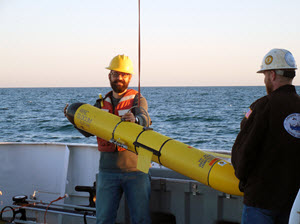
Adam Boyette retrieves a glider on the deck of the R/V Point Sur, where he served as chief scientist on the three-day cruise examining the impacts of the Bonnet Carré spillway opening. (Photo by Alison Deary)
Microscopic organisms called plankton, an important component of the marine food web, congregate in the freshwater-laden coastal waters of the northern Gulf of Mexico. Adam Boyette wants to learn more about how and where these plankton live to better understand how an oil spill or other disaster might impact their populations.
He is collaborating with other scientists to show how the near-coastal environment interconnects with the larger world around it.
Adam is a GoMRI Scholar with CONCORDE working towards a Ph.D. in marine science at the University of Southern Mississippi (USM). He discusses his journey from the Mississippi Delta to the coastal Gulf he now calls home.
His Path
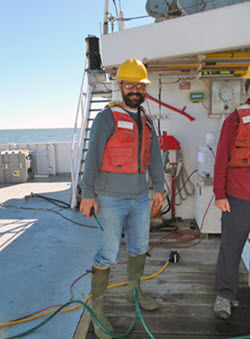
Adam stands by on the deck of the R/V Point Sur to retrieve the CTD rosette. (Photo by Alison Deary)
Adam grew up in a rural town at the heart of the Mississippi Delta, an area made famous by Muppets-creator Jim Henson and blues music. He spent his childhood outdoors collecting insects and snakes, fishing, and exploring the Delta’s rich ecology.
His first visit to the Florida panhandle at age eight sparked a life-long love of the ocean that would eventually steer his future.
Adam did not begin college immediately after high school. Instead, he worked on Mississippi River tow boats and in catering kitchens, discovering new interests and skills in every job. He would earn a bachelor’s degree in marine biology at USM more than ten years after he graduated from high school, immediately complete a master’s degree in marine science, and then move on to his Ph.D.
“I had this unfulfilled yearning to do something meaningful, something where I could contribute,” Adam said, explaining that living through the one-two punch of Katrina and the oil spill deeply affected him. “You want to be part of something bigger than you are. I knew without a doubt that I wanted to be a marine scientist.” Adam joined several research cruises while working as a graduate assistant for ECOGIG co-principle investigator Vernon Asper, including the successful effort to rescue the downed AUV Mola Mola. Familiar with GoMRI’s mission, he jumped at the chance to join CONCORDE director Monty Graham’s lab when the consortium formed in 2015.
His Work
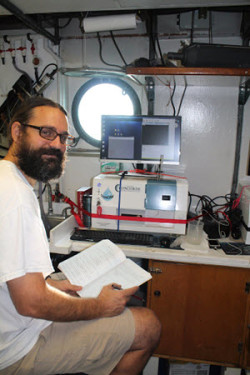
Adam takes notes in the R/V Point Sur’s lab while his FlowCam analyzes samples. (Photo by Alison Deary)
Adam studies the thin layers of plankton common in the coastal Gulf of Mexico water column. He measures the plankton’s photosynthesis processes to better understand their uptake and primary production rates of carbon. He also investigates how frequently other organisms, namely predatory microzooplankton, graze on these plankton concentrations. This information will help researchers understand how pollutants like oil move through the area and what living creatures they impact.
Adam collects seawater within the Mississippi Bight, a coastal environment dominated by river water plumes that mix and merge with the salty Gulf. He has joined other CONCORDE scientists on three larger research cruises and sampled on his own in small crafts. “When I’m not actually on a research cruise, I’m either preparing to go on one or analyzing data from a previous one,” he laughed.
Adam determines carbon uptake rates in his samples using an incubator called a photosynthetron, which simulates the in situ light environment and uses the resulting vertical light gradient to measure photosynthetic rates. He uses this information to calculate plankton’s carbon production and uptake and to estimate changes in phytoplankton abundance and growth over a 24-hour period.
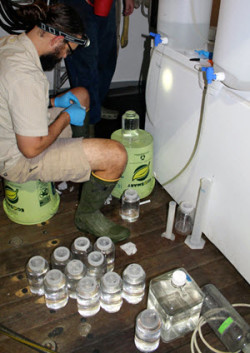
Adam works on dilution experiments during the early morning hours of a cruise. (Provided by Adam Boyette)
He also conducts experiments to examine grazing rates for microzooplankton feeding on phytoplankton. Then, he runs the samples through a particle imaging device called a FlowCAM to identify organisms in the water, allowing him to determine how many and which plankton and predatory microzooplankton species live in his study area.
Adam uses this information to understand the dynamics of nearshore microbial populations during various seasons. His calculations will be incorporated into a large ecological model that CONCORDE scientists are creating to represent the physical, chemical, and biological processes in the nearshore environment. “My motivation is to understand the connectivity between all things, to show how delicate the interplay is between the world we see and the microbial world,” he explained. “It’s a personal fascination.” Adam’s raw data collected through his CONCORDE research are available through the Gulf of Mexico Research Initiative Information and Data Cooperative (GRIIDC).
His Learning
“As Dr. Graham’s student, I’ve learned a lot about working collectively to achieve a common goal,” Adam said. “He’s provided wonderful leadership opportunities for emerging scientists to learn and grow.” One such opportunity came earlier this year, when Adam served as the chief scientist on an emergency three-day multi-consortia cruise to study the Bonnet Carré spillway opening, an action taken to protect New Orleans from rising Mississippi River floodwaters that sent millions of gallons of freshwater into the northern Gulf. He and other GoMRI scientists attending the Gulf of Mexico Oil Spill and Ecosystem Science Conference discussed how the unusual event might impact their study areas and planned the cruise.
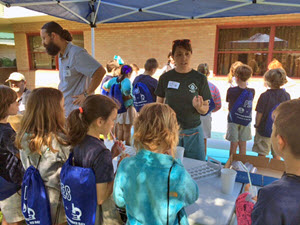
Adam and fellow graduate student Naomi Yoder teach Pontchartrain Elementary students about nearshore ecology during an Earth Science Day event. (Photo by Stephanie Watson)
The cruise included scientists from CONCORDE, DEEPEND, ECOGIG,CARTHE, and ACER. Adam took pleasure in seeing the process through from its somewhat chaotic inception to a highly organized research event, drawing on his experiences working in professional kitchens to keep everything running smoothly. The array of cross-disciplinary GoMRI scientists also helped make the project a success. “The most important thing I learned from this experience was to let go,” Adam said of his chief scientist position. “Put your trust in people and don’t try to be in control of everything. Instead, work with everyone and utilize their expertise – these people are here for a reason.”
His Future
Adam plans to finish his doctoral program in May 2018. He wants to continue researching plankton ecology using technologies such as satellite imaging and the FlowCam. His dream is to become an ongoing water quality project manager working for government agencies such as NOAA or the EPA or in a postdoctoral role at a university. “The oil spill has really shown the importance of long-term datasets,” Adam said.

Adam and fellow USM student Liesl Cole work in the R/V Point Sur’s highly secure radioisotope lab (known as the “rad van”) during the CONCORDE Spring Campaign. (Photo by Heather Dippold)
Praise for Adam
Monty Graham serves as both CONCORDE’s principle investigator and the Director of USM’s School of Ocean Science and Technology. He stated, “I can attest to Adam’s maturity, leadership potential, technical skills, and motivation and am thrilled that he is being recognized for his efforts.” Graham called Adam a critical member of the CONCORDE project, “He has been the student that his peers look up to, and a student that my research colleagues seek for advice. He pursues every opportunity to increase his knowledge within his chosen field, and has learned new technologies that are going to be applied widely in our studies.”
Graham explained that Adam shines in leadership roles, receiving “stellar reviews” from everyone involved in the Bonnet Carré cruise. “He has led his fellow students through trainings and scientific discussions and he is respected by his peers and senior scientists alike,” said Graham. “He is an excellent addition to the GoMRI Scholar program and is the definition of student success.”
The GoMRI community embraces bright and dedicated students like Adam Boyette and their important contributions. The GoMRI Scholars Program recognizes graduate students whose work focuses on GoMRI-funded projects and builds community for the next generation of ocean science professionals. Visit the CONCORDE website to learn more about their work.
************
This research was made possible in part by a grant from The Gulf of Mexico Research Initiative (GoMRI). The GoMRI is a 10-year independent research program established to study the effect, and the potential associated impact, of hydrocarbon releases on the environment and public health, as well as to develop improved spill mitigation, oil detection, characterization and remediation technologies. An independent and academic 20-member Research Board makes the funding and research direction decisions to ensure the intellectual quality, effectiveness and academic independence of the GoMRI research. All research data, findings and publications will be made publicly available. The program was established through a $500 million financial commitment from BP. For more information, visit http://gulfresearchinitiative.org/.
Video: Meet Nancy Rabalais – Focusing on Coastal Ecosystems
![]() Professor Nancy Rabalais (LUMCON) and her team focus their research on the effects of the Deepwater Horizon Oil Spill on coastal ecosystems – particularly the Louisiana wetlands and marshes.
Professor Nancy Rabalais (LUMCON) and her team focus their research on the effects of the Deepwater Horizon Oil Spill on coastal ecosystems – particularly the Louisiana wetlands and marshes.
Consortia: CWC I and CWC II
Themes: Physical, Chemical, Environmental
Share your thoughts at the following “Dispatches from the Gulf” Social Media links:
++++++++++++++++++++++++++++++++++
“Dispatches from the Gulf” is a new Journey to Planet Earth (J2PE) episode showing how scientists confront the challenges of the Deepwater Horizon oil spill. The documentary also investigates the impact of the event on the ecosystems and communities along the Gulf of Mexico.
J2PE dramatizes new ways of looking at the delicate relationship between people and the world they inhabit. The series is designed to help viewers understand and cope with the most important environmental issues of the 21st century.
Through an interdisciplinary approach, these programs reach beyond the physical sciences and draw connections to politics, economics, sociology, and history. A common thread runs throughout — the necessity to achieve a balance between the needs of people and the needs of the environment. Though photographed on different continents and focusing on different sets of problems, audiences come to see why all of these stories are connected, providing a dramatic mosaic of how the Earth works as an interrelated system.
Video: It Was Just A Scary, Scary Time
![]() Louisiana waterman David Chauvin describes how the shrimping community in the Gulf is used to dealing with and recovering from natural disasters like hurricanes, but the man-made disaster that was Deepwater Horizon has left them unsure of how to move forward. The unknown duration and depth of the oil spill’s impact has instilled fear among those who work the waters of the Gulf of Mexico.
Louisiana waterman David Chauvin describes how the shrimping community in the Gulf is used to dealing with and recovering from natural disasters like hurricanes, but the man-made disaster that was Deepwater Horizon has left them unsure of how to move forward. The unknown duration and depth of the oil spill’s impact has instilled fear among those who work the waters of the Gulf of Mexico.
Share your thoughts at the following “Dispatches from the Gulf” Social Media links:
++++++++++++++++++++++++++++++++++
“Dispatches from the Gulf” is a new Journey to Planet Earth (J2PE) episode showing how scientists confront the challenges of the Deepwater Horizon oil spill. The documentary also investigates the impact of the event on the ecosystems and communities along the Gulf of Mexico.
J2PE dramatizes new ways of looking at the delicate relationship between people and the world they inhabit. The series is designed to help viewers understand and cope with the most important environmental issues of the 21st century.
Through an interdisciplinary approach, these programs reach beyond the physical sciences and draw connections to politics, economics, sociology, and history. A common thread runs throughout — the necessity to achieve a balance between the needs of people and the needs of the environment. Though photographed on different continents and focusing on different sets of problems, audiences come to see why all of these stories are connected, providing a dramatic mosaic of how the Earth works as an interrelated system.
Bringing Marine Snow to the Oil Transport Forecast
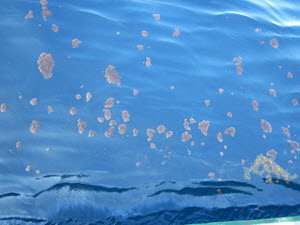
A photograph of oil-marine snow aggregates at the water’s surface in the Gulf of Mexico, May 2011. (Photo by Andrew Warren)
Evidence suggests that when oil interacts with particles in the marine environment, it can form larger, rapidly sinking particles called marine snow.
These oily aggregates are often transported from the sea surface to the seafloor. The snow falls more like a heavy blizzard than a light flurry for large discharges such as the Deepwater Horizon spill and could present a pathway for oil to enter the food web as it descends. Recent research indicates that oil transported to the seafloor is an important piece in calculating the oil budget. However, oil transported via marine snow is rarely incorporated into oil transport models, which focus on the distribution of oil by currents.
The Gulf of Mexico Research Initiative recently awarded Dr. Adrian Burd a grant to develop a model with parameters that can predict how oil will interact with other particles present in the marine environment. Burd’s team will then use this model to investigate how these interactions affect oil sedimentation to the deep ocean. Burd explained, “It is important to understand the mechanisms behind oil-particle interactions and processes because, although these aggregates remove oil from surface waters, they also cause oil to be deposited on the ocean floor.”
 The schematic (at right) depicts the interactions between oil, mineral particles, and marine snow in the water column. Oil droplets in the water column can create aggregates with mineral particles and marine snow. These large particles rapidly sink through the water column carrying the oil with them, creating a process that transports oil from the surface to the deep ocean. Sinking particles that pass through sub-surface oil layers can accumulate and carry even more oil to the ocean floor. Meanwhile, oil that reaches the surface can form large mucus-oil aggregates which can also subsequently sink to the ocean floor. (Figure by Adrian Burd).
The schematic (at right) depicts the interactions between oil, mineral particles, and marine snow in the water column. Oil droplets in the water column can create aggregates with mineral particles and marine snow. These large particles rapidly sink through the water column carrying the oil with them, creating a process that transports oil from the surface to the deep ocean. Sinking particles that pass through sub-surface oil layers can accumulate and carry even more oil to the ocean floor. Meanwhile, oil that reaches the surface can form large mucus-oil aggregates which can also subsequently sink to the ocean floor. (Figure by Adrian Burd).
The researchers plan to incorporate oil droplets, mineral particles, microbial mucus flocs, and the relevant processes affecting them (such as weathering and microbial production) into an existing coagulation model. First, they will develop a surface model extending from the ocean surface to 140 meters depth and begin constructing parameters that will predict the microbial-mucus-oil aggregates’ sizes and the rates at which they form and sink through the water column. Then, they will extend the model through the whole water column and incorporate the effects of oil-particle interactions and oil sedimentation rates.
The full model will allow the team to predict how much oil is trapped in these sinking aggregates and how rapidly it settles under a wide range of conditions. Burd emphasized the utility of this model, “This information will be useful not only to understanding the fate of oil in water but also to first-responders, who will need to know how the oil is distributed in the water.”
This project’s researchers are Adrian Burd at the University of Georgia Department of Marine Science, Kendra Daly at the University of South Florida College of Marine Science, and Uta Passow at the University of California – Santa Barbara Marine Science Institute with outreach support from Liesl Hotaling at the University of South Florida College of Marine Science. Their project is Oil-Marine Snow-Mineral Aggregate Interactions and Sedimentation during the 2010 Deepwater Horizon Oil Spill.
************
The Gulf of Mexico Research Initiative (GoMRI) is a 10-year independent research program established to study the effect, and the potential associated impact, of hydrocarbon releases on the environment and public health, as well as to develop improved spill mitigation, oil detection, characterization and remediation technologies. An independent and academic 20-member Research Board makes the funding and research direction decisions to ensure the intellectual quality, effectiveness and academic independence of the GoMRI research. All research data, findings and publications will be made publicly available. The program was established through a $500 million financial commitment from BP. For more information, visit http://gulfresearchinitiative.org/.
RFP-V Foil: Horse Fly Populations & Food Web Dynamics as Stress Indicators on Coastal Marsh
Claudia Husseneder gives an overview of the project at the Gulf of Mexico Oil Spill & Ecosystem Science Conference January 2016
A Study of horse fly (Tabanidae) populations and their food web dynamics as indicators of the effects of environmental stress on coastal marsh health project is lead by P.I. Lane Foil, Louisiana State University Ag Center.
Within the tidal marshes of Louisiana the PAH levels in subsurface water in the marsh locations remained high enough to have lethal effects on fish for up to two months, and it has been shown that high levels of oil were retained in the sediment of oiled marsh for much longer. Whether oil components remain in sediments of certain tidal marsh habitats and what effect these residues or degradation caused by oiling have on the invertebrate food web of vertebrates and invertebrates is now an important question. The aftermath of the oil spill provides unprecedented research opportunities for years to come. Tools must be developed not only to assess the impact of a particular oil spill but also to provide screening methods for time- and cost-efficient assessments of marsh health after future environmental insults to help guide remediation efforts. For future unpredicted insults on tidal marshes such as oil spills, techniques for rapid and intensive baseline sample collections with minimum impact on the fragile ecosystem will be needed.
During a two year period beginning immediately after the spill, we conducted studies on the abundance of greenhead horse fly populations at four locations (Grand Bayou and Grand Isle which were oiled and Cypremort Point and Cameron which remained pristine). Horse fly abundance estimates showed severe crashes of adult tabanid populations as well as reduced numbers of larvae recovered from the soil in oiled areas. We propose to follow up that study with a longitudinal population genetic study of horse flies as bioindicators of marsh health and recovery. In 2011, we conducted surveys of tabanid larvae and their surrounding sediment, and specimens were archived to initiate studies on establishing the food web within the sediments. We propose to use those and future collections for metagenetic analyses to compare the micro- and meiofauna community in larval guts to that in the immediate soil environment where tabanid larvae are either present or absent. Based on this knowledge we will develop a time- and cost-efficient PCR-based diagnostic method to differentiate between healthy and biologically depleted marsh soil for use in intensive sampling.
Click for access to GoMRI’s YouTube videos of RFP-V Projects…
This project was funded by the Gulf of Mexico Research Initiative (GoMRI) in the RFP-V funding program.
The Gulf of Mexico Research Initiative (GoMRI) is a 10-year independent research program established to study the effect, and the potential associated impact, of hydrocarbon releases on the environment and public health, as well as to develop improved spill mitigation, oil detection, characterization and remediation technologies. An independent and academic 20-member Research Board makes the funding and research direction decisions to ensure the intellectual quality, effectiveness and academic independence of the GoMRI research. All research data, findings and publications will be made publicly available. The program was established through a $500 million financial commitment from BP. For more information, visit http://gulfresearchinitiative.org/.
Video: The Mud and Blood Cruise – The Whole Story
![]() The R/V Weatherbird embarks on a two-week research cruise in the Gulf of Mexico. Its mission is to collect and analyze fish and soil samples near the site of the Deepwater Horizon oil spill. Dave Hollander and Steve Murawski from the University of South Florida lead the team of oceanographers. The research is divided into two phases: 1) blood = studying fish communities; 2) mud = coring for sediment samples.
The R/V Weatherbird embarks on a two-week research cruise in the Gulf of Mexico. Its mission is to collect and analyze fish and soil samples near the site of the Deepwater Horizon oil spill. Dave Hollander and Steve Murawski from the University of South Florida lead the team of oceanographers. The research is divided into two phases: 1) blood = studying fish communities; 2) mud = coring for sediment samples.
Share your thoughts at the following “Dispatches from the Gulf” Social Media links:
++++++++++++++++++++++++++++++++++
“Dispatches from the Gulf” is a new Journey to Planet Earth (J2PE) episode showing how scientists confront the challenges of the Deepwater Horizon oil spill. The documentary also investigates the impact of the event on the ecosystems and communities along the Gulf of Mexico.
J2PE dramatizes new ways of looking at the delicate relationship between people and the world they inhabit. The series is designed to help viewers understand and cope with the most important environmental issues of the 21st century.
Through an interdisciplinary approach, these programs reach beyond the physical sciences and draw connections to politics, economics, sociology, and history. A common thread runs throughout — the necessity to achieve a balance between the needs of people and the needs of the environment. Though photographed on different continents and focusing on different sets of problems, audiences come to see why all of these stories are connected, providing a dramatic mosaic of how the Earth works as an interrelated system.
Video: The Story in Sixty Seconds (Dispatches from the Gulf)
![]() The creators of award-winning environmental series Journey to Planet Earth (hosted by Matt Damon) present Dispatches from the Gulf – an upcoming documentary film and educational outreach initiative highlighting exclusive scientific discoveries in health, ecosystems, innovation and recovery in the post-oil spill Gulf of Mexico.
The creators of award-winning environmental series Journey to Planet Earth (hosted by Matt Damon) present Dispatches from the Gulf – an upcoming documentary film and educational outreach initiative highlighting exclusive scientific discoveries in health, ecosystems, innovation and recovery in the post-oil spill Gulf of Mexico.
Published on Jun 22, 2016
Six years after the Deepwater Horizon blowout, an international team of researchers is focused on the Gulf of Mexico. These are some of their stories – intimate portraits of research – innovation – discovery. Stories that speak directly to a nation still recovering from the largest oil spill in U.S. history.
Share your thoughts at the following Dispatches from the Gulf Social Media links:
++++++++++++++++++++++++++++++++++
“Dispatches from the Gulf” is a new Journey to Planet Earth (J2PE) episode showing how scientists confront the challenges of the Deepwater Horizon oil spill. The documentary also investigates the impact of the event on the ecosystems and communities along the Gulf of Mexico.
J2PE dramatizes new ways of looking at the delicate relationship between people and the world they inhabit. The series is designed to help viewers understand and cope with the most important environmental issues of the 21st century.
Through an interdisciplinary approach, these programs reach beyond the physical sciences and draw connections to politics, economics, sociology, and history. A common thread runs throughout — the necessity to achieve a balance between the needs of people and the needs of the environment. Though photographed on different continents and focusing on different sets of problems, audiences come to see why all of these stories are connected, providing a dramatic mosaic of how the Earth works as an interrelated system.
Meet Undergraduate Students Cameron and Oscar!

Oscar and Cameron in front of a cylindrical tank that will be used to house samples. Photo Credit: ADDOMEx
Cameron Jackson, a sophomore, is studying marine biology Texas A&M University at Galveston (TAMUG) and Oscar Agueda is a senior who will be getting his degree in marine science (TAMUG); both students are minoring in chemistry. When asked about career aspirations they stated that they hoped to go on to graduate school. “I want to do deep-sea research; bioluminescence in particular is something that really interests me” says Cameron. Oscar, on the other hand, is more interested in ocean and environmental sciences “So I’m right where I need to be”.
Both students approached Dr. Peter Santschi and Dr. Kathy Schwehr of LOER lab (Laboratory for Oceanographic and Environmental Research) in hopes of gaining valuable research experience. Drs. Santschi and Schwehr are principal investigators for Aggregation and Degradation of Dispersants and Oil by Microbial Exopolymers (ADDOMEx) , one of several consortia that are funded by the Gulf of Mexico Research Initiative to research the impacts of oil spills on the marine environment.
The students have been working to build a roller table that will be used for a set of experiments conducted by ADDOMEx. Advice and specifications for the roller tables have been provided by Dr. Uta Passow, a fellow researcher from the University of California Santa Barbara.
The roller table will be used keep samples of phytoplankton and microbes in constant motion to study the formation of marine snow with and without the addition of oil and Corexit (a common dispersant used to treat oil spills).
“It’s like a shaker table, but for a cylindrical tank”, says Oscar.
“I think my dad put it best,” Cameron explains which a chuckle, “in that the roller table is essentially a glorified hot dog cooker at a convenience store. And this is really the perfect way to think about it because it continually rolls the tanks in a horizontal manner.”
“The roller tables will be used to mimic the movement of water in the ocean” says Cameron. “Stagnant water really doesn’t exist in the ocean, and using standing water in our experiments would create conditions that don’t accurately reflect what is happening in the ocean.”
“It’s been a challenge to invent ways to overcome little problems like ensuring that the screws, bolts, and mounts were the proper size” he goes on. “For the first three or four days I didn’t have a drill, so I put the frame together using a screwdriver. I actually broke the screwdriver.”
When asked how this project has changed their perspectives on how research is done, Cameron stated that he “always imagined that you just buy any instruments you might need, so being told to actually design and build the roller tables was a bit of a surprise.”
“I expected that we would be in the lab most of the time” said Oscar. “Instead we’ve been outside working on the table almost every day, but it’s been fun. I would definitely recommend working in a lab to other students, it looks great on your resume… just be prepared to get sweaty!”
According to Cameron you should “bring a pair of headphones”.
After finishing the roller tables, the students will be moving on to work that will include measuring the tensile strength and hydrophobicity/hydrophilicity of the exopolymeric substances that are produced by the study species of marine phytoplankton and microbes in upcoming experiments.
Follow ADDOMEx on Facebook (www.facebook.com/addomex/), Twitter www.twitter.com/addomex/, and Instagram www.instagram.com/addomex/.
Credit for this story: ADDOMEx
Video: What Happens to Fish When There’s an Oil Spill
CONCORDE’s Mission to Mentor Young Scientists Apparent in Spring Campaign and Beyond
Two postdocs, Ali Deary and Adam Greer, took turns as Chief Scientist aboard the R/V Point Sur during the Consortium for oil spill exposure pathways in Coastal River-Dominated Ecosystems (CONCORDE)’s recent Spring Campaign, while three others—Kemal Cambazoglu, Sabrina Parra, and Inia Soto-Ramos—devised the cruise plan for the R/V Pelican. Earlier in the year PhD student Adam Boyette organized and led a research cruise to study the impacts of the sudden and dramatic opening of the Bonnet Carré spillway, while working alongside Soto-Ramos to marshal CONCORDE’s resources to research a damaging harmful algal bloom in the Gulf. The consortium is also encouraging both postdocs and students to serve as lead authors on papers to be submitted for publication.

PI Ian Church (l) trained Lauren Quas, an USM graduate student, on operating the Multibeam before sending her out on the Point Sur alone during the Fall Campaign. (photo credit: Heather Dippold)
CONCORDE postdocs and students are working in the spotlight—and sometimes outside of their comfort zone—as part of a carefully-crafted, consortium-wide plan to create competent scientists while gathering useful data. Education and Outreach Coordinator Jessie Kastler said, “I’ve never seen so many young scientists put in leadership positions. It’s very much something that’s being done on purpose.”
Grad Student Tang Studies Whale Populations’ Oil Spill Recovery
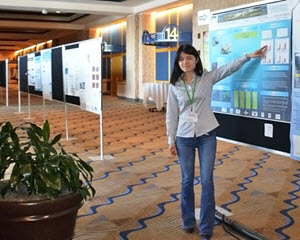
ingting Tang presents her research on whale population recovery at the 2016 Gulf of Mexico Oil Spill & Ecosystem conference in Tampa. (Photo provided by Tang)
When disaster strikes, responders look at how creatures in its path may be impacted to mitigate damage.
Tingting Tang takes the process one step further, using mathematical models to predict how long recovery may take. The creatures that Tingting focuses on are some of the Gulf of Mexico’s largest predators and most charismatic animals, beaked and sperm whales.
Working towards her Ph.D. in Mathematics at the University of Louisiana at Lafayette (UL Lafayette), Tingting is a GoMRI Scholar with the LADC-GEMM consortium. She describes how her love of math led her to study some of the world’s largest creatures.
Her path
Tingting, a native of China, had never been to the United States before pursuing graduate studies in Lafayette. “When I was a child, I had no idea that later in my life I would be studying marine mammals in the Gulf of Mexico,’ she recalled.

Sperm whales photographed by Franco Banfi (Copyright, Franco Banfi, all rights reserved. Image provided here as fair use for education purposes and to acquaint new viewers with Banfi’s work)
Always up for a challenge, Tingting found math appealing because it was the most difficult subject in school; however, as she grew older, she became captivated with it and its ‘simple beauty.’ Later she learned that math could address questions about her country’s large population. Tingting explained, “The idea of studying population structures became more attractive to me as I learned about powerful tools in mathematics.”
This interest led her to seek advanced math programs, and she earned degrees in applied mathematics and computer science from the East China University of Technology and Science in 2012. She took a big step away from home, enrolling in the UL Lafayette mathematics graduate program and then earning a Master’s degree with a concentration in applied mathematics.
UL mathematics and physics departments had ongoing studies on Gulf marine mammal populations that inspired Tingting to initially focus her research on disease epidemics. Her advisor Dr.Azmy Ackleh was impressed with her work and encouraged Tingting to join him and the LADC-GEMM team assessingDeepwater Horizon oil spill impacts on marine mammals. “I was very excited to be on the project,” said Tingting. “This was a great opportunity to apply what I have learned to a timely and interesting real world problem.”
Her work
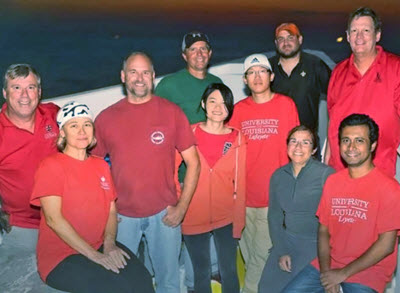
The LADC-GEMM team for the 2015 Gulf of Mexico recovery cruise. From left to right: Douglas Dugas, Natalia Sidorovskaia, Tad Berkey (Captain), Sean Griffin, Tingting Tang, Kun Lee. Top right Bradley Lingsch and Carl Richter, bottom right Elizabeth Kusel and Sakib Mahmud. (Photo by Douglas Dugas)
Tingting described her daily research routine, “I often find myself losing track of time trying to solve a problem arising from modeling or debugging a program.” Yet, she feels that every day is an adventure, “I learn something new, which is my favorite part of being a research student.”
Her work has two parts: estimating the number of whales and assessing environmental impacts on them. Tingting analyzes population density trends of beaked whales using data collected near the spill site in 2007, 2010, and 2015 by LADC-GEMM’s acousticians, led by Dr. Natalia Sidorovskaia. Tingting uses this data to develop statistical and mathematical models and obtain population density estimates.
Tingting assesses environmental impacts on marine mammals with a life-stage matrix population model to analyze changes in sperm whale population dynamics. Her study uses a mathematical model based on a five-stage life cycle that divides the female population into calves, juveniles, mature females, mothers, and post-breeders. A potential impact of the oil spill on the sperm whale population could be reflected in reduced adult female vital rates. Tingting uses the model to describe the population dynamics and derive recovery probability and time under different impact levels. For example, if the adult female survival rate is reduced by 1% for 20 years due to a certain event, how long would it take for the whale population to recover to pre-event levels? What if the reduction is 3% and lasts for 30 years? The stage-structured population model can help provide insights into questions like these.
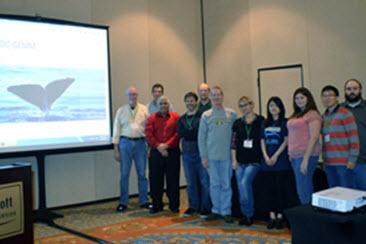
The LADC-GEMM team memebrs during the 2016 Gulf of Mexico Oil Spill and Ecosystem Science Conference. From left to right: Hal Caswell, Chris Tiemann, Azmy Ackleh, Dave Mellinger, Chris pierpoint, Stan Kuczaj, Natalia Sidorovskaia, Danielle Greenhow, Tingting Tang, Kun Li, Ross Chiquet. (Photo provided by Tingting Tang)
Previous research by LADC-GEMM indicates that sperm whales relocated to sites farther away from the spill. Tingting’s preliminary findings on beaked whales, however, suggest that they remained in the area, though she is not certain what specific factor(s) prompted the different migratory behavior of beaked and sperm whales. She learned that both whale populations are fragile and particularly sensitive to changes in adult female vital rates. Even slight changes in adult females’ mortality or reproduction rates can result in population decline. Tingting completed analysis of the 2007 and 2010 acoustic data and hopes to analyze the 2015 data after others process it. Doing so will give her a longer timeline of the whales’ density trends so she can understand whether whales have returned to pre-spill numbers and predict their future populations.
Her learning
Tingting credits her advisor Dr. Ackleh with mentoring her towards her goals and teaching important research techniques, including exhaustive literature searches to refine her methodology. She also joined a LADC-GEMM research cruise in October of 2015 to recover equipment deployed in an earlier trip. She observed field-work processes, assisted in equipment recovery, and learned details of how data is collected. She feels very fortunate to work on such a large-scale project as a graduate student, particularly one with so many talented people. “I am truly thankful for the opportunity to join the GoMRI science community,” she added.
She participated in the 2016 Gulf of Mexico Oil Spill and Ecosystem Science conference, “I was very excited but nervous standing by my poster,” Tingting said. “But as the poster attracted more people with questions and interest in our findings, I felt proud and accomplished explaining our methodology.” She is looking forward to presenting more results in the coming year.
Her future
Tingting plans to complete her Ph.D. in the summer of 2017. She hopes to secure a postdoc position, continue her population dynamics studies, and build a solid resume of published research. Her dream is to land a tenure-track position at a research institution, “I hope one day I can be as good as a researcher as my advisor Dr. Ackleh.”
Tingting would love for all aspiring scientists to embrace the beauty of mathematics as a research tool. She says that the right tools coupled with the right attitude can bring success in science. “For students considering science as a career, I would say endurance, persistence, and hard work will not fail you.”
Praise for Tingting
Describing Tingting as hardworking and smart, Dr. Ackleh said, “What distinguishes her from other students is her leadership skills.” He has watched her, even as a young Master’s student, lead meetings that involved older students further along in their research. She helped the team attend this year’s Gulf of Mexico Oil Spill & Ecosystem Science conference, organizing travel, working with a postdoc on the presentation poster, and driving a group to Tampa.
Tingting joined Ackleh as an author on an earlier article funded by the National Science Foundation regarding disease epidemics, and they are preparing a manuscript for publication. Ackleh said that Tingting was a main driver of that paper, contributing as much as anyone else on the project. She is also a co-author with Ackleh and other LADC-GEMM team members on a recently-submitted paper about their research using stochastic modeling to analyze effects of environmental stressors on sperm whales.
The GoMRI community embraces bright and dedicated students like Tinting Tang and their important contributions. The GoMRI Scholars Program recognizes graduate students whose work focuses on GoMRI-funded projects and builds community for the next generation of ocean science professionals. Visit the LADC-GEMM website to learn more about their work.
************
This research was made possible in part by a grant from The Gulf of Mexico Research Initiative (GoMRI). The GoMRI is a 10-year independent research program established to study the effect, and the potential associated impact, of hydrocarbon releases on the environment and public health, as well as to develop improved spill mitigation, oil detection, characterization and remediation technologies. An independent and academic 20-member Research Board makes the funding and research direction decisions to ensure the intellectual quality, effectiveness and academic independence of the GoMRI research. All research data, findings and publications will be made publicly available. The program was established through a $500 million financial commitment from BP. For more information, visit http://gulfresearchinitiative.org/
Meet the Scientists of the Coastal Waters Consortium (CWC-I and CWC-II)
The first three years of Coastal Waters Consortium (CWC-I) began September 2011 and ended December 2015. The second three years of Costal Waters Consortium (CWC-II) began January 1, 2015 and extends until the end of December 2017.
Meet some of the many researchers up-close and personal in the following links:
Grad Student Jaggi Seeks Solution to World’s Clean Water Shortage
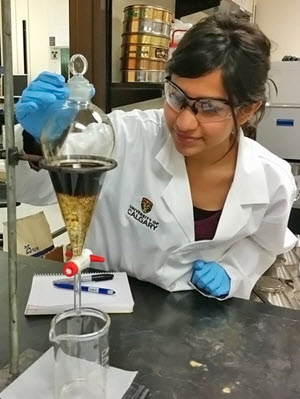
Aprami Jaggi conducts bench top oil-water partitioning experiments. (photo credit: Kim Nightingale)
As a child in India, Aprami Jaggi witnessed firsthand how polluted water sources impact society.
Her desire to make water remediation her life’s work has led her from Delhi to Calgary, Canada, to study oil mitigation. There she combines geochemistry and geophysics to hunt for scientific answers and practical solutions to the worldwide water pollution problem.
Pursuing a Ph.D. in geosciences at the University of Calgary, Aprami is a GoMRI Scholar with the C-IMAGE consortium. She talks about her journey around the world to gain the knowledge required to help her homeland.
Her Path
“I believe that my very first trip to the National Science Museum resulted in my initiation into science,” Aprami said of her first childhood visit to India’s flagship science museum. “This was followed with ‘100 science experiments for kids’ and lots of exhibitions.” She recalled spending weeks filling buckets from a tanker to cope with a clean water shortage. Getting water this way gave Aprami direction to her growing passion for science. “The abysmal condition of the rivers in the city and the continuing pollution inspired me to work towards water remediation.”
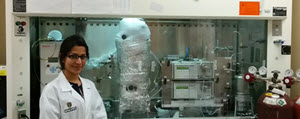
Aprami stands with the customised partition device used to experimentally simulate oil spill conditions. (photo credit: Kim Nightingale)
Aprami studied environmental engineering at the University of Delhi, where she worked on natural water bioremediation projects and sampled the Yamuna River to identify industrial input hotspots. An internship and subsequent job at Nalco-Champion, an Ecolab Company, introduced her to the industrial capabilities of water treatment. There she helped develop chemistries tailor-made to the respective problem, a direction she decided to pursue further academically.
“At my time in Nalco-Champion, I had heard about the game-changing ideas of Dr. Steve Larter and Dr. Thomas Oldenburg’s group,” she said, adding that their ideology of applied sciences supported her vision of change through research.
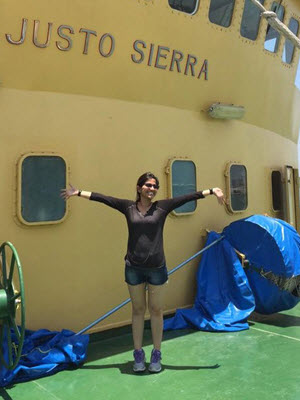
Aprami saw the ocean for the first time in July 2015 when she boarded the Justo Sierra on a cruise she organized. (photo credit: Sara Lincoln)
Larter’s TEDx talk about rethinking the world’s need for fossil fuels inspired her to contact the two researchers and see if their program would be a good fit with her academic studies and water remediation experience. They offered her a position on the C-IMAGE project to study Deepwater Horizon oil spill impacts on the Gulf of Mexico. She travelled halfway across the globe and began her Ph.D. in September 2014.
Her Work
Aprami is looking at how low molecular-weight, toxic oil compounds such as benzene and toluene enter and travel through the water column. Because traditional measurement methods cannot account for high pressure and low temperature extremes in deep sea conditions, her team built a specialized instrument to measure these compounds’ distribution trends under deepwater blowout conditions. They customized the device using methane-charged oil or ‘live’ oil to simulate dissolved gases’ release during a spill. Initial results, which she presented at the 2016 Gulf of Mexico Oil Spill & Ecosystem Science Conference, indicated methane’s inclusion greatly influences the amount of toxic oil elements that enter the marine environment. The data the device generated will help create future distribution models of toxic pollutants migration through water. She is preparing her first paper for an international peer-reviewed journal about how oil components partition into the water column under various temperature and pressure conditions.
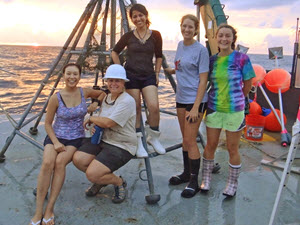
The all-female science party, Aprami in center, aboard the R/V Weatherbird II in August 2015. (photo courtesy of C-IMAGE)
Aprami also is investigating the fate of oil compounds from the 1979 Ixtocand 2010 Deepwater Horizon oil spills. She collected water samples last summer in areas these spills impacted and is analyzing the molecular structure of dissolved organic matter to understand long term oil fate. “I was onboard the Justo Sierra and Weatherbird-II a week apart,” she recalled. “I covered over 20 different sampling sites and collected samples at different depths using Niskin bottles, while measuring the temperature, conductivity and oxygen profile of the water column.”
Aprami, who had never before seen the ocean, organized the sampling trip to Mexico. Her first expedition lasted 17 days, sampling 12-16 hours per day and helping other research groups on board. She arrived in St. Petersburg, Florida, and began a 5-day sampling effort in the northern Gulf. Afterwards, she organized shipping of the equipment to Sachs Harbour, Northwest Territories, Canada, where another research group took Arctic water samples for comparison studies.
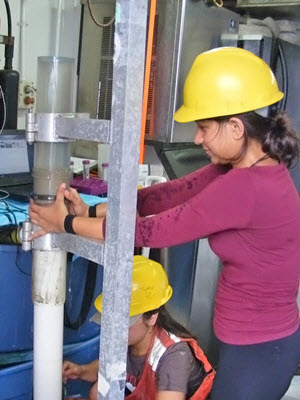
Aprami transferred and extruded core sediments on board the Weatherbird II in August 2015. (photo courtesy of C-IMAGE)
She shipped the Gulf samples to Calgary and analyzed them using Fourier transform ion cyclotron resonance- mass spectrometry (FTICR-MS). FTICR-MS can resolve complex molecular mixtures and provide the elemental composition of individual compounds, making it ideal for molecular fingerprinting the extremely complex makeup of the oceans’ dissolved organic matter (DOM). The comprehensive DOM screening helps researchers analyze compounds that are poorly understood in terms of environmental and human health impacts and enables tracing of contamination sources. For example, DOM in natural waters near oil seeps and spill sites may represent near terminal degradation petroleum products.
Her Learning
Aprami learned the importance of the research process, which gives scientists tools to persevere, particularly when developing new experimental protocols: “The execution of every big idea starts small. For example, before you take on the big fancy equipment, you have to perfect the art of washing glass ware. Each step along the way is important to reach the end goal.”
She feels fortunate to be part of the GoMRI community, saying the close knit research group working towards a common goal provides a unique opportunity for interdisciplinary and interinstitutional collaboration. “Being a part of C-IMAGE, I get to work alongside people from 19 institutions and 5 different countries,” Aprami explained. “Without GoMRI, such collaboration wouldn’t have been possible.”
Her Future
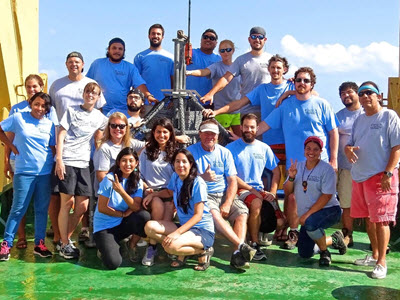
The science party on board the Justo Sierra, July-August 2015. (photo courtesy of C-IMAGE)
Aprami plans to complete her Ph.D. in 2018 and pursue a corporate research and development position to help find practical answers to worldwide water pollution problems
“Having been a part of the R&D section in the industry, I realize that although the prospect of ‘blue sky research’ is exciting, we need more and more scientists working on providing real world solutions to existing problems,” she explained.
Praise for Aprami
Aprami’s advisors Steve Larter and Thomas Oldenburg described her as a key team member, both scientifically and socially. She immediately impressed the C-IMAGE administration, who named Aprami their Student of the Month shortly after she arrived in Calgary. She has won additional awards and accolades since, including being asked to give an oral presentation at the 2016 Gulf of Mexico Oil Spill & Ecosystem Science Conference.
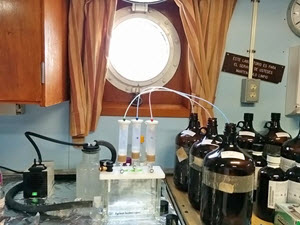
Aprami’s lab equipment for extracting dissolved organic matter from water samples on board the Justo Sierra. (photo credit: Aprami Jaggi)
“Considering that Aprami’s previous studies and experience were not geology or geochemistry related, it is remarkable how deep her technical knowledge is already at this stage,” said Oldenburg. He and Larter acknowledged her exceptional speaking and writing skills, but said her deep scientific knowledge makes her a rising star, “She not only developed special extraction methods usable under limited lab conditions such as cruise ships but also learned in this short time how to operate the unique partition device, GC-MS, LC-MS, and FTICR-MS and how to interpret these diverse data sets.”
Aprami especially impressed her advisors when she organized the research mission into Ixtoc-impacted Gulf waters, overcoming the language barrier with the Mexican crew among other challenges. They reported that many other cruise members expressed how enthusiastically she helped the team in addition to tending to her own sampling. “Aprami has excellent interpersonal skills, works very hard, is very organized, joins and partially organizes many social events within our research group,” Larter summed up. “Aprami is an all A+ student!”
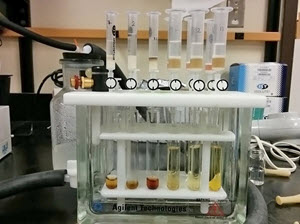
Aprami’s more elaborate lab set up at her lab in Calgary. (photo credit: Aprami Jaggi)
The GoMRI community embraces bright and dedicated students like Aprami Jaggi and their important contributions. The GoMRI Scholars Program recognizes graduate students whose work focuses on GoMRI-funded projects and builds community for the next generation of ocean science professionals. Visit the C-IMAGE website to learn more about their work.
************
This research was made possible in part by a grant from The Gulf of Mexico Research Initiative (GoMRI). The GoMRI is a 10-year independent research program established to study the effect, and the potential associated impact, of hydrocarbon releases on the environment and public health, as well as to develop improved spill mitigation, oil detection, characterization and remediation technologies. An independent and academic 20-member Research Board makes the funding and research direction decisions to ensure the intellectual quality, effectiveness and academic independence of the GoMRI research. All research data, findings and publications will be made publicly available. The program was established through a $500 million financial commitment from BP. For more information, visit http://gulfresearchinitiative.org/.
Grad Student Robinson Follows Little Blue Crabs for Bigger Food Web Picture
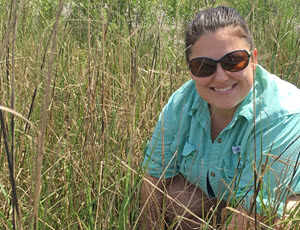
Elizabeth Robinson enjoys field work in Terrebonne Bay studying blue crab in their natural habitat. (Photo provided by E. Robinson)
Elizabeth Robinson studies blue crab’s role in the northern Gulf of Mexico food web, looking closely at how Deepwater Horizon oil might have affected the natural predator-prey balance.
Many people who hear the phrase ‘marine life’ typically think first about big ocean animals like whales and dolphins. Elizabeth explained why smaller marine animals – like crabs – mean just as much to ocean health, “The little guys are what feed the bigger guys. If you lose the little guys, those bigger guys are going to disappear.”
Elizabeth is a GoMRI Scholar with the Coastal Waters Consortium, pursuing a Ph.D. in Oceanography and Coastal sciences at Louisiana State University with research centered at Louisiana Universities Marine Consortium (LUMCON).
Her Path
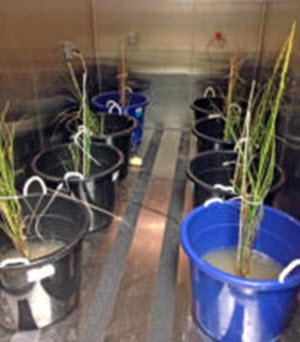
Elizabeth created a mesocosm experiment station to get a better understanding of how crabs behave in their natural environment. (Photo provided by E. Robinson)
Elizabeth credits childhood visits to museums, aquariums, and nature centers and having home aquariums with sparking her interest in marine science. Her parents involved Elizabeth and her hearing-impaired brother in hands-on science learning opportunities whenever possible, encouraging them to learn using all their senses. These early experiences helped Elizabeth feel comfortable around water.
Elizabeth considers Louisiana and its water-rich environment as home even though her family moved many times. Living in Louisiana added a different dimension to her growing interest, as she explained, “The politics around wetlands loss and fisheries have also influenced why I’m in science.” She stayed in the region, earning a bachelor’s degree from Centenary College of Louisiana and a Master’s degree in Biology from Texas A&M University-Corpus Christi. Her thesis was on invasive cold water crab species.
One of Elizabeth’s undergraduate courses was a video conference class from LUMCON, where she worked as a summer intern in Dr. Nancy Rabalais’ lab. Several years later, Elizabeth jumped at the chance to work with Rabalais again, this time as a Ph.D. student. Rabalais leads a multi-year grant studying effects of the Deepwater Horizon oil spill on Louisiana marshes. Elizabeth felt this would be the perfect opportunity to learn how the spill might have impacted crabs.
Her work
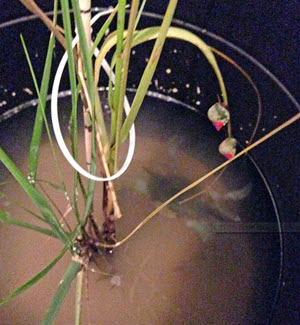
Each mesocosm recreates as accurately as possible conditions in the wild, serving as important tools in ecosystem studies. (Photo provided by E. Robinson)
Elizabeth explained why she chose these marine animals for her dissertation experiments, “Blue crabs are a keystone species. They link benthic and pelagic environments together, are important as a food source, and serve as a control on so many other different species.”
Elizabeth is concurrently running field and lab studies to determine local crab distribution and their response to oil. She scrutinizes snail, oyster, and mussel populations at designated transects in Terrebonne Bay to understand how residual oil might be affecting their population distributions and morphology. Blue crabs eat these species, and Elizabeth explains why this work is the foundation for understanding potential food web changes: “If I’m seeing a high population of snails, is it because crab predators are avoiding certain marshes because of oil? Or can they not find the snails because their behavior has been altered by oil?”
Seeking answers to these and other questions, Elizabeth releases minnow traps to lure juvenile blue crabs and uses scoop nets to catch them. She sizes her catches and then runs various lab experiments to determine oil exposure’s impact on their survival and behavior. One experiment involves exposing crabs to oiled water and then tethering them back in the bay to see if that increases their vulnerability to predation. Healthy crabs bury themselves to escape predators, but Elizabeth is finding that oil-exposed crabs are not responding to threats in a typical manner.
Elizabeth conducts lab experiments to determine how oil affects predator-prey behavior of crabs and snails. She uses oil-exposed crabs in flume experiments to see if oil impacts their ability to find food using chemical cues. Preliminary results show that oil reduces the crab’s chemosensory ability. She also conducts mesocosm experiments – a mini-ecosystem in a controlled chamber – to study crab-snail interactions in oiled sediment. Her initial findings suggest that in this situation, oil makes blue crabs unusually aggressive and they successfully forage for snails. However, crabs in the mesocosm experiments are dependent on visual cues and not utilizing chemical cues as they did in the flume experiment. The oil also reduced snail climbing behavior making them more susceptible to crab predation.
Her learning
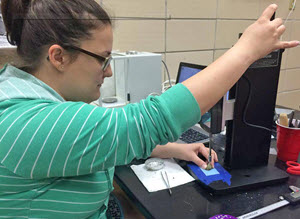
Elizabeth Robinson tests the shell strength of periwinkle snails. She is trying to determine if snail strength differs between locations along the coast. (Photo provided by CWC)
Elizabeth said the diverse projects that GoMRI funds provide a bigger-picture context and raise the bar for everyone involved in oil spill research. “Conferences are a lot to take in,” she explained, referring to the annual meetings where scientists studying the oil spill and the Gulf of Mexico ecosystem gather. “It helps you as a biologist to learn from physicists, chemists, and others what you need to focus on in your experiments.”
She credits the hands-off management style of her advisor Nancy Rabalais with instilling confidence in her own abilities: “She’s taught me a lot about independence, that I can trouble-shoot problems by myself and not rely on anyone to hold my hand.”
Her Future
Elizabeth knows her work will always focus on crabs, even though her career path after graduation isn’t certain. Her aspirations vary from opening up her own marine research facility to serving in regulatory roles in government and/or industry.
Science can be stressful, so Elizabeth cautions those considering pursuing it to have a passion for it. Having that love, she says, creates the tenacity to get scientists through the long hours of frustrating or tedious work often necessary to reach important findings.
Praise for Elizabeth
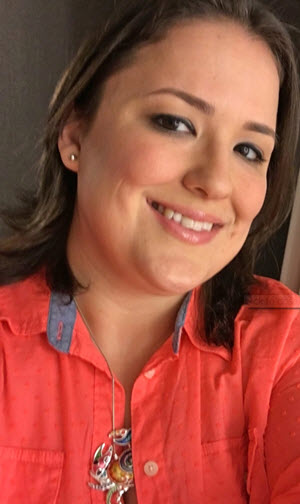
Elizabeth wants to spend her career focused on ‘little guys’ like blue crabs that play such an important role in overall marine health. (Photo provided by E. Robinson)
Nancy Rabalais describes Elizabeth as a dedicated and creative researcher: “She has an exceptional command of experimental biology. She is persistent, modifying as necessary, and thinking through alternative explanations for results in her complex experiments.”
Elizabeth, she says, is an active graduate student who takes advantage of every opportunity. She collaborates with her lab mates, participates in Coastal Ecology informal talks, and attends and presents at professional meetings annually, including the Gulf of Mexico Oil Spill and Ecosystem Science Conference, representing CWC and LUMCON well. Finally, she is active in LSU’s Coast and Environment Graduate Organization, serving as president for the 2013-2014 academic year.
“She has all the qualifications for completion of her Ph.D. —good course performance, writing skills, presentation skills, critical thinking, and a collaborative attitude,” summed up Rabalais.
The GoMRI community embraces bright and dedicated students like Elizabeth Robinson and their important contributions. The GoMRI Scholars Program recognizes graduate students whose work focuses on GoMRI-funded projects and builds community for the next generation of ocean science professionals.
************
This research was made possible in part by a grant from The Gulf of Mexico Research Initiative (GoMRI). The GoMRI is a 10-year independent research program established to study the effect, and the potential associated impact, of hydrocarbon releases on the environment and public health, as well as to develop improved spill mitigation, oil detection, characterization and remediation technologies. An independent and academic 20-member Research Board makes the funding and research direction decisions to ensure the intellectual quality, effectiveness and academic independence of the GoMRI research. All research data, findings and publications will be made publicly available. The program was established through a $500 million financial commitment from BP. For more information, visit http://gulfresearchinitiative.org/.
Lesson Plan: “Taking Science Deeper” Deep-Sea Activities (K-6)

Images and content credit: DEEPEND Consortium
The Deep-Pelagic Nekton Dynamics (DEEPEND) Consortium has created lesson plans for “Taking Science Deeper” Activities.
Book 1: Introduction to the Deep Sea
Book 2: Deep-Sea Animals
Book 3: Hagfish Day!
Book 4: Ocean Currents and Pollution Awareness
For additional educational materials from DEEPEND, click here.
Ten Outstanding Education Products Six Years After Deepwater Horizon
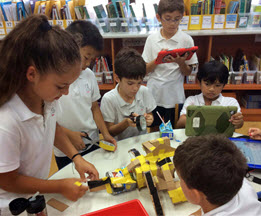
Students construct their own drifter after being inspired by “Bob the Drifter”. (Provided by: Jenny Harter)
Communicating oil spill research is essential to improve society’s understanding about spills and their ability to respond to and mitigate them.
The Gulf of Mexico Research Initiative (GoMRI) has been funding spill-related research since 2010.
Here are ten outstanding education products and resources that GoMRI and its science community have developed to share what they are learning, doing, and how they are preparing the next generation of scientists for future spill research.
Products You Can Watch…
“Film provides an opportunity to marry the power of ideas with the power of images.”
— Steven Bochco, television writer and producer
- Award-winning short films for young audiences “Drones at the Beach” and “Bob the Drifter” use easy-to-understand language and imagery to explain two technologies that scientists use to track an oil slick as it moves with ocean currents towards beaches.
- Syndicated outdoors program Gary Finch Outdoors, in partnership with Mississippi-Alabama Sea Grant Consortium (MASGC), produced over a dozen short videos highlighting deep-sea research. The videos comprise the Research Video Series and contributed to the E/V Nautilus 2014 Cruise Videos and the Tools of the Trade series.
- The Screenscope film production company developed the documentary Dispatches from the Gulf, narrated by Matt Damon, as an episode of the award-winning series Journey to Planet Earth. The film is available for screenings. Screenscope is offering two live streaming events of the film on April 20, 2016, at 2 pm and 7 pm EST to mark the Deepwater Horizon’s sixth anniversary.
- The short film “Deciphering Oil Spill Impacts in Louisiana Wetlands” describes GoMRI-funded research on the chemical evolution, biological degradation, and environmental stresses of oil on Louisiana wetlands.
Products You Can Hear…
“Storytelling is the most powerful way to put ideas into the world today.”
— Robert McKee, writer
- The Loop: Stories from the Gulf is a podcast series produced by David Levin and Ari Daniel Shapiro that takes listeners under the sea, into the mud, and back to the lab to explore ongoing research. There are currently eight episodes of The Loop available for streaming including:
The Pressure Is On: In “Under Pressure”, German scientists modeled the Deepwater Horizon blowout in a tank that can simulate the water pressure level of the blowout depth to track the oil’s movement and better understand oil dynamics at extreme depths.
“Under Pressure” (07:43):
Seeking New Insights from Decades-Old Spill: In “The Gulf’s Big Blowouts” and “Return to Ixtoc”, an international team of researchers hoping to predict how Deepwater Horizon may impact the Gulf decades into the future set out to study a spill of the past – the 1979 Ixtoc I blowout.
“The Gulf’s Big Blowouts” (08:08):
“Return to Ixtoc” (9:03):
Products for the Classroom…
“The one exclusive sign of thorough knowledge is the power of teaching.”
— Aristotle
- The multidisciplinary high school curriculum developed by Deep-C draws connections between the theoretical nature of science and real-world applications and addresses issues such as environmental disasters, their impacts on ocean ecosystems, and nature’s recovery mechanisms. Each of the curriculum’s five modules focuses on a main research area (geomorphology, geochemistry, ecology, physical oceanography, and modeling) and includes five cumulative lessons, background information on the topic, relevant supplementary reading materials, a glossary, and an assessment.
- Free downloadable lesson plans and teaching materials bring deep sea and oil spill research to the classroom. DEEPEND has created lesson plans for grades K-5, 6-8, and 9-12 that cover deep sea topics ranging from bioluminescence to topography and include curricula, experiment instructions, and coloring sheets. Several of CWC’s K-12 Science Classroom Activities, which include lesson plans and fun, science-based activities covering a wide range of oil spill science topics, have been translated into Spanish to reach a broader, more-diverse audience.
Products You Can Explore…
“The real voyage of discovery consists not in seeking new landscapes, but in having new eyes.”
— Marcel Proust, novelist
- The Smithsonian Ocean Portal is an online complement to the Sant Ocean Hall in the Smithsonian National Museum of Natural History. Pieces they have developed include research stories, interactive infographics, blog posts, interviews with GoMRI scientists, and more.
- Student Stories highlights some outstanding graduate students to inspire future generations of scientists. Each story describes individual students’ journeys into oil spill research, their current research, and hopes for the future.
- The Sea Grant oil spill outreach team creates short brochures that answer coastal audiences’ top questions about the oil spill including fisheries, oiled beaches, and dispersants. These brochures synthesize peer-reviewed oil spill science for a broad range of general audiences, particularly those whose livelihoods depend on a healthy Gulf.
************
This research was made possible in part by a grant from the Gulf of Mexico Research Initiative (GoMRI) to theConsortium for Advanced Research on Transport of Hydrocarbon in the Environment (CARTHE), Ecosystem Impacts of Oil and Gas Inputs to the Gulf (ECOGIG) Consortium, the Center for Integrated Modeling and Analysis of Gulf Ecosystems (C-IMAGE I and C-IMAGE II), the Deepsea to Coast Connectivity in the Eastern Gulf of Mexico (Deep-C)Consortium, the Deep-Pelagic Nekton Dynamics of the Gulf of Mexico (DEEPEND) Consortium, and the Coastal Waters Consortium (CWC).
Dispatches from the Gulf is made possible in part by a grant from the Gulf of Mexico Research Initiative (GoMRI).
GoMRI and the Sea Grant programs of the Gulf of Mexico (Florida, Mississippi-Alabama, Louisiana, and Texas) have partnered to create an oil spill science outreach program.
GoMRI and the Smithsonian have a partnership to enhance oil spill science content on the Ocean Portal website.
The GoMRI is a 10-year independent research program established to study the effect, and the potential associated impact, of hydrocarbon releases on the environment and public health, as well as to develop improved spill mitigation, oil detection, characterization and remediation technologies. An independent and academic 20-member Research Board makes the funding and research direction decisions to ensure the intellectual quality, effectiveness and academic independence of the GoMRI research. All research data, findings and publications will be made publicly available. The program was established through a $500 million financial commitment from BP. For more information, visithttp://gulfresearchinitiative.org/.
Fact Sheet: Fiddler Crabs of the Gulf of Mexico
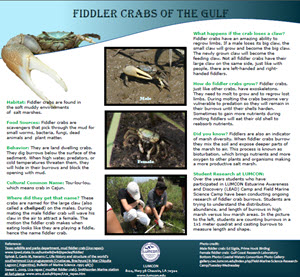 Want to know more about the fiddler crab? Click here to download the Coastal Waters Consortium (CWC) Fact Sheet on the Fiddler Crab’s habitat, food sources, behavior, cultural common name, and many more interesting facts.
Want to know more about the fiddler crab? Click here to download the Coastal Waters Consortium (CWC) Fact Sheet on the Fiddler Crab’s habitat, food sources, behavior, cultural common name, and many more interesting facts.
Over the years, students who have participated in Louisiana Universities Marine Consortium (LUMCON) Estuarine Awaremess and Discovery (LEAD) Camp and Field Marine Science Camp have been conducting ongoing research of fiddler crab burrows.
Visit CWC’s website for more fact sheets and printable resources.
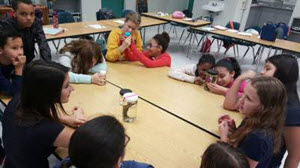
Lesson Plan: DEEPEND Visits New River Middle School

Photo Credit: DEEPEND
Story posted by Nina Pruzinsky on DEEPEND’s BLOG
On Friday, March 4, 2016, Mike Novotny and Nina Pruzinsky visited Mr. Kyle Lendick’s 6th grade Marine Science classes at New River Middle School. The three classes spent several weeks completing Deep-Pelagic Nekton Dynamics (DEEPEND)’s grade 6-8 lesson plans (found in the Education/Outreach section under Education, Resources, Lesson Plans) before our visit, so the students had already obtained a knowledgeable background regarding the deep sea and our research. Upon our arrival, we could tell that every student was very excited to learn more about our experiences as DEEPEND members.
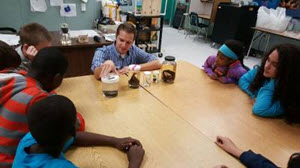 To start, Mike and I briefly explained how the Deepwater Horizon Oil Spill influenced the need for research and baseline data in the Gulf of Mexico and how we were sampling the Gulf’s ecosystem. The students found the discrete depth sampling of the MOCNESS net to be very interesting, and throughout our discussions, I stressed the term diel vertical migration. This was a new term for most students, and they were shocked to hear that it is the world’s largest migration! After our short presentation and tons of questions, we split into two groups to talk about at the deep sea fishes we brought in to share with them. With each specimen, we stressed the importance of the adaptations it uses to survive in the deep sea. The students loved the hands-on experience, and their questions were endless! Overall, I had an amazing time teaching the students about the work that we do for the DEEPEND Consortium. It was great to see how students as early as 6th grade were curious about life in the deep sea.
To start, Mike and I briefly explained how the Deepwater Horizon Oil Spill influenced the need for research and baseline data in the Gulf of Mexico and how we were sampling the Gulf’s ecosystem. The students found the discrete depth sampling of the MOCNESS net to be very interesting, and throughout our discussions, I stressed the term diel vertical migration. This was a new term for most students, and they were shocked to hear that it is the world’s largest migration! After our short presentation and tons of questions, we split into two groups to talk about at the deep sea fishes we brought in to share with them. With each specimen, we stressed the importance of the adaptations it uses to survive in the deep sea. The students loved the hands-on experience, and their questions were endless! Overall, I had an amazing time teaching the students about the work that we do for the DEEPEND Consortium. It was great to see how students as early as 6th grade were curious about life in the deep sea.
Click here for more lessons plans from DEEPEND…
Videos + Lesson Plans: Dispatches from the Gulf Documentary
 Screenscope, Inc. has completed production of three Dispatches from the Gulf documentary films, which features scientists working to better understand the effects of the Deepwater Horizon oil spill. Dispatches from the Gulf is part of the Journey to Planet Earth series and is narrated by Matt Damon.
Screenscope, Inc. has completed production of three Dispatches from the Gulf documentary films, which features scientists working to better understand the effects of the Deepwater Horizon oil spill. Dispatches from the Gulf is part of the Journey to Planet Earth series and is narrated by Matt Damon.
All three films and corresponding educational materials are available to watch for free below. They are also available (along with 50 short videos designed to accompany the documentaries) on the Dispatches from the Gulf YouTube Channel. Major funding for these additions to Journey to Planet Earth was provided by the Gulf of Mexico Research Initiative – scientists working together to understand and restore the health of marine and coastal ecosystems.
Dispatches from the Gulf:
In the years after Deepwater Horizon, a global team of scientists investigates the environmental health of the Gulf and its impact on local communities. A coalition of academic institutions, government, and NGOs are working together to protect and restore one of our planet’s most valuable natural resources. Their ultimate goal is to learn how to cope with future oil spills.
Educational Materials:
- Educators Guide for Episode 14: Dispatches from the Gulf
- Full Transcript of Episode 14: Dispatches from the Gulf
Dispatches from the Gulf 2:
The unprecedented scientific mission to study the lasting impacts of Deepwater Horizon continues. Barely half of the pre-spill dolphin population survives, their calves dying or miscarried. Fish hearts cannot beat properly. Crab burrows leak oily rivulets into wetlands poisoning fish nurseries. Will this ecosystem recover? Will we be able to prevent future oil spills and the ensuing environmental devastation?
Educational Materials:
- Educators Guide for Episode 15: Dispatches from the Gulf 2
- Full Transcript for Episode 15: Dispatches from the Gulf 2
Dispatches from the Gulf 3:
“Has the Gulf of Mexico recovered from the Deepwater Horizon oil spill?” As the tenth anniversary of the disaster approaches, this question is regularly posed. Scientists have spent nearly that long studying its environmental impact on humans, wildlife, and the ecosystem. They provide assessments of the current state of the Gulf, but lingering questions are challenging their ability to predict the long-term impacts.
Educational Materials:
- Educators Guide for Episode 16: Dispatches from the Gulf 3
What Can Horse Flies Tell Us About Marsh Health?
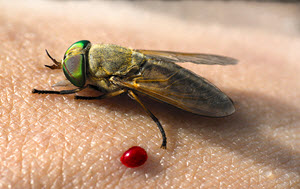
A greenhead horse fly partakes in a blood meal. (Photo by Claudia Husseneder)
Greenhead horse fly larvae live in Spartina marshes and are the top predator in the coastal wetlands invertebrate food chain between Texas and Nova Scotia.
Drs. Lane Foil and Claudia Husseneder discovered reduced genetic variation and severe declines in adult and larval horse fly populations living in oiled marshes, which showed that the horse flies could be an indicator species for post oil spill marsh health.
The Gulf of Mexico Research Initiative recently awarded Foil and Husseneder a grant to build on their previous research and develop a reliable, cost-efficient tool for measuring marsh health using this horse fly. Foil and Husseneder began researching the abundance and genetic diversity of horse fly populations in oiled and unoiled Louisiana Spartina marshes in 2010. They will use historical and current samples of adult horse flies, their larvae, and the surrounding marsh soil to determine if adult horse fly populations have recovered and how their larval food web can be used to assess marsh health.

(Click to enlarge) The researchers sampled horse flies in oiled (Jefferson and Plaquemines Parishes) and unoiled (Cameron and St. Mary Parish) areas. (Provided by Lane Foil and Claudia Husseneder)
The researchers will use metagenomic sequencing to describe the invertebrate food web in soil samples and horse fly larvae stomach contents collected from oiled and unoiled marshes. Data will reveal the groups of organisms and level of diversity that the larvae need for healthy growth and development and if oiling alters the presence of their prey. The team will then develop a tool that uses polymerase chain reaction (PCR) – a technology that generates copies of a certain DNA region until it is prevalent enough to be detectable – to search certain genetic markers in soil and determine if the taxa needed for a healthy food web are present or absent.
“The species that we picked is native and tightly bound to the marsh,” said Husseneder. “If everything that the larvae need to develop is present, then we can assume the marsh is healthy enough to support this top-level predator. If not, then the marsh is likely compromised.”
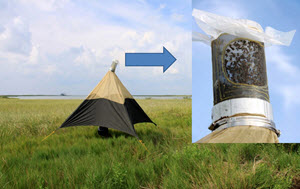
Horse flies are collected using traps like this one located in Grand Bayou, Louisiana. (Photo by Claudia Husseneder)
Larval sample collection and genomic sequencing are expensive and time-consuming. The project’s PCR tool will offer a timely, cost-efficient, and easy alternative that scientists and citizens with access to a high-school-level molecular laboratory can use to screen soil samples and assess marsh health. The tool could also be expanded to include and apply data from studies of different species in different habitats.
Foil commented, “We have a specialty area that we are contributing to a much larger area of science. I believe the tools we are developing will be very important in helping other scientists and that what we learn from them will help us better adapt our tools. As we and other researchers make our information available, we can start to put together the big puzzle of what actually happened in the marsh.”
The project’s researchers are Lane Foil and Claudia Husseneder at the Louisiana State University Agricultural Center. Their project is A Study of Horse Fly (Tabanidae) Populations and Their Food Web Dynamics as Indicators of the Effects of Environmental Stress on Coastal Marsh Health.
************
The Gulf of Mexico Research Initiative (GoMRI) is a 10-year independent research program established to study the effect, and the potential associated impact, of hydrocarbon releases on the environment and public health, as well as to develop improved spill mitigation, oil detection, characterization and remediation technologies. An independent and academic 20-member Research Board makes the funding and research direction decisions to ensure the intellectual quality, effectiveness and academic independence of the GoMRI research. All research data, findings and publications will be made publicly available. The program was established through a $500 million financial commitment from BP. For more information, visit http://gulfresearchinitiative.org/.
Grad Student Timm Tracks Crustacean’s Oil Spill Recovery
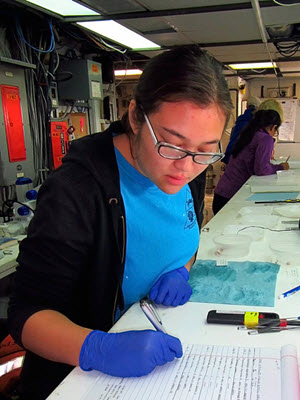
Laura Timm keeps careful records of collected species, including the number of individuals and how they are preserved. (Photo credit: Dr. Dante Fenolio)
Laura Timm examines connections among shellfish ecology and evolution to help scientists understand how the Deepwater Horizon oil spill affected certain Gulf of Mexico species: “My work focuses on establishing pre-spill baselines and comparing them to samples taken 3-7 years after the oil spill, providing a timeline of crustacean recovery.”
Pursuing a Ph.D. in biology at Florida International University (FIU), Laura is a GoMRI scholar with the DEEPEND consortium. She talks about her journey from her landlocked childhood to a life exploring Gulf health and resilience.
Her Path
A Minnesota native, Laura credits summer trips to California with igniting her passion for marine science: “I would spend hours exploring tide pools, completely enthralled by the biodiversity I saw there, which was unlike anything I had seen in my home state.”
A high school genetics class inspired her to pursue a deeper, molecular-level understanding of organisms and systems, which she did at Texas A & M University at Galveston. There, she completed a research project on the Sipunculan worms’ genetic connectivity in the Sea of Japan, working in Dr. Anja Schulze’s phylogeny and population genetics lab. “Studying genetics in marine invertebrates was the perfect combination for me,” said Laura.

Laura holds samples of A. purpurea and S. robusta, two shrimp species she is studying, and prepares them for ddRAQseq analysis. (Photo credit: Dr. Dante Fenolio)
Laura spent a year after graduation as a volunteer coordinator for a local nonprofitSMART Family Literacy program and as an after-school programs instructor for the Galveston Independent school district. She coached soccer, led a film class, tutored, and developed enrichment courses. These experiences sparked her desire to further others’ learning.
Laura wanted to continue her marine genetics studies and her newly-discovered education interest, so she searched graduate programs that might offer both. She and Dr. Heather Bracken-Grissom at FIU began communicating after learning they had similar interests in Gulf health and marine education. Laura began her Ph.D. program and assisted Dr. Bracken-Grissom in writing the DEEPEND grant proposal for oil spill research, which GoMRI funded in 2015.
Her Work
Laura studies nine crustacean species to explore Gulf genetic diversity and population connectivity, seeking answers to several questions: What kind of genetic diversity can be found in the deep Gulf? How well are the distinct populations connecting and communicating throughout the larger ecosystem? How has the oil spill impacted diversity and connectivity? What recovery, if any, can be seen since the spill? And, is the Gulf a genetically closed system or is there migration into and out of the Gulf?

A.purpurea, a Gulf shrimp species that that spews a glowing bioluminescent cloud from its mouth when attacked, is one of the crustaceans Laura and Team Crusty are studying. (Photo credit: Dr. Dante Fenolio)
“I’m particularly interested in diversity because this can be a good proxy for health of the population and the ecosystem,” Laura said. Genetic connectivity can indicate species’ recovery and resilience potential, as she explained, “If crustaceans are migrating, they have an adjacent gene pool that may be capable of genetically rescuing their population. If it’s not there, recovery potential is substantially reduced.”
Laura, together with science teams at the Bracken-Grissom’s and Dr.Tamara ‘Tammy’ Frank’s labs, leads the crustacean sample collection and processing protocols for the DEEPEND project. Their group, known as ‘Team Crusty,’ uses large sampling nets to collect crustaceans then identifies species and preserves samples for population genetics studies. Back onshore, the Bracken-Grissom team processes the samples and extracts DNA.
That’s when the fun and patience begins. Laura uses a new method, ddRADseq (double digest Restriction-site Associated DNA sequencing) for genetic analysis. Traditional methods allow scientists to sequence hundreds to thousands of base pairs in one organism, whereas this protocol does so across many individuals at once. It can take Laura a month for ddRADseq sample preparation, another month to six weeks for sequencing, and an additional month or more for data analysis. The time and effort involved are worth it to Laura as she gets a thorough genetic analysis for her research and optimizes the next-generation sequencing protocol for others’ use.
Her Learning
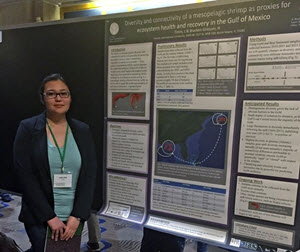
Laura presents her research at the 2016 Gulf of Mexico Oil Spill and Ecosystems Science conference in Tampa, FL. (Photo credit: April Cook and Nina Pruzinsky)
Laura credits DEEPEND researchers with showing her the strength of multi-disciplinary studies, “Our team includes labs working on stable isotopes and polycyclic aromatic hydrocarbons in our biological samples,” she said. “Only recently have I truly realized how much that adds to the ‘story’ my data will tell.”
The comradery among their diverse group makes the work enjoyable, too. Laura describes her genetic sequencing work with graduate student Ms. Emily Warschefsky, “Together we have crawled through the theory behind the method and conceptualized nearly every aspect of the protocol. Many a-ha moments have occurred during this process.”
Laura particularly enjoyed meeting Jonathan Puritz and Shannon O’Leary, who are at the forefront of ddRADseq, at the recent Gulf of Mexico Oil Spill and Ecosystem Science Conference. She plans to use one of their data processing programs and is happy to have had this opportunity to network with experienced scientists who are asking the same questions.
Her Future
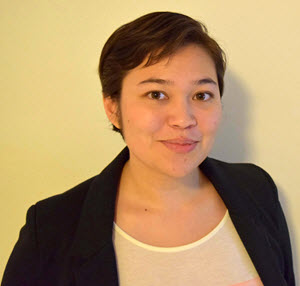
Laura Timm, Florida International University, works with the DEEPEND consortium to learn how Deepwater Horizon oil may have impacted the Gulf’s crustacean population. (Photo credit: Joseph Ahrens)
Laura’s dissertation is taking shape. She would like to continue working in science, either in academia or industry. Her earlier work in K-12 education, coupled with DEEPEND’s Education & Outreach program, has made her passionate about furthering STEM education wherever her career path goes.
“I was fortunate to have skilled, enthusiastic teachers throughout my education who fostered my excitement for learning,” Laura reported. “Too often, I meet students who have lost that passion. I would like to work toward improving STEM education through teacher workshops, classroom activities, school visits, and relationships with professional scientists.”
Praise for Laura
Dr. Bracken-Grissom recalls that Laura joined her lab as a Ph.D. student in 2013 and received the prestigious FIU Presidential Fellowship to support herself during graduate school. “I am honored to have Laura selected as a GOMRI scholar,” she said.
Bracken-Grissom describes Laura as “the full package,” pursuing important research linking ecosystem health to population diversity and connectivity. She credits Laura with optimizing a next-generation sequencing technique that will allow other scientists to advance this research using cutting-edge techniques in population genetics. She states that Laura puts as much energy into mentoring undergraduate students as she does into her own research, helping her excel as a teacher, student, and scientist.
“Laura has become a leader in my research group and is making great progress,” said Bracken-Grissom. “She has completely immersed herself in the DEEPEND consortium, participating on EVERY research cruise and going above and beyond to take full advantage of this project’s opportunities.”
The GoMRI community embraces bright and dedicated students like Laura Timm and their important contributions. The GoMRI Scholars Program recognizes graduate students whose work focuses on GoMRI-funded projects and builds community for the next generation of ocean science professionals.
************
This research was made possible in part by a grant from The Gulf of Mexico Research Initiative (GoMRI). The GoMRI is a 10-year independent research program established to study the effect, and the potential associated impact, of hydrocarbon releases on the environment and public health, as well as to develop improved spill mitigation, oil detection, characterization and remediation technologies. An independent and academic 20-member Research Board makes the funding and research direction decisions to ensure the intellectual quality, effectiveness and academic independence of the GoMRI research. All research data, findings and publications will be made publicly available. The program was established through a $500 million financial commitment from BP. For more information, visit http://gulfresearchinitiative.org/.
Trailer: Dispatches from the Gulf (2016)
 The Deepwater Horizon oil spill initiated an unprecedented response effort and mobilized the largest, coordinated scientific research endeavor around an ocean-related event in history; the Gulf of Mexico Research Initiative (GoMRI).
The Deepwater Horizon oil spill initiated an unprecedented response effort and mobilized the largest, coordinated scientific research endeavor around an ocean-related event in history; the Gulf of Mexico Research Initiative (GoMRI).
The Screenscope film production company is developing “Dispatches from the Gulf” to help tell the story about the scientists involved and their research to improve society’s ability to understand, respond to, and mitigate the impacts of petroleum pollution and related stressors of the marine and coastal ecosystems. The movie will air later this year as a new episode of the award-winning Journey to Planet Earth Series.
For additional information about the Gulf of Mexico Research Initiative:
- Watch this video: The Making of a Ten-Year Gulf of Mexico Research Program;
- Use the GoMRI Research Information System to learn about funded projects, people, and publications; and
- Use the GoMRI Information and Data Cooperative to discover and access scientific datasets resulting from GoMRI-funded research.
“Dispatches from the Gulf” is made possible in part by a grant from The Gulf of Mexico Research Initiative (GoMRI). TheGoMRI is a 10-year independent research program established to study the effect, and the potential associated impact, of hydrocarbon releases on the environment and public health, as well as to develop improved spill mitigation, oil detection, characterization and remediation technologies. An independent and academic 20-member Research Board makes the funding and research direction decisions to ensure the intellectual quality, effectiveness and academic independence of the GoMRI research. All research data, findings and publications will be made publicly available. The program was established through a $500 million financial commitment from BP. For more information, visit http://gulfresearchinitiative.org/.
Grad Student Rogers Traces Gulf Oil as Scientific CSI

Kelsey Rogers collects samples of sediment particles onboard the R/V Endeavor’s laboratory. (Photo provided by Professor Joseph Montoya, Georgia Institute of Technology)
Kelsey Rogers looks for evidence of oil and methane intrusion into Gulf of Mexico water and sediment, but finding these hydrocarbons is only the beginning of her work. Like a scientific crime scene investigator, Kelsey analyzes the chemical fingerprints of oil and gas and uses them to identify their source, such as from an oil spill or a natural seafloor seep.
Currently working towards her Ph.D. in Oceanography at Florida State University (FSU), Kelsey is a GoMRI Scholar with the ECOGIG consortium. Kelsey talks of her journey from geology to oceanography and how every step along the way is important.
Her Path

Kelsey Rogers onboard the R/V Endeavor, one of five field expeditions she participated in, collecting water and sediment samples in the Gulf of Mexico. (Photo provided by Ryan Sibert, Ph.D. Student, University of Georgia)
“As a kid I had a huge rock collection—I loved to pick up anything shiny on the ground,” Kelsey recalled. She realized after her first undergraduate geology class at the University of North Carolina (UNC) Chapel Hill that she could make a career out of something that had always fascinated her. Working in the UNC isotope geochemistry lab, Kelsey wrote a research paper about using carbon isotope evidence from deer teeth to identify where the animals lived.
“Carbon isotopes are really awesome,” Kelsey said of her favorite research tool. “You can trace any number of things with them.”
FSU oceanography professor Dr. Jeff Chanton frequently collaborated with researchers at UNC, where he previously studied and taught. Chanton was using isotope analyses to track the Deepwater Horizon oil spill and its potential impacts on the marine food web. Kelsey learned about Chanton’s oil spill research and saw a natural fit with her ecological research using carbon isotopes. She joined the first ECOGIG project as a master’s student in 2012 and also conducted research with the Deep-C consortium. Kelsey continues her graduate work with Chanton as a research team member with the second ECOGIG consortium.
Her Work

Kelsey Rogers processes samples onboard the vessel’s wet lab. (Photo provided by Kelsey Rogers, courtesy of Deep-C)
Kelsey identifies the carbon isotopes in Gulf particulate and sediment samples to track oil and methane through the marine ecosystem. She has joined five Gulf research sea expeditions since starting at FSU, collecting sediment at various depths and freezing them for lab processing. She also collected water column samples 20 liters at a time, then filtered and dried suspended particles for later lab isotope analysis.
Kelsey treats the samples with an acid wash to remove calcium carbonate from shells that could interfere with lab processing. Using a mass spectrometer at FSU, she calculates the stable carbon isotopes and then sends them to the University of Georgia to analyze their radiocarbon levels. These tests can take up to six weeks.
Certain key isotope numbers serve as chemical fingerprints, signaling that the samples contain oil and methane. Kelsey studies the stable and radiocarbon levels to determine how much oil and/or methane is present, how old it is, and where it originated. Natural seeps in the gulf are like hydrocarbon springs, releasing oil and methane to the Gulf’s water column. Kelsey can trace these hydrocarbons’ path through the water column using the carbon isotopes. She has found hydrocarbons consistent with a Deepwater Horizon point source and from GC 600, the largest natural seep in the Gulf.
Her Learning
Kelsey states emphatically that working on GoMRI projects has honed her skills while deepening her love for science. She credits the Compass science communication workshops with teaching her how to more clearly share her findings with different audiences.
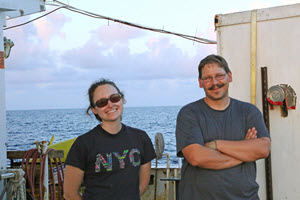
Kelsey Rogers worked alongside marine technician Jason Agnich to collect water and sediment samples from the Gulf of Mexico. (Photo provided by Professor Joseph Montoya, Georgia Institute of Technology)
The camaraderie among ECOGIG members has helped Kelsey develop professional friendships that will support her throughout her career. “I’ve met so many great people on these research cruises,” she said. “Everyone is so gung-ho about working together and helping one another. It’s a wonderful community.”
Kelsey’s advisor, Jeff Chanton, has taught her to go where her interests take her and not feel limited by her chosen field. Involved in many diverse projects himself, Chanton has shown Kelsey that oceanography skills are transferable to other subjects that strike her interest.
“With Jeff as my advisor, I don’t feel like I’m pigeonholed,” she explained. “He’s taught me you don’t have to do just one thing for your entire career—you can be creative.”
Her Future
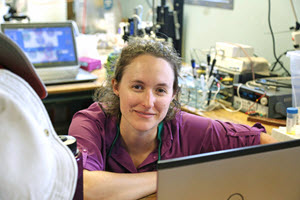
Kelsey Rogers spent many hours processing samples in R/V Endeavor’s main lab. (Photo provided by Professor Joseph Montoya, Georgia Institute of Technology)
Kelsey expects to finish her Ph.D. in late 2017 or early 2018. Feeling drawn to an industry or government position, she wants to provide the most help in a future event, though she clarifies that might not be mitigation. “I don’t really want to do cleanup,” she said. “I want to get ahead of the problem.” She suggests finding ways to make exploration safer or helping to craft government environmental policies as possibilities.
Wherever she winds up, Kelsey believes all the steps along her journey are necessary and meaningful: “I started out as a beaker cleaner in the lab. But those beakers need to be absolutely sterile for the experiments to be valid. All the jobs in science are important.”
Praise for Kelsey
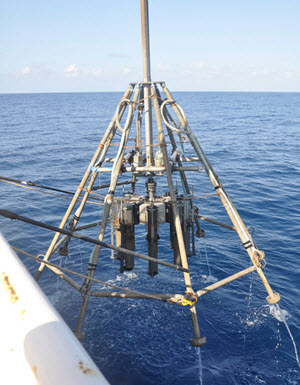
Researchers use a multi-corer to collect sediment samples in the Gulf of Mexico. (Photo provided by Kelsey Rogers)
Chanton said Kelsey has boundless energy and is undaunted by difficult tasks. Her great attitude has led to a leadership role in the Thalassic society, FSU’s graduate school organization. A Thalassic project manager, she sits on the executive committee and assists the president and vice president in organizing and running different functions throughout the year.
“Kelsey has a can-do approach that is contagious,” Chanton said. “On the ECOGIG cruises, she never rests. When her own work is completed, she surveys the deck to see who needs a hand with theirs.”
Chanton said that in addition to field missions, Kelsey also shines at outreach events where she is engaging and patient when explaining her work. He said she can make complex topics as simple as they need to be depending on the audience, and her natural confidence puts people at ease.
The GoMRI community embraces bright and dedicated students like Kelsey Rogers and their important contributions. The GoMRI Scholars Program recognizes graduate students whose work focuses on GoMRI-funded projects and builds community for the next generation of ocean science professionals.
Visit the ECOGIG website to learn more about their work.
************
This research was made possible in part by a grant from The Gulf of Mexico Research Initiative (GoMRI). The GoMRI is a 10-year independent research program established to study the effect, and the potential associated impact, of hydrocarbon releases on the environment and public health, as well as to develop improved spill mitigation, oil detection, characterization and remediation technologies. An independent and academic 20-member Research Board makes the funding and research direction decisions to ensure the intellectual quality, effectiveness and academic independence of the GoMRI research. All research data, findings and publications will be made publicly available. The program was established through a $500 million financial commitment from BP. For more information, visit http://gulfresearchinitiative.org/.
Fact Sheets: Sea Grant Publishes Deepwater Horizon FAQ and Beached Oil Brochure
The Sea Grant Oil Spill Outreach team released two new brochures that discuss Deepwater Horizon and beached oil.
 Top 5 Frequently Asked Questions about the Deepwater Horizon Oil Spill: Five years after the incident, tourists to the Gulf of Mexico still have questions about the oil spill. This publication addresses how the oil was cleaned up, where the oil moved in the environment, and the ecological and health impacts of the spill.
Top 5 Frequently Asked Questions about the Deepwater Horizon Oil Spill: Five years after the incident, tourists to the Gulf of Mexico still have questions about the oil spill. This publication addresses how the oil was cleaned up, where the oil moved in the environment, and the ecological and health impacts of the spill.
Navigating Shifting Sands: Oil on our Beaches : This publication highlights how oil from the Deepwater Horizon oil spill was buried, how it moves around, and how scientists track oil.
: This publication highlights how oil from the Deepwater Horizon oil spill was buried, how it moves around, and how scientists track oil.
Video: Deep Sea Amphipod
Deep sea amphipod! Here we have a video of a deep sea amphipod! Amphipods are interesting little creatures! They are considered crustaceans. This amphipod species uses its large claws to prey on zooplankton, jellies, and siphonophores. The amphipod not only eats these creatures, but collects resources from them to build the barrel we see. The barrel we are referring to is the gelatinous portion around the amphipod! The barrel turns into the amphipod’s home and provides protection and camouflage! This is also where the idea for the movie Alien came from! Pretty sweet, huh?
Posted by DEEPEND_gom on Tuesday, January 19, 2016






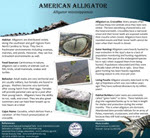
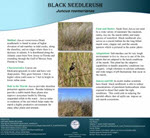


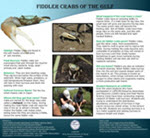
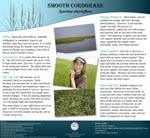
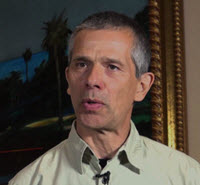

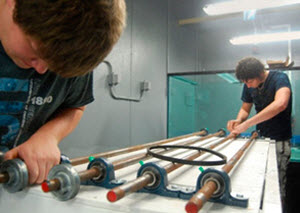


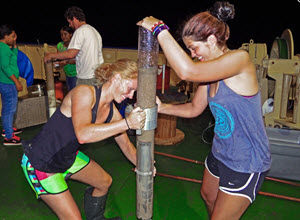
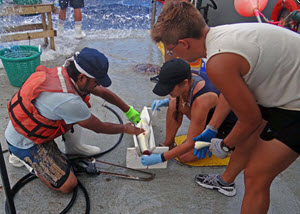
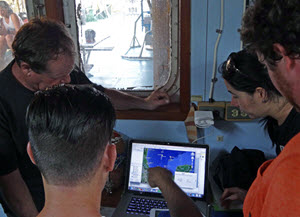
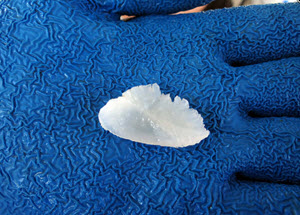
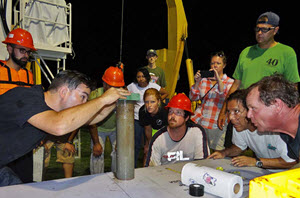
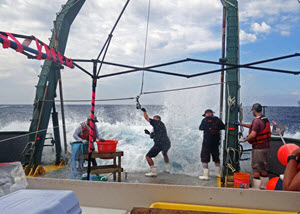
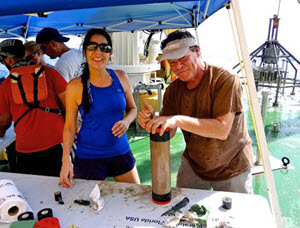

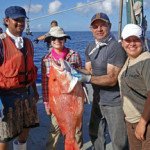
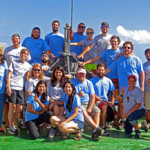
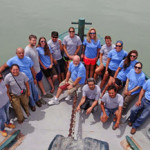
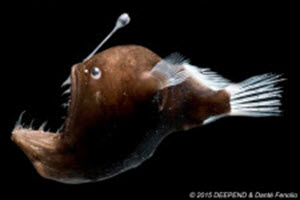
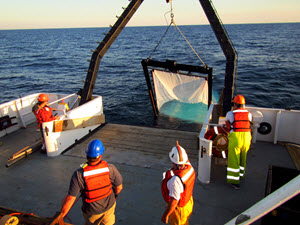

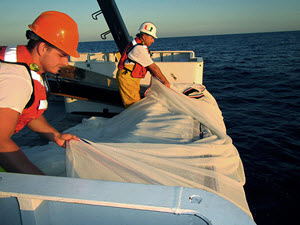
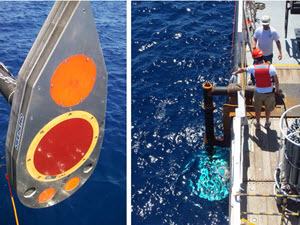
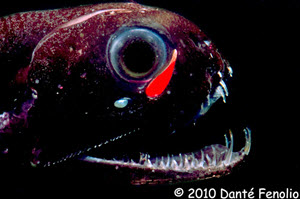
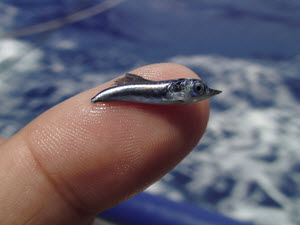
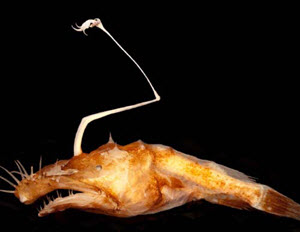
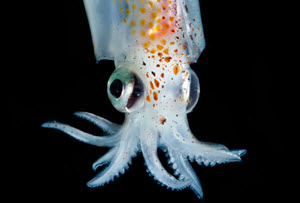


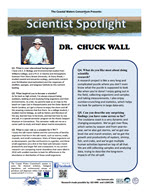

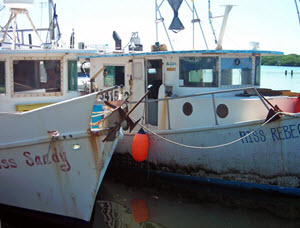

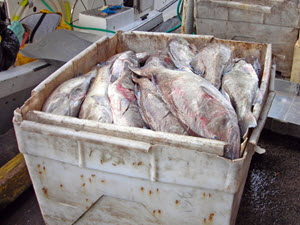
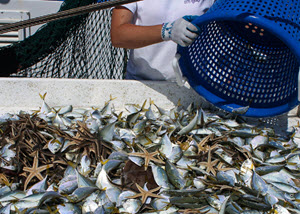
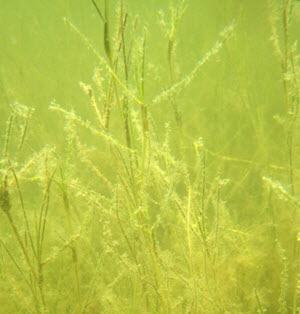
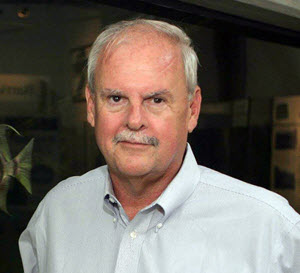
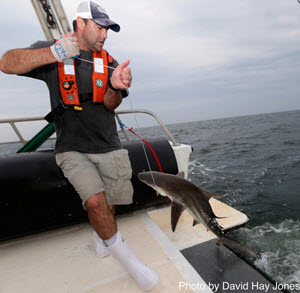
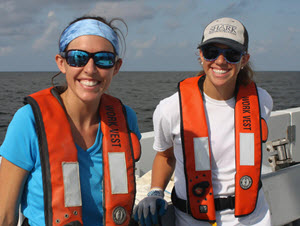
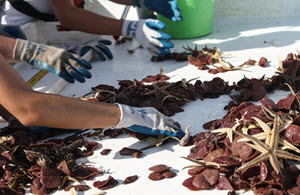
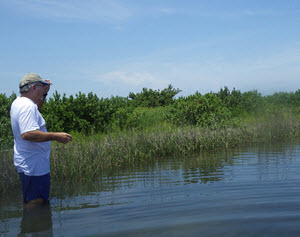

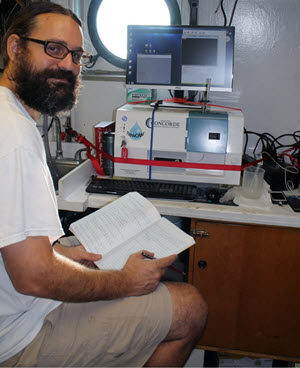

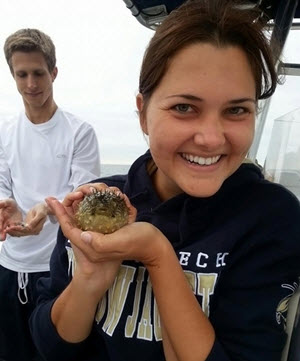


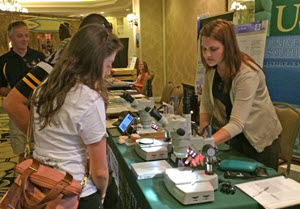
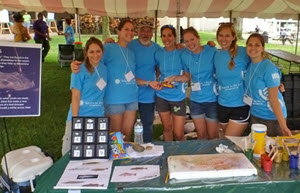
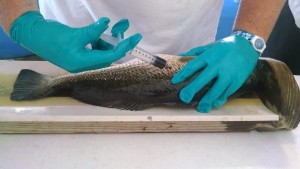 WUSF’s Steve Newborn talks with two scientists who are involved in the study,
WUSF’s Steve Newborn talks with two scientists who are involved in the study, 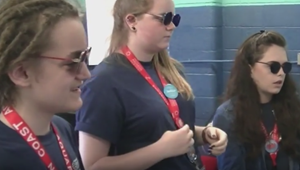


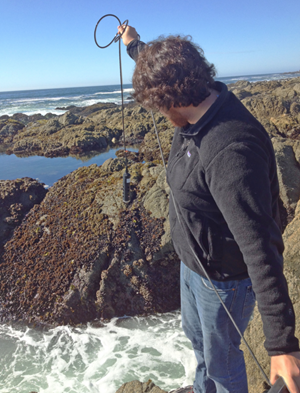

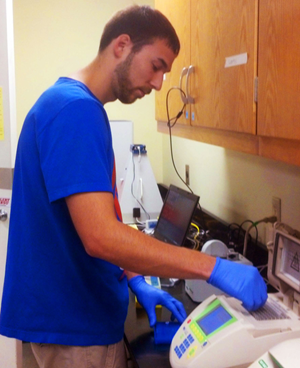
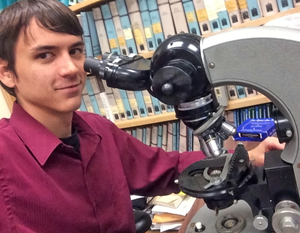
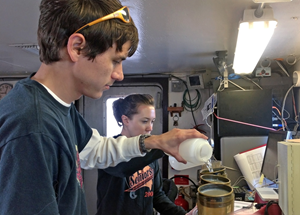

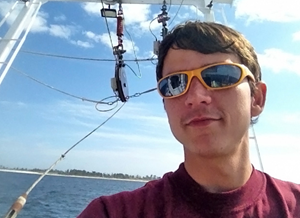
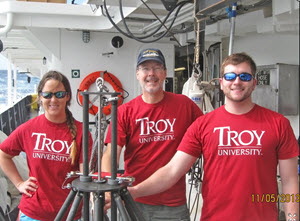
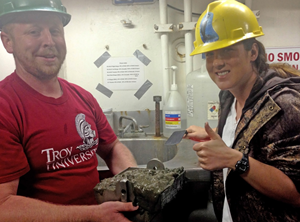
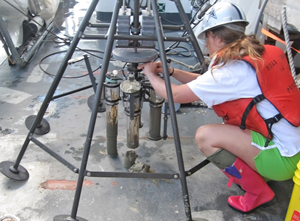
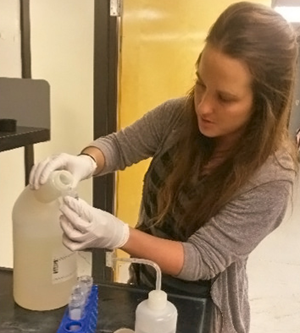
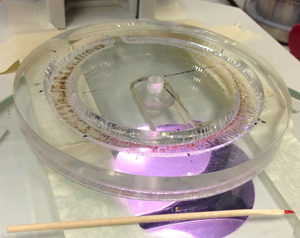
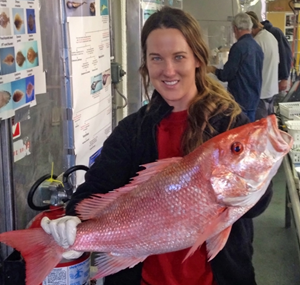
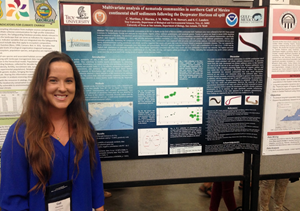
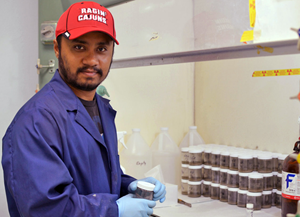
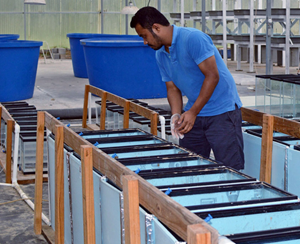

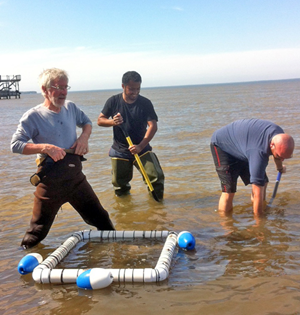

 Dr. Debra Murie
Dr. Debra Murie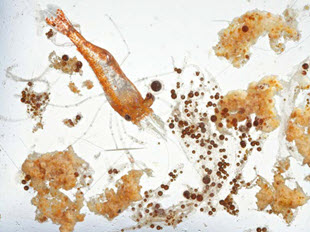 After the Deepwater Horizon incident, the coastline oiling that occurred raised questions about oil movement and impact. For example, before a surface slick reached land, was there oil below the surface waters and how might that affect coastal environments and organisms?
After the Deepwater Horizon incident, the coastline oiling that occurred raised questions about oil movement and impact. For example, before a surface slick reached land, was there oil below the surface waters and how might that affect coastal environments and organisms?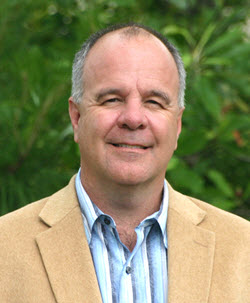


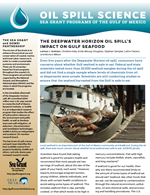
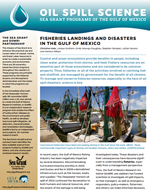
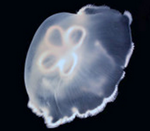 Jellyfish push water in and out of their bells to propel themselves forward. Researchers are investigating if and how the small underwater waves and currents created by Jellyfish movements can help break up oil spilled in marine ecosystems.
Jellyfish push water in and out of their bells to propel themselves forward. Researchers are investigating if and how the small underwater waves and currents created by Jellyfish movements can help break up oil spilled in marine ecosystems.
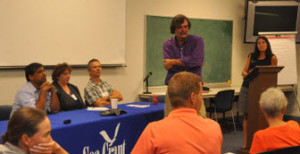 A seminar series by
A seminar series by 








